
Come walking with us!
Selsdon Wood is a wonderful place for a walk whatever time of year. In the spring the ground is carpeted with bluebells. In the summer the lush green leaves keep it shady and cool. Autumn is the time for blackberries, fungi and nuts. And in winter, when it snows the wood is silent and magical.
The Friends regularly hold informative, guided walks to which all are welcome. All our walks are slow and easy – a meander rather than a hike!

|
Map with trails.jpg Size : 344.624 Kb Type : jpg |

Programme for 2025
GUIDED WALKS of DISCOVERY
All our walks are slow and easy – a meander rather than a hike! Meet in Selsdon Wood car park, Old Farleigh Road.
April – Sat 5th 2pm 'Spring Walk' with the Friends
May – Sun 4th 2pm ‘Bluebells and Birds’ with the Friends
June - Sun 22nd 11am ‘Summer Flowers’ with Malcolm Jennings
July - Sat 12th 11am ‘Butterflies’ with Daniel Bound
August - Wed 13th 2pm - ‘Mini-Beast Hunt’ with Roger Hawkins (of interest to children & their adults)
October – Sat 25th 10am - ‘Fungus Hunt’ with the Friends
November – Sat 15th 1pm - Autumn/Winter Trees with the Friends
Fungus Hunt Sat 25 October 2025
report and photos by Ted Forsyth & Ruth Budd
At least 23 people were present including our Italian expert Mario Matucan.
Species seen (N denotes a first sighting for this year)
Car park grass - Yellow Fieldcap N
Greenhill Way - Common Bonnet N, Ivory Woodwax N, Glistening Inkcap, Honey Fungus N, White Fibrecap N, White Fibrecap (lilac form) N, Russula species, Common Puffball N, Clouded Funnel, Hairy Curtain Crust, King Alfred’s Cakes, Buttercap N, Bitter Oysterling N, Twig Parachute N, Shaggy Parasol N
David’s Crook - Parrot Waxcap N, Meadow Waxcap N
Pool Grove - Lumpy Bracket, Turkeytail, Southern Bracket, Honey Fungus, Giant Polypore, Sulphur Tuft, Common Deceiver N
West Gorse – Candlesnuff, Crimped Gill, Yellowing Curtain Crust, Sycamore Tar Spot N, Dead Moll’s Fingers, Dead Man’s Fingers, Crested Coral
Stevens Walk - Clouded Funnels, Common Earthball, Yellow Stagshorn, Glue Crust
Others - Snapping Bonnet, Upright Coral
34 species in total
Sculpture Walk at the Selsdon Community Fair 7th September 2025
report by Neale
Twenty people met Karen and I for the “ Sculpture Walk”. I explained it would be a meander rather than a walk and suggested it would take around an hour. We stopped at the Butterfly Bank giving a quick overview but as we had Valerie with us much interest and explanation of plants ensued.
Mini-beast Hunt Wednesday 13th August 2025
report by Linda - photos by Linda & Kirsty Jefferyes
Many thanks to Roger, Sandra and Graham for their support to me and for identifying the catches for the children.
Approximately 20 children attended, each with their parent/carer. They found a variety of insects etc using the nets and collecting pots we provided. They enjoyed using the magnifying glasses to look at the details of their catches before freeing them to return to the wild. Most of those attending had not been before.We packed up at about 15.30 as thunder was heard and rain threatened but everyone said they had really enjoyed the experience - except one little girl who went home on the first sighting she made within 5 minutes - and it was only a small spider!

This may be the last bat meet Ruth and I lay on as we're relocating to Somerset and need to 'clear the decks' to concentrate on that. Notwithstanding, we've had great fun over these last years enjoying seeing the pleasure 'close encounters of the bat kind' has brought to everyone who's joined us.
Butterflies Walk Saturday 12th July 2025
report by Daniel Bound- photos by Valerie & Ruth (first mention of each species shown in bold)
22 people gathered in the shade in the car park on one or the hottest days of the year, in anticipation of a lepidoptera treat!
This year has been one of the best years for butterflies - finally after years of miserable, damp and rainy weather, we have had long spells of unbroken sunshine, which has allowed for an explosion of butterflies, some emerging 3 weeks earlier than usual! I was a bit worried that some specialist species would have maybe finished, but I shouldn't have been worried at all.
We set off and had a quick look at the Butterfly Bank which had several Gatekeepers flying around, the odd Meadow Brown and Large White flying in the field as we made our way up to Jubilee pond. A Small Copper, always quite difficult to see due to its size, was spotted by Ruth, and Ringlets were also seen, as well as our first Silver Washed Fritillary. We also saw some Cinbar Moth caterpillars near the pond on some Ragwort.
Moving around the field a Holly Blue was doing a good job in showing the difference between it and the Common Blue. We were aiming for the mythical Buddleia bush on The Wend, and while cooling ourselves walking through the woods we added Speckled Wood and Comma to the day's species list.
A Green-veined White was at the start of The Wend, and the Buddleia bush had an amazing array of species... Brimstone, Peacock, large and Small Whites, Commas, Silver Washed Fritillaries and at least 2 Hummingbird Hawk Moths were seen!
We headed up back through the woods to the top of field 4 and the Oak trees which always produce Purple Hairstreak, and several were seen in the canopy with the odd one heading down. A lone Marbled White was seen in the field, it will be not long now till these have gone, and the always a star performer we had a flypast White Admiral, the glide and grace of these butterflies are always lovely to watch.
Heading back to the car park we saw a constant stream of Gatekeepers, Meadow Browns and Ringlets, as well as a Small Skipper which added our final species to the day, an impressive total of 20!
Thanks to Neale and the friends of Selsdon woods and Ruth and Steve for helping but mostly thanks to everyone who turned up on this walk in this wonderful year for the butterfly.
Visit of Pupils from Croydon High School Thursday 3rd July 2025
report by Valerie photo by Kay Ellis
Over 120 schoolgirls visited Selsdon Wood - half in the morning and half in the afternoon. I was there to meet them, to show them the butterfly bank and to talk about the work of the Friends and what we do to encourage biodiversity.
The first aim of FSW is "To ensure that Selsdon wood is maintained for the benefit of the flora and fauna so that no one species shall threaten the survival of another .."
To that end we have:
* removed Laurel, an invasive species, which would threaten the survival of other plants
* renewed and built ponds for threatened species like frogs and newts
* created a bird feeding station with feeders and bird friendly plants (i.e. Teasels etc) to support a diversity of birds
* improved our butterfly bank, which formerly had only a few species which were already growing in Selsdon Wood, so that it now has 46 species all valuable for butterflies and pollinators.
I then moved onto pointing out specific biodiversity successes on our bank:
* Yellow Kidney Vetch (small blue eggs laid)
* Horseshoe Vetch flourishing (only food source for the caterpillars of two blue butterflies)
* Dwarf Thistles flowering (vital for caterpillars of Painted Lady butterfly).
I pointed out the Cornflowers and told the students that when I was a child every grain field was full of Cornflowers. Now, because use of herbicides, the Cornflower is an endangered species but we have four on our bank.
On the Butterfly Bank we have a QR code which gives access to an identification guide for the flowers there. The afternoon group had loaded the QR code on their phones before coming so I could point to different plants and see which student could first identify it using the guide. It worked well. I have also prepared a quiz about the flowers which I sent to the school. The accompanying teacher, Rachael Conrad, said the children would be doing this later when back in the classroom.
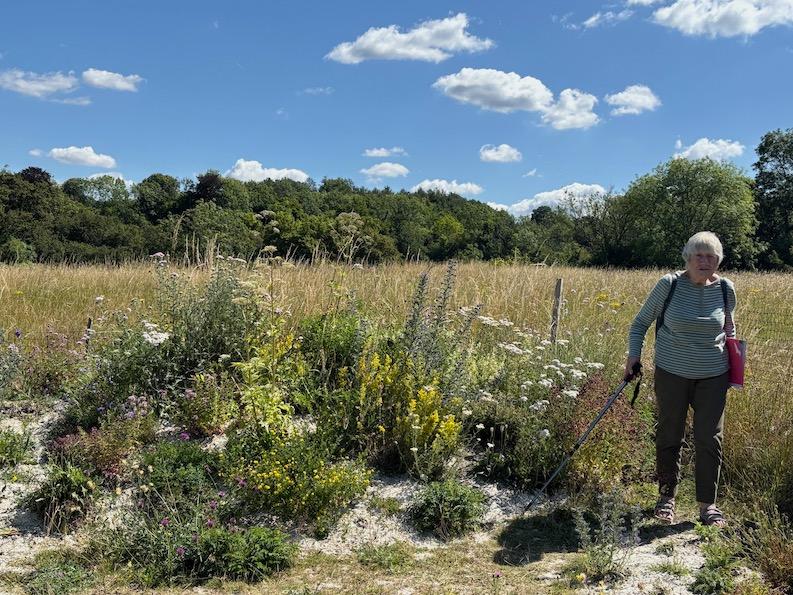
Summer Flowers Walk Sunday 22nd June 2025
report by Ted- photos by Neale & Ted
Under the leadership of Malcolm Jennings 14 people set off along Vale Border. We crossed field 2 to pass through the trees to field 3 and continued to reach the far side where we turned up to the top of the field, turning back towards the car park. A brief stop was made at the Butterfly Bank to admire Valerie’s planting.
Sightings throughout the walk are listed below and several of them are shown in the photographs
Butterflies: Red Admiral, Meadow Brown, Ringlet, Marbled White, Small Copper
Grasses: Wall Barley, Cocksfoot, Rye Grass, Quaking Grass, Wood Mellick
Trees & Bushes: Apple, Turkey Oak, Elder, Bullace, Hornbeam, Red Osier Dogwood
Flowers: Bindweed, Goatsbeard, Nettle, Oxeye Daisy, Daisy, Traveller's Joy (Old Man's Beard), Hogweed, White Clover, Red Clover, Pineapple Mayweed, Birdsfoot Trefoil, Scabious, Field Buttercup, Greater Yellow Rattle, Pyramidal Orchid, Hedge Bedstraw, Wild Carrot, Knapweed, Ragwort, Agrimony
report by Linda
Attendees included a family with two young children who had been on our walks and Mini Beast Hunts before. I think all the others were regulars too - apart from the editor of the Selsdon Gazette, Chris Jones, who came as an SRA rep. I don’t think any of the attendees were there because they had been encouraged by the SRA Centenary Exhibition and posters, sadly, though.
Bat Walk for Scouts - Wednesday 14th May 2025
Report from Chris Green & photos from Alan WickendenBirds & Bluebells Walk Sun 4th May 2025
Report & photo from Ted Forsyth
Led by Neale & Karen, a group of about 25 began with a brief look at the Butterfly Bank then carried on to pick up Ted at the Bird Feeding station. In the cold and overcast weather there were no birds on the feeders. Noting the Cowslips in the field, we crossed to the cut-through to David’s Crook, where looking for the Lizard on the log pile was unsuccessful. In Bluebell Grove we found Yellow Archangel, and there were still enough flowering Bluebells to produce occasional wafts of scent. A Blackbird, Robin, and Chiffchaff produced a few notes and we had earlier detected Magpie, Woodpigeon, and Stock Dove. Leafy Grove took us to look at the Owl sculptures (see photo) then The Wend led us to Beech Grove where the potential Marsh Tit nest box was pointed out. Continuing on this track with many noisy Carrion Crows amongst the tree tops, we turned into Avis Grove to pass briefly through Great Field to get to Field 3. Noting the Whitebeam and the flowering Red-Osier Dogwood in the edge of the tree belt, we passed through into Field 2 and continued back to the car park.
7 species of bird were heard.

Dawn Chorus Walk Saturday 19th April 2025
Report & photo from Christopher Green

Spring Walk Saturday 5th April 2025
Report from Neale Fox
We saw the following signs of spring:
Autumn Tree Walk 16 November 2024
Report by Ted Forsyth, photos by Ted and Ruth & Steve Budd.
We began with 13 people but it soon rose to 18.
During my walk across the wood to reach the car park I found Jelly Rot in Leafy Grove, Smoky Bracket in West Gorse and Meadow Waxcap in David’s Crook.
With Heather unable to lead the walk, we started off along Vale Border with a copy of the 2023 route and the list of trees and bushes seen. Many of the leaves had dropped making it difficult to pick out some of the species. Once in Vale Meadow the group began to deviate from the 2023 route; continuing up the meadow until we reached the Elm by the Jubilee Plantation. We then visited the Bird Feeding Station before moving on to David’s Crook. From there we followed a path to Pool Grove and on to Linden Glade. To return to the car park we followed West Gorse and Leafy Grove to see the carved owls then took The Wend to Gt Field where I left the group, leaving them to aim for the car park.
Vale Border Field Maple, Bullace, Spindle, Blackthorn, Turkey Oak, Sycamore, Hazel, Ivy, Elder
Vale Meadow Privet, Wild Rose, Beech, Copper Beech, Buckthorn(?), Wych Elm (Goldcrests here and old Long- tailed Tit nest)
David’s Crook Juniper, Dogwood, Mirabelle Plum, Walnut, Ash, Larch, Pine, Yellow Fieldcap near Pool Grove
Pool Grove Sweet Chestnut, Peeling Oysterling and 3 Southern Brackets
Linden Glade Lime, Corsican Pine, Holly
The Wend Yew
Fungus Hunt Sat 26 October 2024
report by Ted Forsyth
Approximately 36 people were present.
As can be seen from the list below, the participants were very active in Greenhill Way to the extent that there was a chance this would be the only area we explored. With so many eyes to find fungi I was stumbling from one group to another to see what had been found and to offer an ID if someone else had not already done so. Our expert friend was not present this year. Littleheath had a fungus walk at the same time as did Bromley and possibly even the LNHS. The fungi in David's Crook were along the edges of the path. Since the Council had not cut the grass it was not worth trudging across it. The earlier fantastic display of Honey Fungus in Pool Grove had rotted. On a low flat stump someone with very sharp eyes spotted something growing in a very small hole which I IDd as Purple Jellydisc. To return to the car park we walked along West Gorse to The Wend and worked our way down to Stevens Walk to see the Yellow Stagshorn. I pointed people in the direction of the car park and walked home.
In total 26 species were seen today. Those underlined were seen for the first time this year.
Greenhill Way Candlesnuff, King Alfred’s Cakes, Twig Parachutes, Pestle Puffball,
The Deceiver, Common Bonnet, Wolf’s Milk slime mould, Peeling Oysterling, Turkeytail,
Clouded Funnel, Oak Curtain Crust, Common Puffball, Stump Puffball, Birch Polypore,
Jelly Ear.
David’s Crook Yellow Fieldcap, Honey Waxcap, Tricholoma sciodes.
Pool Grove Honey Fungus, Southern Bracket, Purple Jellydisc.
The Wend Common Inkcap, Sulphur Tuft, Elder Whitewash, Common Earthball.
Stevens Walk Yellow Stagshorn.

Minibeast Hunt Wednesday 14th August 2024
We had a great Minibeast Hunt this year, in contrast to the poorly attended event of 2023.
There were 18 children present, most of Primary School age and all with accompanying adults. Our guest leader as usual was Roger Hawkins with Heather, Sandra and Linda helping out.
Roger introduced the event and we equipped the children with nets, magnifiers and collecting pots before setting off up the edges of the field in the long grass. It was interesting to see that, for the first time, several of the children brought along their own lenses and collecting nets.
As usual the children could hear the sounds made by the crickets - sounds inaudible to us adults. All they had to do then was ferret them out from the undergrowth.
When the children found creatures of interest they were taken to Roger for identification. His knowledge and enthusiasm rubbed off on the children as he put names to what they had found.
Many of the snails were found high up on the stems of the Hogweed plants, apparently a result of the very wet weather earlier in the year.
In excess of 20 species were identified including:
Roesel's Bush Cricket; Speckled Bush Cricket; Southern Oak Bush Cricket; Meadow Grasshopper (female); 7-spot Ladybird; Black & Yellow Longhorn Beetle (Rutpela Maculata); Dock Bug (Coreus marginatus); Honey Bee; Garden Snail; Brown-lipped Snail: various Spiders, Harvestmen, Grass Bugs, and Ground Bugs; Meadow Brown Butterfly; Gatekeeper Butterfly; Six-spot Burnet Moth; Straw Dot Moth; a Plume Moth.
Photos by Linda Morris and Kirsty Jefferyes



Butterfly Walk Sat 29 June 2024
report by Ted Forsyth
There were nine people on the walk led by Daniel Bound.
Butterfly breeding success is dependent upon the weather conditions experienced during the year. In 2023 there were periods of heavy rain but the very high summer temperatures broke records resulting in reduced feeding opportunities as the flowers and grasses shrivelled in the heat. This tends to show up in the following year with reduced numbers of some butterfly species. Daniel’s transect results for the early part of 2024 seem to bear this out. Though we did not see vast numbers of individuals or species today, there is still a chance for better results later in the year.
FIELD 1. Meadow Browns began to appear as we walked up to the top of the field where a young lady was sitting practising on her cello.
FIELD 2. There were more Meadow Browns in this field as we walked towards David’s Crook.
DAVID’S CROOK. In addition to more Meadow Browns, we now had several sightings of Marbled Whites and a Large Skipper.
POOL GROVE. This was a productive area with a Red Admiral, Comma and a very active White Admiral.
WEST GORSE. Ringlets and two more White Admirals were spotted here.
LEAFY GROVE. More Ringlets and White Admirals kept the photographers busy, and a male Brimstone fluttered by. As we continued along Leafy Grove we were intrigued by a small Buddleia in flower on the right of the path.
GREAT FIELD. As we walked along the short leg of this field we watched the undulating flight of a Green Woodpecker. Meadow Browns an a Comma were seen. The discarded skins of growing Peacock caterpillars were seen in the hedge.
FIELD 3. A Large Skipper and a Small Heath, with more Meadow Browns were noted as we passed through the tree belt into Field 2 where a trio of Marbled Whites completed our list. Then the group split up and went their separate ways. On the way back Neale Fox spotted and photographed a Common Blue.
Total Species list: Meadow Brown; Marbled White; Large Skipper; Red Admiral; Comma; White Admiral; Ringlet; Brimstone; Peacock (caterpillars); Small Heath; Common Blue
11 species seen today
Photos by Ruth Budd and Neale Fox
Summer Flowers Walk Sunday 23rd June 2024
report by Ted Forsyth - photos by Karen Hall, Paola Bagnall, Chris Green & Heather Govier
15 people were on the walk led by Malcolm Jennings
Field 1 Comfrey and Wall Barley were noted on the car park bund before we began moving along Vale Border. Flowering Nettle and Goosegrass (Cleavers) were visible at the base of the Sloe and Bullace bushes. In the hedgerow, presumably originating from a discarded apple, a large Apple tree was laden with ripening fruit. The nationally rare Greater Yellow Rattle produced a widely scattered display of its yellow flowers which were already producing ripening seeds. Ox-eye daisies were almost equally abundant. Bird’sfoot Trefoil grew in patches amongst the grasses – two of which were identified as Rye Grass and Cocksfoot Grass. In the hedge a Turkey Oak was pointed out and an Elder was covered in flowers. Small Pyramidal Orchids could be confused with the Red Clover which was present, as was White Clover, but the larger specimens made it obvious where the "pyramidal" name came from.
A leaf plucked from a Field Maple was coated in a large number of tiny Red Pustule Galls as we followed the path through the tree belt, noting the seeding plants of Garlic Mustard and the flowers of Herb Robert. As we exited the tree belt we passed the only definite specimen of Buckthorn of which we are aware, though I would be surprised if Brimstone butterflies had not found others on which to lay their eggs.
Field 2 Many of the same species were repeated in this field but several additional species were identified, often of minute size. Tiny white Mouse-ear and Fairy Flax were found. Black Medick and the rather similar Hop Trefoil were also seen. Field Scabious was present where the only butterflies of the day, Meadow Browns, flitted amongst the grasses and a few GoatsBeard seed heads.
The next tree belt had Wild Privet, Hornbeam, Ash, Whitebeam and Red-Osier Dogwood.
Field 3 Here we saw Sweet Vernal-grass (smelling of new-mown hay or coconut), Bramble flowers, and Hogweed.
Great Field New sightings here included a group of Peacock butterfly caterpillars, Wood Dock, Common Spotted Orchids, Crested Dog’s tail grass, and Grass-leaved Chickweed.
On the way back the group passed the Butterfly Bank which was covered in much Kidney Vetch and had areas of new planting.
17th & 19th June 2024 - Visit of Croydon High students
reports by Ted - photo by Linda
17/6/24 - My buses got me to the car park by 10.30am where I sat on the seat for 20 minutes before wandering up to the butterfly bank. The Kidney Vetch has certainly put on a fantastic display!
The school party appeared from the direction of the car park and a young teacher came over - there were two older teachers as well. I explained about having Covid and we got the girls to collect at a safe distance.
I talked about the vetch and Small Blues and mentioned a few other butterflies. As they were standing in a mass of Greater Yellow Rattle that got a mention too. I identified a few of the flowers on the bank.
Questions - When do the butterflies appear?, What is your favourite place in Selsdon Wood? (BB or Feeding station), and a couple of others.
They were then let loose to explore with their apps and a map on their phones.
I left just before 11.30am and was extremely lucky with 433 and 353, getting home just after 12 noon.
19/6/24 - As I sat on the seat in the car park I saw Valerie arrive, then as I set off to join her at the butterfly bank I was joined by Linda. It was not long before the second group of schoolgirls this week appeared by the butterfly bank led by teacher Harriet Howgego and accompanied by the head of biology.
After I had said a few words about Greater Yellow Rattle, butterflies and flowers I invited Valerie to say something about her work on the bank. We also directed the students to look at our website to see how the bank was created. Linda also added her expertise and pointed out the Pyramidal Orchids in the field.
As before, the students were then allowed to disperse throughout the woods to find and identify as much biodiversity as possible. I believe there is a competition involved!
Linda & Valerie went to examine Linden Glade while I returned to the bus stop, but not before asking the teachers to let us know if the girls found anything of particular interest. I did mention a mini-beast hunt where one hunter was determined to catch a cricket – he marched into the grass and came back with a Roesel’s Bush Cricket which he had detected by sound (which I could not hear!).

Bluebells & Birds Walk Sunday 5th May 2024
Report by Neale Fox
We met at the car park as usual, a few familiar faces and quite a few new ones. We counted twenty one adults and one happy little girl with her family which along with us made twenty five. Ted waited at the top of the hill for us.
We walked up to the butterfly bank for a look at Valerie's work then met Ted and went to the bird feeding station which sadly only had a single Robin around although we heard a Nuthatch along with the usual Great Tits and a Chiffchaff. Then up to David's Crook where we checked for lizards and into Bluebell Grove. The Bluebells although past their best were still carpeting the ground with colour and giving off a lovely fragrance.
Exiting into Leafy Grove we looked at the owl carving and then went through Middle Gorse and, although it was muddy, up to the green man carving in Farleigh Border. We headed back to the pool for a look at mainly Linda's work on the planting.
Then we walked back along Pool Grove and across David's Crook to the car park.
Throughout the route Karen was pointing out various plants with Michael assisting. Ted was highlighting birds along with my bird app alerting us to bird calls (mostly correct). There were too many ring neck parakeets though!
Everyone had enjoyed the walk with lots of interesting conversations on all subjects en route.
Birds heard or seen on today’s walk - Ted Forsyth
In Field 1 - while waiting for the group I recorded Carrion Crow, Magpie, Woodpigeon, Great Tit, Starling, Jackdaw, Blackbird, Ring-necked Parakeet.
At Bird Feeding Station - Nuthatch and Robin
In David’s Crook - Carrion Crow and Blackcap
In Bluebell Grove - Robin and Stock Dove
In Middle Gorse - Chiffchaff and Wren
While waiting for the group to return from the Green Man a Tawny Owl called from the direction of Linden Glade.
Flowers seen on today’s walk - Karen Fox
We saw the usual plants, Cow Parsley, Bulbous Buttercups, the shoots of the Yellow Rattle coming up, Ground Ivy, Speedwell, Hedge Garlic, Yellow Pimpernel, Yellow Archangel, Bittercress, the odd remaining Wood Anemone and of course Bluebells.
We also saw Rowan and Hawthorn blossom, buds on the Dogwood, Wayfaring Tree and Spindle. The Horseshoe Vetch was flowering on the Butterfly Bank too.
Spring Walk Saturday 6th April 2024
Report by Heather Govier
On a lovely, warm but windy Spring day 17 people joined us for our first guided walk of the year. The paths were especially muddy so we chose a route that avoided the worst conditions. The walk lasted just over an hour and a half.
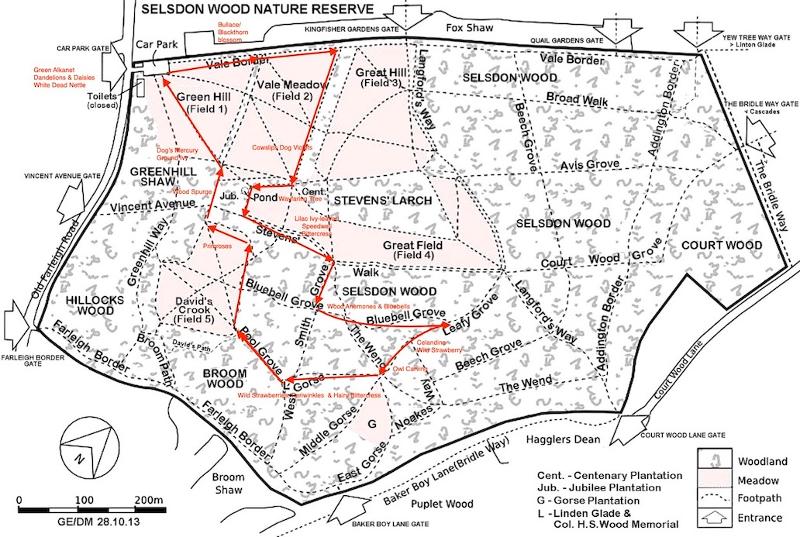
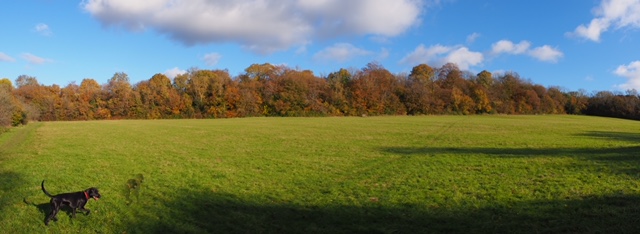
Autumn Tree Walk 11 November 2023
Report by Heather Govier & photos by Neale Fox - above shows the lovely Autumn colours in the field edges.
On a lovely autumn day 15 people joined us for the Tree Walk.
The walk lasted for approximately 2 hours with blue skies and bright sunshine all the way
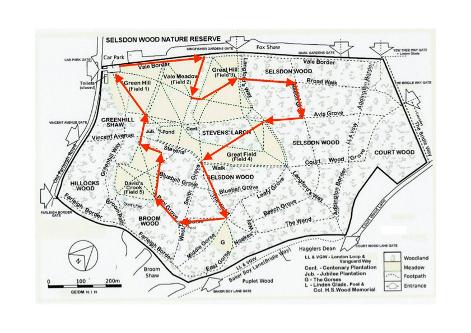
Fungus Walk 28 October 2023
Fifteen of us set off along Greenhill Way at the start of the walk then followed the route as shown on the list below. In view of recent warm and dry conditions, which changed to wetter conditions only during the last week, the species which most surprised me were a single damaged Meadow Waxcap, the Blusher, relatively large numbers of Common Deceiver, Whitelaced Shank and also the missing species we would normally expect to see at this time of the year. The next few weeks could bring more waxcaps, which do appear late in the year along with a few other species which enjoy the same conditions.
The remaining members of the group returned to the car park after we saw the Yellow Stagshorn while I walked home along Langford’s Way and discovered a couple of Magpie Inkcaps.
Greenhill Way Birch Polypore, Horse Mushroom, Twig Parachutes, Russet Toughshank, Common Deceiver
Davids Crook Brownedge Bonnet, Tricholoma sciodes, Meadow Waxcap,
Pool Grove Turkeytail, Lumpy Bracket, Honey Fungus, Oak Pin, Peeling Oysterling, Lilac Fibrecap, Glistening Inkcap, Russula species (white), The Blusher
West Gorse Amethyst Deceiver, Candlesnuff, Beefsteak, Crested Coral, Sulphur Tuft, Brick Tuft, Peeling Oysterling, Blushing Bracket, Whitelaced Shank, Common Deceivers, Bleeding Bonnet, Lilac Bonnet, Rosy Bonnet, Deer Shield, Brown Rollrim, King Alfreds Cakes, Dead Molls Fingers, Yellowing Curtain Crust, Twig Parachutes, Elder Whitewash, Common Bonnet, Angel's Bonnet
Middle Gorse Lilac Bonnet, Stump Fairy Helmets, Rosy Bonnet, Common Funnels, Amethyst Deceivers, Candlesnuff, Sulphur Knight.
The Wend Hazel Bracket, Grass Oysterling (Crepidotus epibryus), Rooting Shank, Deer Shield,Pestle Puffball, Common Puffball(apical pore)
Noakes Way Southern Bracket, Stump Puffballs, Oak Pin, Buttercap, Upright Coral, Common Earthball, Smoky Bracket
Leafy Grove Jelly Rot, Small Stagshorn, Sulphur Tuft, Deer Shield, Blushing Bracket
Bluebell Grove Blueing Bracket, Common Earthball
Stevens Walk Fairy Inkcaps, Yellow Stagshorn
I must record my thanks to Tony Flecchia for his preliminary searching for and identifying fungi in the days immediately before the walk. I also have to thank our friend from LNHS, Mario Maculan, whose sharp eye and rapid identifications substantially added to the enjoyment of the walk.
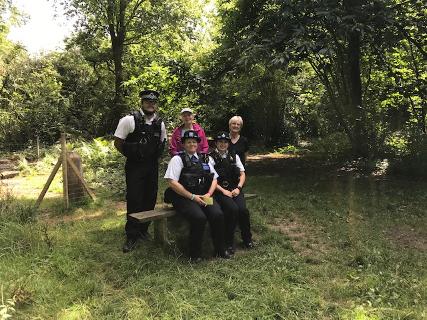
Butterfly Walk 8 July 2023 - photos by Ted Forsyth and Andrew Pelling
In less than favourable conditions, and with a threat of thundery showers, Daniel Bound led a group of 18 on the Butterfly Walk.
The Butterfly Bank was a disappointment but elsewhere in Field 1 produced Meadow Brown, Large White, Marbled White and Small Skipper*. Crossing the corner of Field 2 we entered David’s Crook where we found more Marbled Whites and added Large Skipper and Gatekeeper. Via Pool Grove and Linden Glade we followed West Gorse and saw many Ringlets which were the most numerous species seen during the walk. In The Wend there was another Meadow Brown, a definite Essex Skipper* and more Ringlets. On the route back to the car park we saw a Red Admiral in Great Field.
In three places during the walk we felt raindrops but nothing developed until after the walk when quite heavy rain fell during the walk home across the woods requiring the use of an umbrella
In Langford’s Way I found two Deer Shield mushrooms and when I bent down to photograph them a Tawny Owl called behind me.
* These species seen for the first time this year.
Flower walk Sunday 25 June 2023 11am - photos by Linda Morris and Neale Fox
Nineteen persons braved the very hot weather to join Malcolm Jennings’ flower walk. We began on Vale Border with the inevitable Wall Barley, followed rapidly by Nettle, Meadow Foxtail, Hogweed and Goosegrass. In the hedge of mainly Bullace we found a small Bramble in flower then came upon a large flowering Elder and a Field Maple. In several places we saw Meadow Brown and Marbled White Butterflies. Field 2 produced Herb Robert, Field Bindweed, Greater Yellow Rattle, Field Scabious, Bulbous Buttercup, Knapweed, Pyramidal Orchid and a Hawkweed species. Having reached the next tree belt we identified Hornbeam and Wild Privet before entering the trees where we identified Wood Mellick grass. In Field 3 we added Red Osier Dogwood, Whitebeam, Goatsbeard, Perforate St John’s Wort, Selfheal, Dog Rose and Meadow Buttercup. Passing through the edge of Centenary Plantation we paused to identify both Sessile and Pedunculate Oaks. As we passed back into Field 2 we added Wayfaring Tree and Turkey Oak. We followed the Jubilee Plantation fence round to David’s Crook adding Wych Elm, Wood Avens (Herb Bennet) and Sorrel. In David’s Crook we noted the slightly sorry looking state of the Juniper saplings we planted, failed to see any Common Lizards on the log pile, but found a young Sweet Chestnut. Youngish Field Maples were showing Needle Galls on the leaves while the sloes on the Blackthorn seemed to be largely affected by the fungus which distorts the sloes and produces Pocket Plum Galls. The path across towards Greenhill Way produced a small Bird’sfoot Trefoil and amongst the trees we added Enchanters Nightshade and a group of Sulphur Tuft fungi. Finally on the walk back to the car park Michael picked up the remains of a (Lesser?) Stag Beetle.
(20 flowers and 14 trees seen)
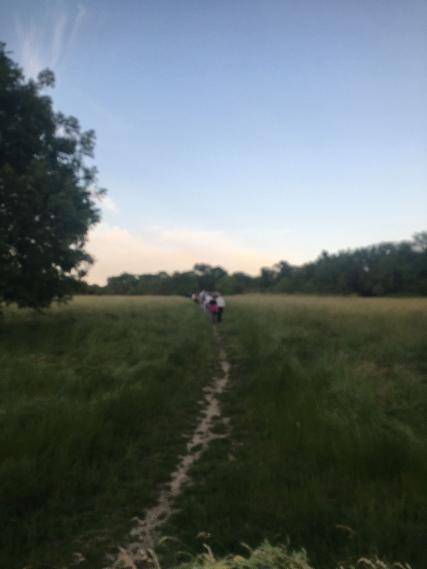
Summer Solstice Dawn Walk 17th June 2023 with Chris Green report and photos by Chris Green
Faithful few for the Summer Solstice Dawn walk this morning. We’d run this one as it had been requested following the first dawn walk so it was a little surprising to have so few of us. However, it’s always good to be out at this time and the woods don’t disappoint.
We started out by walking up through David’s Gorse to Farleigh Border; cut down West Gorse to the Cairn and then along Leafy Grove, down to Beech grove and back along the field edges to the car park.
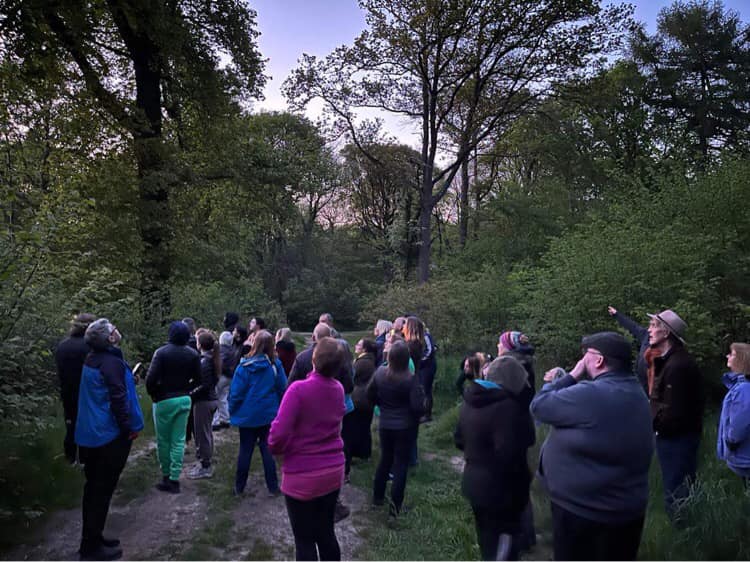
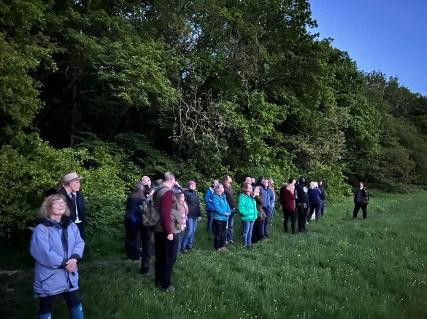
Bluebells & Birds Walk Sunday 7th May 2023
Neale & Karen led a group of 18 people towards the Bird Feeding Station, on the way picking up Ted who had been watching a flock of Jackdaws feeding in Field 2. There was no activity on the feeders so we moved on to Stevens Walk, noting in Great Field the Dandelions, Cowslips, Bulbous Buttercups and a small sprig of Greater Yellow Rattle not yet in flower. A clump of Wild Arum was beginning to show the spathe which leads to some of its common names – Cuckoo Pint, Jack in the Pulpit, Lords & Ladies. Once into David’s Crook we congregated near the lizard log pile where a Common Lizard was happily sunning itself near the end of one log. We noted that one of the unprotected Juniper saplings appeared to have been nibbled or otherwise damaged. Bulbous & Meadow Buttercups covered the grass of David’s Crook. Neale & at least one other person had the Merlin Bird ID app on their mobile phones and Neale certainly made frequent use of his, starting with ID of Robin, Wren and Blackbird before we entered Bluebell Grove. We were at last in Bluebell territory and they did not disappoint, appearing in most of the paths we followed. A few Wood Anemones were visible as were occasional white Bluebells. A Ring-necked Parakeet flew through the wood. We followed The Wend past more Wood Anemones then turned left into Leafy Grove where Speckled Wood and Holly Blue butterflies were seen. A large clump of Garlic Mustard was visible but neither of the butterflies which prefer it – Orange Tip and Small White. The walk continued via Noakes Way and Beech Grove to reach Courtwood Grove, past many more Wood Anemones – there was also a small group of Peeling Oysterlings on the end of a fallen branch. Both Great Spotted & Green Woodpeckers were heard. We continued on Beech Grove then turned left on to Avis Grove which led us to Great Field and Stevens Larch. Within Stevens Larch we admired a very large Wild Cherry with a huge trunk stretching straight up to the canopy. Emerging into Great Field we immediately had a Brimstone flying round us and Magpies and a Carrion Crow put in an appearance. We ended the walk by trudging back to the car park.
Using the Merlin bird sound detection app these birds were detected by their calls (bold for those not mentioned in the report above): Blue Tit, Blackbird, Robin, Parakeet, Grey Wagtail, Great Spotted Woodpecker, Long-tailed Tit, Chiffchaff, Great Tit, Wood Pigeon, Crow, Tree Creeper, Mallard (probably flying over).
Thus 17 bird species detected in total.
Dawn Chorus Walk 6th May 2023 with Chris Green photos by Chris Green & Steve Budd
Inspired by the International Dawn Chorus Day, the Friends gathered in the pre-dawn light of the car park at 5am for the inaugural Dawn Chorus walk. This walk saw us make our way through various locations in the wood, including Jubilee pond, Leafy Grove, Beech Grove and then back to the main three fields on a 2-mile amble that allowed us to really tune into and appreciate the early morning call of our resident birds. And boy did they put on a show! We were treated to an orchestra of song including the early risers of the Blackbird, Wren and Robin, through to the laughter of the Green Woodpecker, the happiness of the Blackcap and the busyness of the Blue Tit. Our highlight had to be the Cuckoo, heard near the main pond and delighting many with its rare call in the wood.
Other reported sightings were Roe Deer in West Gorse & the Jubilee and a Rabbit in Field 1.
Spring Walk 8th April 2023 with Neale & Karen Fox photos by Neale Fox, Steve Budd & Karen Hall
The walk was led by Karen & Neale Fox. We began by pointing out the Laurel hedge in the car park and the flowering Blackthorn along Vale Border then the party of twenty people moved on to look at the butterfly bank where the only plant in flower was a Coltsfoot.
For most of the route we followed one used by Heather on a previous Spring Walk in 2019.
As we crossed field 1 there were several Dandelions in flower. At the cut through to field 2 we found Red Dead Nettle and the leaves of Cow Parsley, Hogweed, Wild Arum and Goosegrass. Passing a seat with a planted clump of Daffodils, we stopped by the bird feeding station where the only visible bird was a Blue Tit but we also noticed that a recently installed bird box is already being used and recorded Bramble, Dogs Mercury and Common Dock and noted the Flag Iris in the pond. Turning left by the hedge we saw Cowslips in the field, Ash with its black buds in the hedge, and at the end we found a Wayfaring Tree. A Brimstone butterfly flew by. Turning back into field 2 there were Dog Rose, Dog Violets, Wild Privet, Ivy, Hawthorn & Holly before we passed through the tree belt by the badger sett and came out into field 3 by a Hornbeam with the Red Osier Dogwood looking striking along the hedgerow.
A diagonal path took us to Broad Walk where Wood Anemones were immediately obvious with the odd Bluebell at intervals. We turned into Beech Grove and soon recorded Cherry Blossom, Goldilocks Buttercup and Carrion Crow. On the ends of several short logs were groups of Peeling Oysterling fungi while thin vertical stems were covered in what are believed to be Birch Mazegill fungi. Someone spotted a Treecreeper on its way up the trunk and branches of a tree.
We crossed Langford’s Way and continued on Beech grove where we found a small Horse Chestnut before we reached the junction with Noakes Way. Here we diverted from Heather’s previous route and turned right to reach Leafy Grove then carried on along West Gorse to reach Linden Glade. Here we heard a singing Stock Dove, and added Lime tree, Wild Garlic, Periwinkle, Comma butterfly, Lesser Celandine, Hedge Woundwort and Germander Speedwell. Pool Grove led us into David’s Crook, but not before we had spotted Southern Bracket fungi on tree stumps. By the four planted Junipers was a scattered collection of St George’s Mushrooms. On the edge of the trees were several clumps of Primroses and Sycamores were visible amongst the trees. Karen Hall showed us a photograph she had just taken of a Common Lizard, the first record since FSW was founded though there is a pre-1978 record. In the cut through towards Jubilee Plantation a Scarlet Elfcup was found on a small mound of moss under a straggly Hazel. Finally, a couple of Magpies were seen on the way back to the car park.
We also learnt quite a lot about Primroses and Dandelion Clocks from one of our group which was very interesting. Everyone seemed to enjoy themselves and we did manage without Heather our usual guide, although the pre-walk information Heather provided was very much appreciated.

|
Tree Walk 2022.pdf Size : 72.172 Kb Type : pdf |
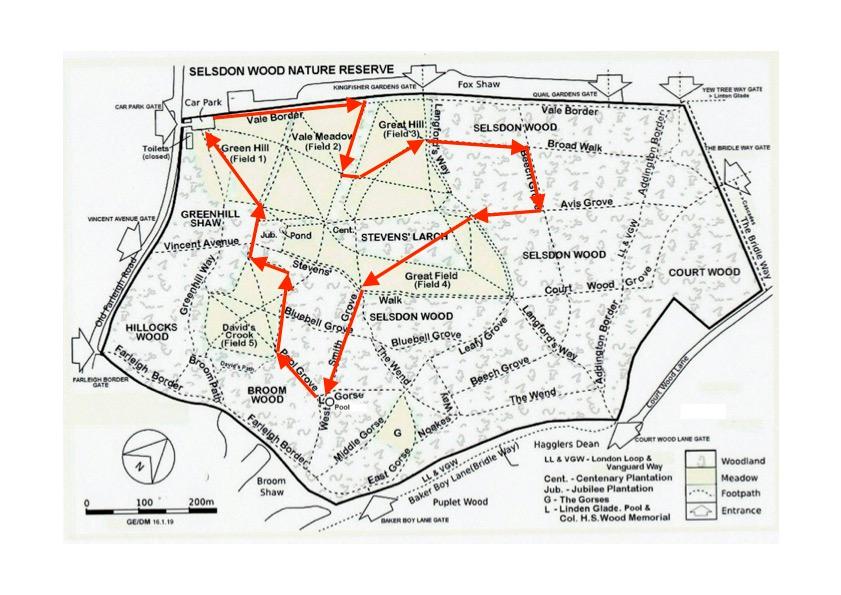
Fungus Walk Saturday 29th October with Ted Forsyth & Tony Flecchia
An extraordinary 47 people attended the Fungus Hunt - including a number of children. The weather was lovely - very warm for the time of year with intermittent sun.
Ted led the group up Greenhill Way and along Steven's Walk where they met up with Tony.
The walk continued past the corner of Steven's Larch, along Leafy Grove, Noakes Way, Beech Grove and The Wend where it ended at 12.30pm leaving the group to return to the car park in their own time.
A total of 46 species of fungi were seen! And also a frog:-)
In Greenhill Way - Birch Polypore, Sycamore Tarspot
In Stevens Walk - Chicken of the Woods, Iodine Bonnets, Parasol, Hairy Curtain Crust, Jelly Ear, Willow Shield, Fairy Inkcaps, Velvet shank, Common Bonnet, Glistening Inkcaps, Yellow Stagshorn, Southern Brackets, Candlesnuff, Blushing Brackets
At the Corner of Stevens Larch - White Knights
In Leafy Grove - Crimped Gill, Crested Coral, Twig Parachutes, Honey Fungus, Variable Oysterling, Sulphur Tuft, Glistening Inkcap, Bleeding Broadleaf Crust, Turkeytail (black), Sheathed Woodtuft, Small Stagshorn
In Noakes Way - Smoky Bracket, Upright Coral, OakPin, Hazel Bracket, Beefsteak (Old)
In Beech Grove - Wood Blewit, Deer shield, Macrolepiota konradii (Parasol type), Sulphur Tuft, Pestle Puffball
In The Wend - Winter Polypore, Crested Coral, Glistening Inkcaps, Fairy Inkcaps, Elder Whitewash
In Leafy Grove - Common Stump Brittlestem
In The Wend - Giant Polypores, Clouded Funnel, Common Funnels, King Alfred’s Cakes, Stump Puffballs, Willow Shield, Hymenochaetopsis corrugata (white resupinate), Redleg Toughshank
photos below by Ruth Budd & Tony Flecchia
- Green Shieldbug, found by children
- Orange Ladybird - one larva beaten from hazel
- Orange Ladybird - adult
- 16-spot Ladybird, one adult found by children among cut grass
- Common Earwig, adult male and female found by children under cut grass
- Common Striped Woodlouse Philoscia muscorum, adult male and female found by children under cut grass
- Tiny spider (male Pachygnatha degeeri) found by children among cut grass
- Daddy Long-legs Spider (female Pholcus phalangioides) in ladies’ toilet
- Crambid moth Agriphila tristella
- Ypsolophid moth Ypsolopha sequella
Butterfly Walk Saturday 9 July 2022 photos by Neale Fox & Dan Bound
24 people led by Daniel Bound began, under overcast skies, by looking at the Butterfly Bank where a solitary Large White was seen. At the top of the car park field there were Ringlets, Meadow Browns, Small White, Gatekeeper, and Small Skippers. In Field 2 a bank of bramble provided Comma, Common Blue and a Silver-washed Fritillary.
Continuing to follow Daniel’s transect route, we entered David’s Crook, as the sun put in an appearance and remained with us for the remainder of the walk. Here we added Large Skippers, Marbled White and White Admiral to the tally. Pool Grove provided better views of Comma, Red Admiral, Silver-washed Fritillary and White Admiral.
In West Gorse the photographers got to work with a Ringlet before we turned off to follow The Wend. Speckled Wood was the only new species. Trudging up Langford’s Way, we reached the short leg of Great Field where Daniel quickly pointed out Purple Hairstreaks flitting around the Oak trees, sometimes at very low levels. A Gatekeeper was found then an addition to the final total came with the appearance of a Brimstone.
(17 species in total.)
Flower walk Sunday 5 June 2022 photos by Neale Fox & Ted Forsyth
Sixteen people joined the beginning of the walk which was led by Malcolm Jennings. On the car park bund there were three clumps of Comfrey in full flower to start us off. Wall Barley, Shepherd's Purse and White Clover were added before a new patch of Sainfoin was pointed out and a couple of grasses, Cocksfoot and Red Fescue, were identified. Following quickly on were Black Medick, Red Clover, Oxeye Daisy, Bulbous Buttercup, Greater Yellow Rattle, and a very small specimen of Birdsfoot Trefoil. On the near side of the second tree belt we identified Common Dogwood and on the far side we had Red Osier Dogwood.
Continuing up towards Great Field we added Dog Rose, Germander Speedwell, Cow Parsley, flowering Bramble, Hornbeam and Hawksbeard. Turning left in Great Field, we paused to identify Sessile Oak and Blackthorn. Before entering Leafy Grove we added Common Sorrel, Goatsbeard, Yorkshire Fog, Crested Dogstail, Wood Dock and Herb Bennet. Honeysuckle, Sweet Chestnut, Wood Sage, Broadleaved Willowherb, Bittersweet (Woody Nightshade) and Hedge Woundwort were soon encountered and many small patches of still-flowering Bluebells were seen though most were displaying seed capsules. The path was covered with scattered groups of Rats’-tail Plantain while along the edge of the path there were occasional small patches of Yellow Pimpernel, Figwort and Enchanters Nightshade. A solitary clump of Raspberry was recorded before we reached the end of Leafy Grove.
We continued on along West Gorse, through Linden Glade and down through David's Crook, spotting flowering Stinging Nettles and Sanicle in the cut through to F2. We diverted to take a look at the Bird Feeding Station where we saw the usual tits and squirrels and a single Nuthatch.
Returning through F1 we stopped off to see the now richly clad Butterfly Bank where we identified: - Viper’s Bugloss, Black Knapweed, Hedge Mustard, Wild Carrot, Common Poppy, Scabious, Weld, Yarrow & Kidney Vetch.
Over 50 species identified.
On the walk home Neale spotted masses of small slugs feeding on the seeds of Cow Parsley and Ted spotted a Slime Mould, Fuligo septica (see photos).
Our thanks to Malcolm for leading the walk:-)
Several of us had to walk home across the fields, hearing singing Dunnock and Collared Dove in Field 2, and in Great Field where we sat for a brief rest, we were startled to hear the loud ‘yaffle’ of a Green Woodpecker immediately behind us in Stevens Larch. Someone noticed a bird on the ground, bobbing its head up and down as it appeared to be eating something. When Neale walked closer to investigate the bird eventually took off and revealed itself to be another Green Woodpecker. Another Song Thrush was heard then, at the top of Langford’s Way, both Blackcap and Great Spotted Woodpecker were heard.
Spring Walk 2nd April 2022 with Heather Govier photos by Neale Fox
The walk was joined by 21 people and, following Heather’s lead, left the car park field to meander past the David Malins Memorial Bird Feeding Station, through Great Field then through Stevens’ Larch. We made a brief stop at the entrance to Avis Grove then continued along Avis Grove and up along Addington Border to Court Wood Grove. At the top we followed Stevens’ Walk until we reached the path through to David’s Crook. There we walked down the northern edge of the field turning right at the bottom and following the path to get back to Field 1. There we made a brief stop at the Butterfly Bank before returning to the car park.
TREES & BUSHES: Blackthorn, Bullace, Ash, Oak, Scots Pine, Larch, Wild Cherry, Oregon Grape, Norway Spruce, Yew, Holly, Laurel, Mirabelle Plum, Hawthorn, Hazel, Elm
FLOWERS: Dandelion, Daisy, Cow Parsley, Daffodil, Cowslip, Bluebell, Periwinkle, Wood Anemone, Wood Spurge, Lesser Celandine, Ivy-leaved Speedwell, Primrose (yellow & pink)
BIRDS (mostly heard): Blue Tit, Great Tit, Nuthatch, Carrion Crow, Ring-necked Parakeet, Robin

Crossing F3 on the diagonal path we reached the opposite hedgerow. The Common Dogwood here is less showy with purple twigs and black berries. We entered the north wood and followed the paths Broad Walk, Beech Grove and then back along Court Wood Grove. The dominant tree in this part of the wood is English Oak with its distinctive leaves. The under-storey is dominated by coppiced Hazel. At the junction of Beech Grove and Avis Grove we spotted a large clump of Honey Fungus dusted with a Sclerotinia mould. In Beech Grove are two massive Yews which once formed part of the Addington Boundary. There is also a large Cherry identified by its shiny, flaking bark with horizontal striations.
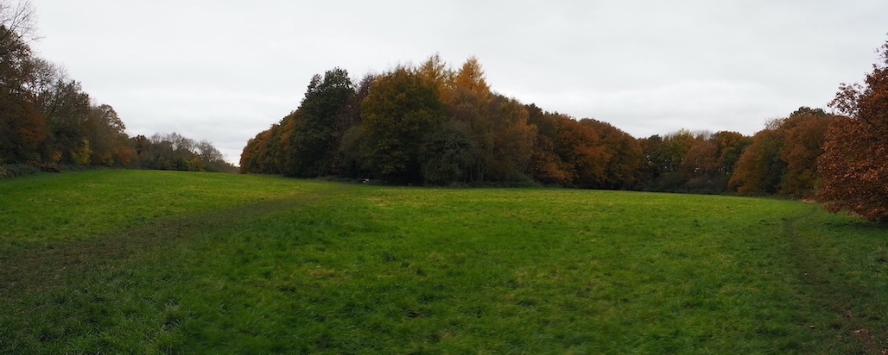
We entered the Great Field and looked across to spot the Larches in Steve's Larch. Larch is the only conifer found in Britain that is not evergreen - it sheds its needles each autumn. But in Steven's Larch there are some evergreen conifers, Scots Pines, and also three other evergreens Holly, Laurel and Yew. Laurel is dispersed throughout Selsdon Wood being most common in the northern section. However it is less widespread than it was as the Friends of Selsdon Wood are working to control or eradicate it. Laurel is a Mediterranean species, probably introduced into Court Wood to give cover for game birds. It is spreading steadily by suckering, layering and seeding and it is inhibiting the growth of other plants, poisoning the ground beneath it.
We walked along the edge of Great Field and noted the huge Oak across the field which is one of the largest in the wood. Turning into Smith Grove we saw the large Hawthorn which is always one of the first to flower in the Springtime. There are a number of Sweet Chestnuts in Smith Grove. These have grey bark with a deep, latticed pattern that often appears to have been twisted round.
At the end of Smith Grove we crossed into Linden Glade. The name for this comes from the 6 Lime (or Linden) trees that form an arc around the rock pile. These have distinctive heart shaped leaves. Behind the Limes are two very tall Larch trees where you may be lucky enough to spot or hear a Tawny Owl, as there is a roost a little further into the wood behind the glade. In Linden Glade we also noted the large Holly that is especially resplendent with berries this year. Holly is dioecious which means that there are separate male and female plants with only the females producing berries. Beside it are two evergreen Corsican Pines which drop cones in the Autumn. There we also spotted some large Common Funnel fungi.
We walked down Pool Grove and on entering David's Crook we noted a single White Poplar behind a large patch of bracken. Although the tree was bare there were some of its distinctive white backed leaves scattered on the grass. The bark is silvery grey with distinctive diamond shaped markings known as rhomboid lenticels. We followed the path along the eastern side noting the Blackthorn hedge with some sloes still showing in the upper branches. We also spotted the Scots Pine in the hedgerow ahead of us.
We cut through into the Great Field again and walked along part of the northern border where we saw Spindle with its remarkable pink and orange berries on our way towards The Jubilee Plantation. This was planted in 1977 by the Croydon Girl Guide Association in commemoration of the Queen’s Silver Jubilee. In 2012 the Brownies/Guides planted a further 60 trees to plant to commemorate the Queen's Diamond Jubilee.
To the left of the path by the Jubilee is one of the few Elms in Selsdon Wood - identifiable at this time of year by the pitted appearance of the bark and a few remaining scalloped leaves. As we walked back towards the car park we noted Sycamore leaves on the ground with fungal black spots and we looked at the Butterfly Bank still full of flowers even so late in the year.
We parted beside the Butterfly Bank after a 2 hour walk, thankful that the afternoon had stayed dry for us!
(There were 28 species seen and the first mention of each is coloured green above. There is a total of 40 species of tree/bush to be found in Selsdon Wood - see the Trees page of the website for details.)
Fungus Walk 30 October 2021 with Ted Forsyth
Twenty hardy souls gathered in the car park all dressed to deal with the expected rain showers. Despite the forecast, we met no rain showers and even had a period of bright sun. We began on Greenhill Way with a Birch Polypore on a fallen tree at the entrance to the wood. Near the top of the path we left the path to see Lumpy Bracket, Split Porecrust and scores of both King Alfred’s Cakes and Stump Puffballs. Vigilant eyes discovered Willow Shield, Bonnet Caps and Common Puffballs before we turned a corner to enter David’s Crook.
Yellow Fieldcaps in all stages of growth were soon being found but my day was made when we started finding waxcaps. Meadow and Parrot Waxcaps were identified but red and yellow specimens were left unidentified. On entering Stevens Walk we immediately discovered a large number of Common Funnels among the trees. Further up the path we added Turkeytail, Yellow Stagshorn, Smoky Bracket and Clouded Funnel. The Wend provided a small Yellow Stagshorn, Beefsteak, Snowy Disco and Common Earthball.
Moving on to Smith Grove gave us Sulphur Tuft and Glistening Inkcaps. Crossing Linden Glade to West Gorse we looked at Hazel Bracket and Leafy Brain. Young eyes spotted another Leafy Brain at the base of a small tree by the edge of the path and Beech Jellydisc and Amethyst Deceivers among the trees. On a pile of sycamore logs I pointed out two clumps of Dead Moll’s Fingers then was shown an even bigger clump at the back. Also on the logs was a display of Yellowing Curtain Crust.
There was an unexpected surprise in Middle Gorse when a group of Upright Coral fungi was discovered. Later a Beech branch held Beech Jellydisc but also a somewhat similar Peziza micropus. In the grassy part of the path behind a seat there was a collection of Twig Parachutes. Along to Noakes Way to see the Upright Coral discovered by Heather behind a tree while she was litter picking, there were also Amethyst Deceivers there.
Before turning into Beech Grove we saw two small Southern Brackets and in Beech Grove itself we found both the Parasol and the large broken circle of Clouded Funnels to which we had been alerted by Tony Flecchia. At the end of this path were Artists Bracket and Nitrous Bonnet.
One or two people had left the party earlier, now most of the rest went home leaving four of us to complete the walk. Honey Fungus, Peeling Oysterling and Lemon Disco were noted on large tree stumps then we entered Great Field to examine the White Knights growing amongst brambles. Leafy Grove gave us Crimped Gill, Parasol, Sheathed Woodtuft and Small Stagshorn. Returning to the car park via The Wend we ticked off a final Blushing Bracket species.
After the walk some of the unknown fungi were identified giving an ID to the yellow waxcap and adding Milking Bonnet (var nigra), Clustered Bonnet and Hairy Curtain Crust.
The final total appears to be 54 species - see the list below. Shown in red are the first sightings of these species this year.
Photos taken on the walk by Jack Lincoln, Linda Pitkin and Neale Fox

|
Fungus species seen on FSW walk 30 October 2021.pdf Size : 89.31 Kb Type : pdf |
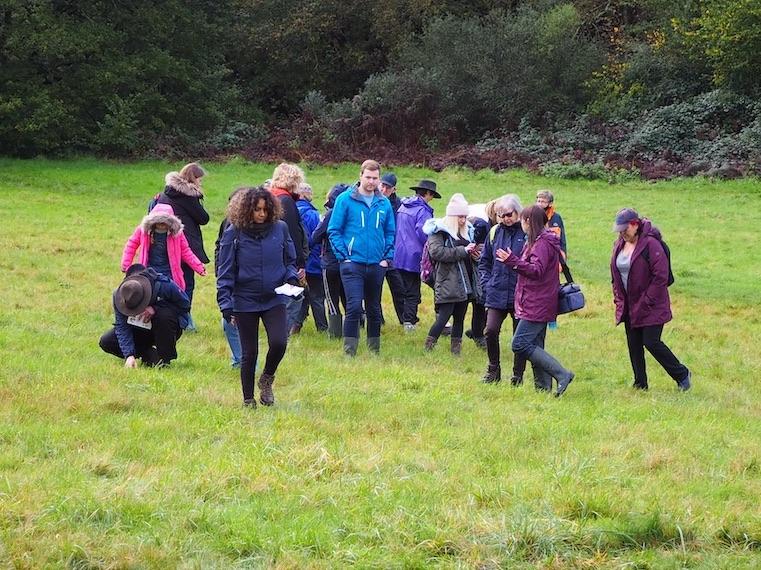
- Butterflies & Moths: Speckled Wood Butterfly, Straw Dot Moth
- Ladybirds: one 7 spot and several 16 spot
- Shieldbugs: Tortoise S, Eurygaster testudinaria (adults & last instar nymph) Green S (nymphs, 4th instar), Bishop's Mitre S, Aelia acuminata
- Grasshoppers: Meadow G (males & females), Common Green G
- Roesel's Bush Cricket (adult male).
- Garden Spider (immature)
- Black tipped Soldier Beetle, Rhagonycha fulva
- Other grass bugs, Stenodeminae & grass moths, Crambinae
- Bees: Buff-tipped Bumblebee
- Harvestman: (not a spider although looks like one) Common & Forked Palped
- Froghopper, Neophilaenus lineatus
- Spiders: Crab Spider
- Ants
- Great Black Slug
- Snails: Various
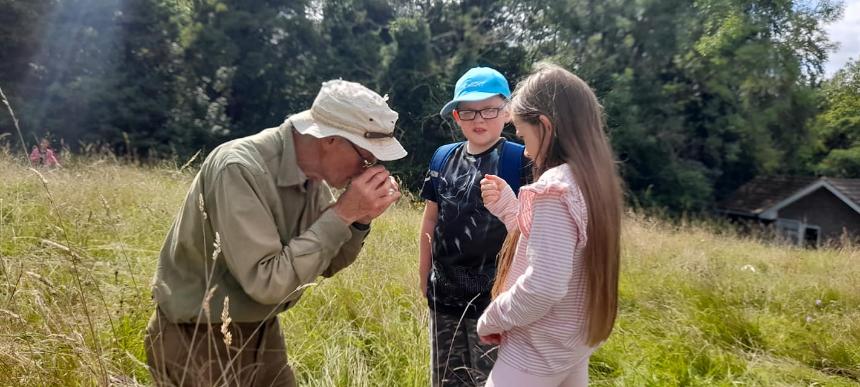
Butterflies with the Friends - Saturday 10th July 11am
On a day when rain showers were expected it was surprising that a dozen of us met for the walk. Daniel Bound, who walks a weekly butterfly transect in the wood, led the walk round part of his transect, starting in the car park field where we saw a single Meadow Brown. By the Jubilee Plantation I pointed out the Wych Elm and Daniel promised to show us the Elm on Vale Border where he has seen White Letter Hairstreak. Moving on to David’s Crook, where walking through the grass disturbed some of the resting butterflies, we saw many more Meadow Browns and added several Marbled Whites and single Small Heath and Brimstone. We carried on to Linden Glade and spent a few minutes hoping for White Admiral and Silver-washed Fritillary but without success. In West Gorse and Leafy Grove we stopped for several minutes to admire and photograph many Ringlets. The remainder of the walk took us down The Wend then along Langford’s Way. Across Great Field, where photos were taken of Peacock caterpillars, then back to the car park via fields 3 and 2, adding a couple more Meadow Browns but no new species. At the end of the car park extension Daniel pointed out the Hairstreak Elm and admitted that he had to spend some time staring at the top of the Elm before catching a glimpse of the butterflies fluttering. It had been a very humid day but at least we had missed the promised showers.
All photos in the gallery below by Neale Fox
Summer Flowers with Malcolm Jennings - Sunday 6th June 11am
5 guests joined Malcolm and 5 FSW members for a very pleasant stroll in bright sunny conditions. (We took details for the 5 guests so that we could contact them should anyone in the group contract Covid.) We started by looking around the car park area where 10 species could be seen, including a large patch of Shepherd's Purse which has developed from a single specimen growing on the soil bund 6 years ago.
We then walked along Vale Border noting all the species in the hedgerow and field. Malcolm showed us how to differentiate the buttercup species by looking at the sepals, which on the Bulbous Buttercup are turned downwards. Cutting through into Field 2, we took a diagonal path up the field. We saw much Greater Yellow Rattle just beginning to show. This plant is very rare in GB and Croydon has the majority of it. It is a good plant for promoting a diverse flower culture as it parasitises the grass allowing more species to grow. We also discussed the small white flowers that were widespread. Malcolm and Heather believed these to be Lesser Stitchwort but both Heather and Linda had apps on their phone which said they were Mouse-ear. Later research proved the apps to be right!! The flowers of Lesser Stitchwort have petals more deeply divided than those of the Mouse-ear and Lesser Stitchwort is found primarily on acid soils.
At the top of the path we turned to the left to visit a clump of Sainfoin - the only known occurrence in the wood. This may be a garden escapee or may be a remnant from when the fields were farmed as Sainfoin is grown as a fodder crop. Returning to the path we cut through the wooded strip to Field 3 noting several flowering trees/bushes, Privet, Hornbeam, Whitebeam and Red-Osier Dogwood. Within the wooded strip we hunted for White Helleborines, which we knew to have grown there in the past, and we were delighted to find several specimens.
We walked to the top of the field and beside the Centenary Plantation through to Great Field. We looked at the flowering Holly beside the path and noted that many of the leaves seemed thornless. It has been suggested that Holly only produces prickly leaves low down where they discourage browsing. The bough we were looking at appeared to be low lying but on inspection cold be seen to be a very long branch which was bent low. Walking down towards the Jubilee Pond we looked at the curious Spindle flowers and the now fading flowers of the Wayfaring Tree.
We walked up the field from the pond noting Dog Rose in flower and back in an easterly direction to the cut through to David's Crook where we noted the giant Dryad's Saddle. Along the southern edge of David's Crook we found Cinquefoil and Wild Strawberries with both flowers and fruit on them. The Mirabelle Plum was also laden with fruit.
Returning to Field 1 we took the diagonal path back to the car park, stopping on the way to inspect the butterfly bank, which is now showing a bit more green after recent rain.
Many thanks to Malcolm and to all FSW members who contributed to the discussions. We hope our guests enjoyed the walk and look forward to seeing them again in future now that covid restrictions are lifting.
The following species were identified on the walk:
Wild Flowers (42) - Birds-foot Trefoil; Black Medick; Bramble; Buttercup (Bulbous); Buttercup (Creeping); Buttercup (Meadow); Cinquefoil: Clover (Red); Clover (White); Cow Parsley; Daisy (Common); Daisy (Ox-eye); Dandelion; Dock; Dog's Mercury; Dog Rose; Garlic Mustard; Goose Grass; Greater Yellow Rattle; Green Alkanet; Ground Ivy; Hawkweed; Hedge Mustard: Herb Bennett; Herb Robert; Hogweed; Knapweed; Marjoram; Mouse-ear; Nettle (Common); Old Man’s Beard; Plantain (Greater); Plantain (Ribwort); Sainfoin; Sanicle; Shepherds Purse; Speedwell (Germander); Sorrel (Common); Sow Thistle; White Helleborine; White Dead Nettle; Wild Strawberry; Yellow Archangel.
Trees & Bushes in flower (11) - Dogwood (Common); Dogwood (Red Osier); Elder; Field Maple; Holly; Hornbeam; Privet; Spindle; Sycamore; Wayfaring Tree; Whitebeam.
Grasses in Flower (4) - Cocksfoot; Rye Grass; Wall Barley; Wood Melick.
All photos in the gallery below by Neale Fox
Autumn Trees and Fungi Walk - Saturday 2nd November 2019 photos below by Tony Flecchia
Led by Tony & Ted with Linda, Neale and Karen
Eleven people were in the group who managed to find a dry period between showers. We began in Greenhill Way looking at some of the species which Tony and I had found over the last couple of days, including Jelly Ear, Bonnets, Oysterlings and White Knights but the sharp eyes of the others soon added new species such as Green Elfcup, Twig Parachutes and a Crested Coral fungus by a fallen tree trunk. As we moved into Davids Crook I mentioned waxcaps which had been seen recently, and had vanished, but we spread out in the hope that others had appeared. We were not disappointed. Meadow Waxcaps and Parrot Waxcaps were found and groups of unusual Puffballs which later were discovered not to have a common name. In Pool Grove Common Puffballs and Shaggy ScalyCaps were at the base of a multi-stemmed tree, due for removal during winter tree work, and we found a group of spots originally thought to be Coral Spot but when examined closely were seen to be yellow (now identified as Nectria peziza, Yellow Spot). The sharp eyes picked out another coral fungus on the path, possibly a new species, and groups of Clouded Funnels off the path. From Linden Glade a stroll along West Gorse produced, among others; Turkeytail, Sulphur Tuft, Yellowing Curtain Crust, Smoky Bracket, Dead Mans Fingers, Witches Butter and Crystal Brain. Turning back through Linden Glade we continued along Smith Grove where Safrondrop and Common Bonnets were on a tree stump and at the other end of the path Split Porecrust, Common Earthball, Common Funnels and Frosted Funnels. The base of a nearby tree was completely encircled by a huge display of Sulphur Tuft. In Stevens Walk we were able to see the remains of the Dryads Saddle which had made such a magnificent display twice earlier in the year. In Great Field I again mentioned previous findings of waxcaps and again something was found – Snowy Waxcap and Blue Roundhead. When all the IDs have been sorted out a list will be published below. Amongst them are 3 species new to us this yearAs the original intention for the walk was to look at autumn fruits and leaves we did point out the Spindle berries in Greenhill Way and the berry display on the female Holly in Linden Glade. In Davids Crook a white slime mould was found in the grass, probably the white version of Fuligo septica.
The full list is included below.

|
6:11:19 Walk List in English Name order.pdf Size : 26.368 Kb Type : pdf |
23 people attended on a fine clear evening.
A huge thank you to Neale and his partner for taking what was a healthy turn out of lovely folks up to Leafy Grove to watch the Common Pips massacre the local midge population, while Ruth and I set up camp near the entrance to Greenhill Way.
A hand out, with some broad information about Selsdon’s bats, joining the Friends and what to do if you find a grounded bat was distributed.
With the group reconvened and seated we had a fine time watching the iPad display as a Common Pip hawked over and around us.
A Leisler made a single pass, temporarily breaking up the Pip traffic but the highlight for those that hung it out until 9.14pm was a Myotis (Mouse Eared) bat that showed up in Greenhill Shaw in the 1.5 to 2 hour window after sunset when we usually find it. We’re certain it wasn’t a Natterer, as the calls didn’t drop quite low enough. That leaves Whiskered, Brandt’s or Bechstein’s as the likely candidates and we’ll examine other evidence later to try and pin it down further.
There were plenty of questions, along with bat related dialogue, that was enjoyable and entertaining to field. We’d bought fluorescent bat stickers for the kids but regrettably my empty head failed to pack them - next time...
Thanks again to all who attended.
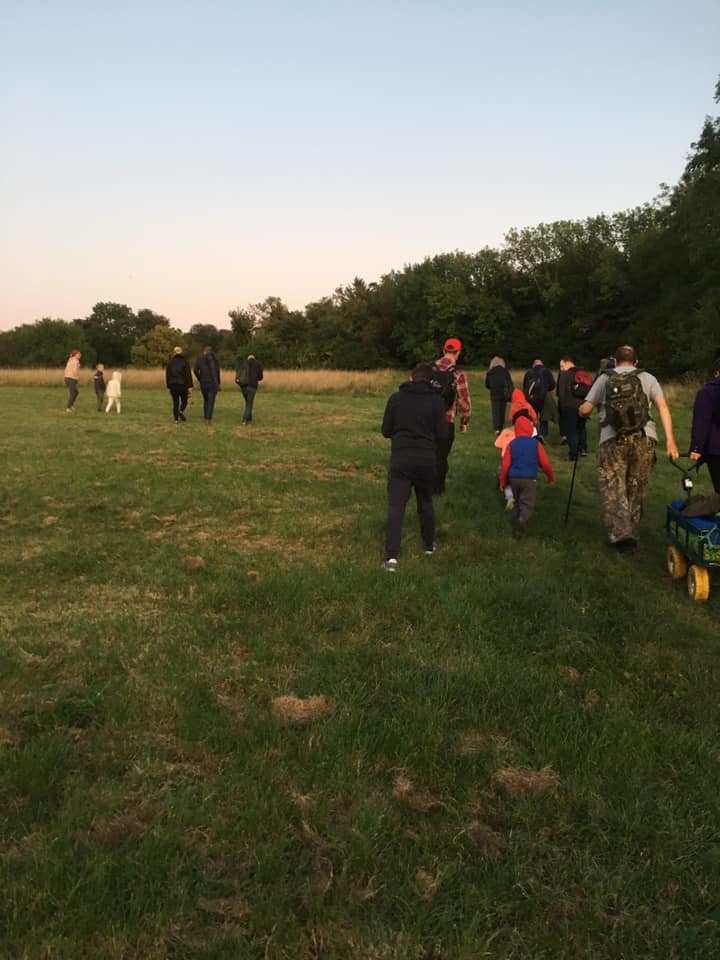
- Butterflies: Gatekeeper, Common Blue, Meadow Brown, Ringlet
- Ladybirds: 7 spot, 16 spot , 24 spot
- Female Southern Hawker Dragonfly
- Shieldbugs : Green, Forest /red-legged, Sloe/Hairy, Hawthorn ( juvenile/ 3rd stage nymph)
- Meadow Grasshopper - male
- Southern Oak Bush Cricket - This insect was first noted in the UK by Roger in Selsdon Wood about 20 years ago. It has no wings so is also known as the hitch hiker cricket.
- Common Earwig - male
- Other grass bugs, moths
- Bees: Bombus Pascuorum Bumblebee, Bombus ruderarius Bumblebee, Halictus.sp. Solitary Bee
- Harvestman bug ( not a spider although looks like one)
- Garden Snail juveniles.
- Spiders: Garden Cross Spider, Noble False Widow Spider (sting venomous as a honeybee), Running Crab Spider, Xysticus bifasciatus (new species)
- True Bug, Stenodema calcarata (new species)
- Earthworm.
24 people attended the walk. While it was still light Steve Budd talked about bats and recording. Around 9.18pm all but Tony and me left for a most enjoyable and very interesting walk led by Steve. The echoing different electronic devices coming to life every time a bat came close was an exciting almost eerie experience for walkers. The group walked through fields 1, 2 & 3 and into a small part of the wood before returning to the car park where they were hoping for Serotine Bat. Unfortunately, despite Steve’s recent success the only bats detected on the walk were Pipistrelles.
Meanwhile at the moth trap, sited close to the top of the cut grass area in the car park field and close to trees, a few small moths were attracted as the light dwindled. Tony attempted to photograph each species for later identification but we did recognise Brimstone moth, Common Footman, Grass Veneer and an unexpected Ringlet butterfly which insisted on returning to the trap each time it was released. Tony later added IDs of Square-spotted Clay (my initial ID was Double Square Spot), Small Spruce Bell, Dwarf Cream Wave and a Leaf Hopper Cicadellidae sp. The walkers had returned to the trap area around 10.30pm and most left for home before 11.00pm. We dismantled the trap and returned it to the store before leaving the car park and locking the gate behind us.
Summer Butterflies Walk 13th July 2019 - photos below from Ted Forsyth
!2 people on the walk began by finding several Meadow Browns in the car park field before moving through into field 2 and thence to David’s Crook. Unfortunately the Council grasscutters had ripped through the lovely patch of Marjoram where we usually see several butterfly species – this time there were no butterflies on the patch but a few more Meadow Browns flew by. A Ringlet posed on a branch for identification and a Large Skipper was found in the grass and a couple of Marbled Whites were visible. We carried on through Pool Grove and stopped in Linden Glade in hope of seeing some of the larger butterflies. After some time with nothing putting in an appearance I had just suggested moving on when the sun came out. Immediately a White Admiral appeared, then a second one. Karen picked up a leaf with a micro moth which I believe is one of the Tortrix moths – probably Epagoge grotiana (no common name). Continuing along Leafy Grove, we entered The Wend where I pointed out a small reddish blob on a tree stump which appears to be a young Beefsteak fungus. Towards the lower end of The Wend a small Buddleia was sporting a number of flowers and on one there were two feeding Silver-washed Fritillaries. On the route back to the car park there were no new species.
Butterflies: Meadow Brown, Ringlet, Marbled White, Large Skipper, White Admiral, Silver-washed Fritillary
Moths: Tortrix moth – Epagoge grotiana, 6-Spot Burnets.
Fungus: Beefsteak fungus.
Summer Flower Walk on Sunday 16th June - led by Malcolm Jennings - photos below from Neale Fox
About 20 people assembled in the car park on a day with a promise of drizzle. The lower part of the car park field had been cut so most of the flowers had gone but we continued on to Field 2 where conditions were better. Several Pyramidal Orchids were beginning to flower, Oxeye Daisies and Bird’s-foot Trefoil grew amongst the grasses and Hop Trefoil was present on the path. Unfortunately the light drizzle we had been experiencing changed to a heavy downpour and we were soon drenched so we entered the tree belt between Fields 2 & 3 hoping in vain for shelter. Most of us stayed there until the rain subsided then gradually made our way out past the Centenary Plantation, where Karen found a Long-horned Beetle species, and back to the car park – in full sunshine!
Flowers & Grasses: Daisy, Red Clover, White Clover, Goosegrass (Cleavers), Common Nettle, Crested Dog’s Tail grass, Cocksfoot grass, Hop Trefoil, Birds Foot Trefoil, Mousear, Oxeye Daisy, Field Buttercup, Pyramidal Orchid, Greater Yellow Rattle, Bladder Campion, Germander Speedwell, Wood Avens (Herb Bennet), Bramble, Knapweed, Goatsbeard, Ribwort Plantain, Wall Barley.
Trees & Bushes: Dog Rose, Field Maple, Elder, Rowan, Hornbeam, Dogwood.
Insects: Meadow Brown, Cuckoo spit Froghopper, Long-horned Beetle species.
Bluebells and Birds Walk Saturday May 4th - photos below from Neale Fox and Linda Morris
On a day with a biting cold wind and frequent sleety showers around thirty participants turned up including several tiny children. The route took us through Greenhill Way, Bluebell Grove, Leafy Grove, East Gorse, Middle Gorse, West Gorse, Linden Glade, Pool Grove, and back to the car park. We had seen many bluebells on the April walk and had feared that they would not last until today but the cooler weather in the last few weeks had held them at their peak and the show was magnificent today.
I was given the lead and pointed out amazing numbers of leafy Beeches and Rowans, a few plants, and answering quite a few questions. In Linden Glade I showed the waymarker with the QR codes and two young women used their phones to connect to the system and were quite impressed. A young Norway Maple in Greenhill Way was compared it with Sycamore and Field Maple.
Plants & Flowers: Cow Parsley, Daisy, Nettle, male & female Dog’s Mercury, Dandelion, Bulbous Buttercup, Bluebells (Including several white ones), Greater Stitchwort, Toothwort, Yellow Archangel, a single Wild Garlic by the pool (from a seed dropped by Karen), Lesser Periwinkle.
Trees & Bushes: Blackthorn, Beech, Hazel, Oak, Silver Birch, Downy Birch, Sweet Chestnut, Rowan, Holly, Lime, Sycamore, Norway Maple. Flowering Gorse.
Butterflies: A single male Orange Tip.
Birds: Blackbird, Chiffchaff, Blackcap, Robin, Wren, all singing. Jackdaws & Starlings feeding in the car park field. Occasional screeching Ring-necked Parakeets.
Spring Walk with the FSW Saturday April 6th - photos by Neale Fox
About 26 people attended, including three young children. We followed a route chosen by Heather through fields and woods to see the signs of spring.
Flowers: Green Alkanet, Red Dead Nettle, Dandelion, Daisy, Daffodil, Cowslips, Dog Violets, Wood Anemones, Bluebells, Gorse, Wild Strawberries, Periwinkle, Hairy Bittercress, Herb Robert, Goldilocks Buttercup, Celandine, Ground Ivy, Primrose (yellow and pink), Dog’s Mercury.
Trees & bushes: Goat Willow (Pussy Willow), Blackthorn, Bullace, Red Osier Dogwood, Hornbeam, Wayfaring Tree, Hawthorn (in leaf but not yet in flower), Cherry blossom, Horse Chestnut sticky buds, Rowan, Mirabelle Plum, Laurel in flower in car park.
Fungus & Slime Mould: St George’s Mushrooms, False Puffball slime mould, Birch Polypore.
Birds: Chiffchaff, Blackcap, Wren, Mistle Thrush, Song Thrush, Magpie, Robin, Jay, Long-tailed Tit nest in Blackthorn.
On the walk back home we heard a Tawny Owl in Courtwood Grove. I then carried on down Langford’s Way and heard a brief Tawny Owl call near White Squirrel corner. On looking up at the bare tops of the trees I could see a bird moving from branch to branch and realised I had been hearing a Jay imitating an owl.
A guide to the flowers seen and a map of the route taken can be accessed from these links.
Autumn Leaves and Fruits Walk 3rd November
- photos below by Neale Fox
About 30 people attended the walk which passed through fields 1, 2, 3 and Gt Field before entering Leafy Grove, West Gorse, Farleigh Border, David’s Crook and back to the car park. The Yellow Stagshorn fungus had started to re-appear on the conifer stump in West Gorse and Candlesnuff fungus was visible on many mossy logs. However, the most interesting sight of the day was the superb display of pink and orange fruit on the Spindle bush in Field 3 - see photo right by Linda Morris.
Trees, Bushes & Climbers: Ash, Dogwood, Privet, Scots Pine, Copper Beech, Hazel (with catkins), Whitebeam, Beech, Hornbeam, Red Osier Dogwood, Spindle (with a magnificent display of fruits), English Oak, Turkey Oak, Larch, Sycamore (with Tarspot), Holly, Sweet Chestnut, Buddleia, Silver Birch, Yew, Corsican Pine, Small-leaved Lime, Field Maple, Ivy, Wild Cherry, Alder, Blackthorn, White Poplar, Mirabelle Plum, Elder, Elm, Wayfaring Tree, Hawthorn, Wild Clematis (Old Man’s Beard).
Fungi: Yellow Stagshorn, Candlesnuff
In view of the drizzling rain and the later threatened heavy rain Tony and I set off at 10.00am with the two gents who had arrived on time. As we began to move away from the museum with its display of fungus photos we were stopped by a car driver who had appeared with his friend’s bicycle in the boot. He asked if he could store the bike in the museum as we had done on the butterfly walk. We set off again and before getting far across the field we were joined by Linda and two others, making a total of three committee members and six visitors.
Our pre-planned route which Tony and I had walked on Friday began in Stevens Walk where we added a Parasol to our known list, then continued through Langford’s Way, Beech Grove, Noakes Way, The Wend, Bluebell Grove then turned left in David’s Crook to reach Pool Grove. Here the rain increased in intensity. We followed West Gorse to Farleigh border, had a brief look at the beginning of Middle Gorse to see Ochre Brittlegills, then walked along Farleigh Border and down Greenhill Way and back to the car park. A total of 47 species were identified though at least one ID is tentative.

|
2018 Fungi Walk, Final Species List.rtf Size : 2.085 Kb Type : rtf |
Minibeast Hunt - Wednesday 15th August 2018 - photos below by Tony Flecchia, Linda Morris and Karrie Miller
There was a good turnout for the Minibeast Hunt - a total of 43, comprising many childrenwith accompanying adults. Despite the premature grass cut the children soon found a number of grassland insects. Shaking the shrubs and trees was very productive too, dropping out many spiders and insects. We mainly confined ourselves to field one since there were no flowers elsewhere, but despite that two holly blue butterflies were caught and all the children really enjoyed themselves.
Species collected and identified included: Holly Blue Butterfly, Meadow Brown Butterfly, Oak Bush Cricket – one male, Southern Oak Bush cricket one female – first at this site – new to Britain 2001, Long-winged Conehead Cricket, Harlequin Ladybird, Cream spot Ladybird, 16 spot Ladybird, 14 spot Ladybird, Orange Ladybird – one larva, Issus Coleoplextus – a planthopper, also known as Lacehopper, White plume moth, Lasioglossum punctatissimum Halictid Bee, Marmalade Hoverfly, Episyrphus balteatus, European male Earwig, Greenbottle Fly, Microfly, Micromoth Larva, Green Shield bug (final instar nymph), Hairy Shield bug (final instar nymph), Usual grass moths, grass bugs, woodlice, spiders, harvestmen, froghoppers, springtails.
Bat Walk and Moth Trap - Thursday 19th July 2018 - photos below by Tony Flecchia, Ted Forsyth, Linda Morris & Ethan (aged 7)
Tony picked me up at 8.30pm and gave me a lift in his nice new electric car. We were first to reach the empty car park and were soon joined by Karen and Neale. We took the trap into the open grassland beyond the small group of trees and chose a spot to avoid dog poo. The trap was quickly set up in daylight and a group formed around it. I gave my bat detector to Karen – Neale had his own – and the pair led most of the group off to search for bats in Great Field and Leafy Grove. Meanwhile Tony and I were joined by Clive Price from Beckenham who had seen the date mentioned in Great Green Yonder – he has experience operating his own trap and was later able to identify some of the moths which appeared. By 10.00pm the bat group were slowly trickling back. One, Steve Budd, had been operating a detector connected to an Apple iphone which identified the bats detected (see the appendix below for details). As well as the Common Pipistrelles he had also recorded a Serotine Bat. As daylight dwindled and the moths began to approach the trap Tony was kept occupied trying to photograph them and occasionally Clive would offer an ID. At one point a Hornet entered the trap and was thought to have eaten a moth. Seven-year-old Ethan borrowed Tony’s camera and took a photo of the Hornet. We did not collect any moths as the photographs seemed adequate for checking IDs. We eventually dismantled the trap and left the site, locking the gate behind us.
Attendance was 25-30 - including 3 children.
2 species of bats identified: Common Pipistrelles, Serotine
14 insect species identified from the moth trap - see below for photographs:
Caddis Fly Dun-Bar Moth, European Hornet, Flame Shoulder Moth, Green Oak Tortrix Moth, July Highflier Moth, Rove Beetle, Large Emerald Moth, Platytes cerussella Micromoth, Ruby Tiger Moth, Shining Flower Beetle (2 species), Spotted White Plume Moth, Ticheria ekebladella Micromoth
Appendix - I attended yesterday, armed with the very versatile and efficient Echo Meter Touch 2 module for IOS, that turns certain recent models of iPhone and iPad into sophisticated bat detectors. At some £200.00 it's a little thing for a fair wedge of beer vouchers and the 'Pro' version is around £350.00 if you want scientific research level bells and whistles.
This was a first time out with the EMT2 and there were a brace of heterodyne tuneable detectors in use too. The primary advantages of the EMT2 over the heterodyne units is in it being able to detect bat frequencies from low levels to 120khz automatically, to record the same and show them as a sonogram and spectrograph in real time. In reality, this fantastic piece of kit is highly configurable in allowing you to listen and play back according to preference and comes highly recommended.
The Auto ID feature will sample each recording and compare it to its database to give you its first choice of species and the next closest. It readily identified the Common Pipistrelles hawking up and down Leafy Grove and in the entrance to Great Field.
The group moved off back towards the car park, while my wife and I wandered back round to Leafy Grove for a further listen. With the group about 100 yards ahead by the right hand tree line, we tagged along. I guess we were about 50 yards along the tree line, with the EMT2 still in recording mode, when a bat flew over our heads towards the main group before cutting right into the trees. The EMT2 blinked as it sampled the sound signature before confirming we had seen a Common Serotine!
I believe they forage up to two kilometres and are our most 'building oriented' bat (as well as one of the largest), so likely live off site. I have retained the Serotine recording and one of the Pipistrelle samples and carefully compared them - they're completely different both visually on screen and audibly and are free of 'sound clutter'. In addition, no 'second choice' was offered by the EMT2.
Butterfly Walk - Saturday 14 July 2018 - led by Ted Forsyth
There were 15 participants on the walk on a very hot day when the ground was parched and the grass was brown. In the car park field we quickly found Gatekeeper, Meadow Brown, Large White and 6-spot Burnet Moth. On entering field 2 we turned right and found Large Skipper and Silver-washed Fritillary. Ringlet, Marbled White and Green-veined White were recorded but the usual clump of Marjoram in David’s Crook was just coming into flower and did not produce the usual concentration of butterflies. At the entrance to Pool Grove I mentioned that the large Oak tree was one of the few places I had seen Purple Hairstreak in Selsdon Wood, so we stood watching the lower branches until Martin Wills pointed out the butterfly flitting amongst the leaves. There were several sightings before we moved into Pool Grove in the hope of finding Speckled Wood butterfly. Neither Pool Grove nor West Gorse produced the butterfly but in the latter a pile of Oak logs was displaying three specimens of an interesting bracket fungus. Later, after poring through fungus books I decided it was Oak Polypore – a relatively rare fungus. Continuing on into The Wend we stopped to look at the fruiting raspberries then noticed a Holly Blue fluttering around a Holly. Great Field, field 3 and field 2 added no new species until we exited to Great Field when a Speckled Wood at last put in an appearance. We had just reached the car park when Heather pointed out a Brimstone butterfly.
Alphabetical list of butterflies/moths seen:
6-spot Burnet Moth, Brimstone, Gatekeeper, Green-veined White, Holly Blue, Large Skipper, Large White, Marbled White, Meadow Brown, Purple Hairstreak, Ringlet, Silver -washed Fritillary, Speckled Wood. (13 species)
Test of the Skinner Moth Trap 11 July 2018 - as Malcolm B cannot lead our moth walk this year we decided to purchase our own trap
Neale & Karen Fox, Tony Flecchia and Ted Forsyth met at the Courtwood Lane entrance at 9.00pm on Wed11 July and walked part way up The Wend to set up the trap. By 9.22pm the trap was assembled and the lamp was lit but there was still plenty of daylight. We stayed until 10.45pm when we disassembled the trap and left the wood. Most of the moths we saw were micros but we did see and capture a few larger ones. The only ones which we were able to put a name to immediately were Common Footman and (probably) Small Emerald. We have taken several in tubes for further study. Some look distinctive enough for possible identification but others might be a problem. The two attached photos were taken immediately after the trap was set up - one without flash and one with flash. Neale also attempted to photograph a few of the specimens landing on the trap.
Malcolm Jennings Flower Walk Sunday 17 June 2018 - photos below by Philip Chaffey & Neale Fox
25 people joined the walk which took a route through field 1, field 2 (noting emerging Pyramidal Orchids), Great Field (noting several Common Spotted Orchids), Leafy Grove, Linden Glade, Pool Grove, David’s Crook, Greenhill Way and back to the car park.
Plants/Flowers: Dandelion, Daisy, Nettle, Wild Clematis, Hogweed, Goosegrass, Cow Parsley, Field Bindweed, Meadow Buttercup, Red Clover, White Clover, Lesser Stitchwort, Black Medick, Catsear, Birdsfoot Trefoil, Greater Yellow Rattle, Oxeye Daisy, Pyramidal Orchid, Field Scabious, Selfheal, Hedge Bedstraw, Ragwort, Marjoram, Perforate St John’s Wort, Goatsbeard, Common Spotted Orchid, Honeysuckle, Figwort, Yellow Pimpernel, Wood Avens (Herb Bennett), Foxglove, Broad-leaved Plantain, Marsh Thistle, Woody Nightshade, Hedge Woundwort, Nipplewort, Willowherb, Spear Thistle, Bluebell seedheads, Speedwell, Enchanters Nightshade, Herb Robert, Dock, Creeping Buttercup, Garlic Mustard, Tutsan, Male Fern (Shuttlecock), Dog’s Mercury, Cut-leaved Cranesbill.
Grasses: Wall Barley, Meadow Foxtail. Crested Dogstail, Timothy, Yorkshire Fog, Cocksfoot.
Trees/Bushes: Apple, Field Maple, Bullace, Turkey Oak, Privet, Dog Rose, Elder, Hornbeam, Dogwood, Field Rose, Buddleia, Sweet Chestnut, Rowan, Laurel, Beech, Raspberry, Blackthorn.
Butterflies: Common Blue, Meadow Brown, Large Skipper.
Birds: Carrion Crow, Jackdaw, Wren, Magpie.
We also found a geocache in Courtwood Grove.
Birds and Bluebells walk - Saturday 5th May - led by Heather Govier - photos below from Ted Forsyth, Linda Morris and Neale Fox
About 40 people joined the walk, beginning with an Apple tree in blossom then walking through fields 1 and 2 to reach the Centenary Plantation. Crossing to Stevens Walk, where the Dryad’s Saddle fungi were returning to the tree stump, we walked into David’s Crook then entered Bluebell Grove to admire the Bluebells and the few remaining Wood Anemones. On entering Leafy Grove we heard a Tawny Owl calling. The route continued via Langford’s Way, The Wend, Noakes Way, Linden Glade and back via Pool Grove and David’s Crook to the car park.
Flowers/Fern: Black Medick, Bluebell, Bulbous Buttercup, Cowslip, Daisy, Dandelion, Dog Violet, Dog's Mercury, Early Purple Orchid, Forget-me-not, Garlic Mustard, Goldilocks Buttercup, Green Alkanet, Ground Ivy, Hairy Bittercress, Herb Robert, Lesser Celandine, Lesser Stitchwort, Male Fern, Red Dead Nettle, Sanicle, Speedwell, Wild Strawberry, Wood Anemone, Wood Spurge, Yellow Archangel, Yellow Pimpernel. (27 species)
Birds: Blackcap, Chaffinch, Chiffchaff, Great Tit, Jackdaw, Robin, Song Thrush, Tawny Owl.
Trees/Bushes in blossom: Apple, Blackthorn, Hawthorn, Wayfaring Tree.
Butterflies: Brimstone, Comma, Large White, Holly Blue.
Fungi: Dryad’s Saddle.
Guided Walk for a U3A group - Tuesday April 17th - led by Heather Govier
Around a dozen people from a Caterham University of the 3rd Age Flora and Fauna group met me at the car park at 10.30am on a lovely spring-like day. We followed a walk very similar to that of April 7th. The Bluebells had come on considerably in the intervening 10 days although the Anemones were still at their height and fully open in the sunshine. Cowslips in F2 and Wood Sorrel in East Gorse had opened since the 7th but there were no other additions.
During the walk the visitors had a whip round - and at its conclusion they gave me £25 as a donation to the FSW - a delightful surprise:-)
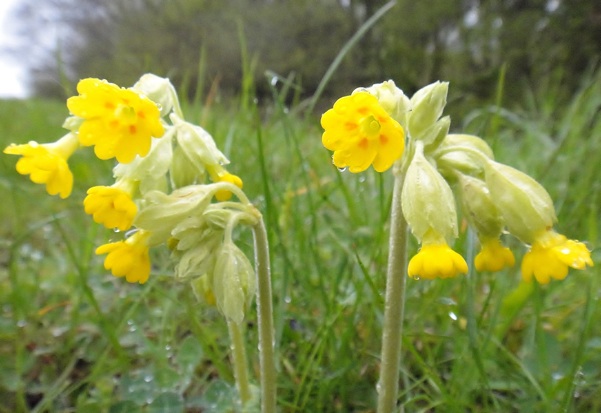
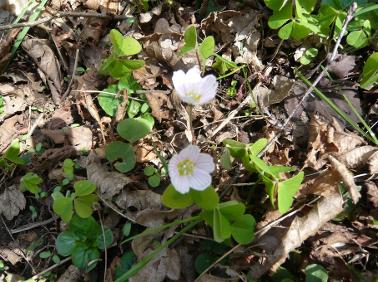
Spring Walk with FSW - Saturday April 7th - led by Heather Govier - report by Ted Forsyth - photos below from Neale Fox
About 20 people followed a route along Vale Border, up field 2, across field 3 to Broad Walk, along Beech Grove, Noakes Way, East Gorse, Middle Gorse, West Gorse, Davids Crook, Field 2 then back to the car park.
Flowers: Dog Violets, Wood Anemone, a couple of flowering Bluebells, Barren Strawberry, Lesser Periwinkle, Lesser Celandine, Dandelion, Primrose, Dogs Mercury, Violet Ivy-leaved Speedwell, Hairy Bittercress, Common Daisy, Red Dead Nettle.
Trees and bushes: Bullace blossom, Turkey Oak buds, Goat Willow catkins, Sycamore leaf buds bursting, Red Osier Dogwood stems, Dogwood bare stems, Bird Cherry leaf buds bursting, Hawthorn leaf buds bursting, Horse Chestnut sticky buds, Gorse in flower, Holly, Blackthorn blossom, Wild Cherry blossom, Marble Gall on Oak, Mirabelle Plum blossom, Ash flower buds bursting, Larch female flowers, Elm flower buds, Beech still in leaf.
Fungi: Scarlet Elfcup, King Alfred’s Cakes, Jelly Ear, Blushing Brackets(?).
Birds: (a few seen but mostly heard) Coal Tit, Great Tit, Robin, Ring-necked Parakeet, Chiffchaff, Buzzard, Green Woodpecker.
Ten people came to the walk on a damp day. There had been heavy rain the night before so the ground was very wet but the rain held off for the 2 hours of our walk. The route took us through Fields 1, 2, 3, Stevens’ Larch, The Wend, Middle Gorse, West Gorse, Pool Grove, David’s Crook, Stevens’ Walk, Great Field then back through Fields 2 and 1 to the car park.
Trees and Bushes seen: Blackthorn, Field Maple, Privet, Beech, Hornbeam, Whitebeam, Red-osier Dogwood, Oak, Spindle, Hazel, Silver Birch, Laurel, Holly, Yew, Scots Pine, Wild Cherry, Sweet Chestnut, Elm, Gorse, Ash, Larch, Hawthorn, Sycamore, Lime, Raspberry, Corsican Pine, Mirabelle Plum, Turkey Oak, Common Dogwood, Wild Rose, Wild Clematis, Wayfaring Tree, Black Bryony. (33 species)
Fungi seen: In Field 3 a couple of Ashen Knights were seen. In Stevens’ Larch, just as we were about to exit to Great Field, we found a very large Wild Cherry with a group of Funnel caps at the base. One had a cap about 22cm across but also had a stem (stype) over 15cm in height and with deeply decurrent gills. I believe these are more likely to be Trooping Funnel rather than our first guess of Giant Funnel. A small Oysterling and Split Porecrust were also seen. In The Wend a tree stumps had a lot of Candlesnuff fungi and the old Beech tree unexpectedly had a few King Alfred’s Cakes growing in a crevice. In West Gorse a pile of Sycamore logs had a good display of Coral Spot. (7 species)
Extra FSW Fungus Hunt - Sunday 15th October 2017 - led by Tony Flecchia - report by Tony Flecchia
Despite having 65 instances with 49 species additional to last week's walk to look at, on a route equal in length to the original whole walk, we managed it in just under 1 hour 50 minutes. The route list is given below (the red X marks denote item not often seen on our fungi walks). Photographs of all species seen on both walks can be seen on the Sightings page.
The three guests all asked after Ted and were pleased to hear he is making progress with recovery.

|
Second Part of Walk 15-10-17.rtf Size : 4.341 Kb Type : rtf |
FSW Fungus Hunt - Sunday 8th October 2017 - led by Ted Forsyth and Tony Flecchia
- report by Tony Flecchia - photos above by Neale Fox, Linda Morris and Tony Flecchia
Twenty-seven people turned up for the walk, including three children. The route and number of fungi planned for viewing was perhaps a little too much, since progress was slow due to the number of fungi and associated questions and photography. At one and a quarter hours with about two fifths of the route length covered, Ted Forsyth was taken ill with a recurrence of an illness, so it was necessary the walk to be aborted for Tony Flecchia to fetch his 4 wheel drive car to carry Ted home.
Those present were very understanding and many expressed themselves as being happy with the number of fungi they had seen anyway. The section covered originally included 20 species planned for viewing, but 8 more had been added during the walk, making a very satisfactory total of 28 for only a little over an hour. It was announced to those present that Tony Flecchia would continue the rest of the walk the next Sunday the 15th for anyone wishing to attend.
This walk was timely as 8th October was UK Fungus Day see www.ukfungusday.co.uk. A full list of the fungi seen is given below.

|
Fungi Seen on the Walk on 8th October 2017.pdf Size : 257.948 Kb Type : pdf |
Minbeast Hunt - Wednesday 16th August 2017 - led by Roger Hawkins & Vic Wallace
- photos above by Tony Flecchia
A couple of dozen children (with accompanying adults) came to our hunt on a warm, fair day with some sunny spells. After a brief introduction from Roger, the children were issued with collecting pots, nets and catching sheets and they set off around the car park field with their parents and grandparents to see what could be found. As in previous years, the sharp eared children were able to find the chirruping crickets and were much quicker and more skilled than the adults at spotting and catching even the tiniest spiders.
To finish the session several groups walked up into David's Crook to look for butterflies on the marjoram patch and to beat the hedgerows with sticks to knock the minibeasts lurking there onto a catching sheet.
Species collected and identified included: Meadow Brown Butterfly, Gatekeeper Butterfly, Male and Female Common Blue Butterflies, Blackneck Moth, Straminella Grass Moth, Unidentified Grass Moth, Cocoon case of Burnett Moth on grass stem, Andricus kollari Marble Gall Wasp, unidentified Tachinid Fly, Field Grasshopper, Roesel's Bush Cricket, Hairy Shieldbug (Dolycoris baccarum), a grass bug (Stenodema laevigatum), a damsel bug (Nabis sp.), Froghopper, two unidentified Leaf Hoppers, Common Green Aphid, Oedemera lurida Flower Beetle, Common Garden Spider (Araneus diadematus), Metalina mengei Summer Orb Weaver Spider, unidentified tiny Linyphid Spider, Red Spider Mite, young Great Black Slug, a number of snails, Red Pustule Galls, Eriophyes laevis Galls, Seven-spot Ladybird, 14-spot Ladybird, 22-Spot Ladybird, Orange Ladybird, Red-tailed Bumblebee (Bombus lapidarius), Buff-tailed Bumblebee (Bombus terrestris), Common Carder Bumblebee (Bombus pascuorum).
We were told that the event had been advertised on Hoop, a website showing activities for children. We did not put it up there but were glad to see that it had been effective.
(Photographs of most of the named species can be found on the Fauna page of this website.)
Bat & Moth walk with Malcolm Bridge Thurs 20 July 2017 photos above from Neale Fox
About 38 people gathered in the car park by 9.00pm when it was still light and left Malcolm Bridge to set up his moth trap while we walked up through Vale Meadow and Great Field to stop at the entrance to Langford’s Way. As the light dwindled, we waited for the appearance of flying moths and tried to find the presence of bats using detectors. In previous years this has been a good spot to find bats but this year the activity seemed more confined to the woodland, perhaps as a result of the winter clearance of many trees along Leafy Grove. Detectors were soon rattling out their signals as Common Pipistrelle bats swooped around the foliage of trees near the path. After a suitable time we returned to the car park where the bright light of Malcolm’s trap could be seen. Malcolm showed a number of photographs of selected moths then began emptying pots in which he had incarcerated individual moths. The moths identified were:
Heart & Dart, Rustic, Black Arches, Ruby Tiger, Straw Dot, Common Footman, Tree Lichen Beauty, Oak Hook Tip, Scalloped Oak, Mottled Rustic, Dun-bar, Dark Sword-grass, Common Grass Veneer, Shuttle-shaped Dart, Lesser Yellow Underwing, Dark Arches, Marbled Minor, Single-dotted Wave, Least Carpet and a pretty little micro moth - Lozotaeniodes formosana.
To round off the evening, after identifying any moths in the trap, he then produced a couple of more pots from which he produced two magnificent Jersey Tiger moths which were eventually released on to a nearby tree trunk.
We left the area around 10.45pm.
We met in the Car park as usual and Malcolm Bridge did an introductory talk but with the cooler weather and the gusty wind conditions it didn't look like very favourable conditions.
Eighteen of us walked along Vale Border and then crossed Vale Meadow where there was a sudden warmth and butterflies started appearing. Meadow Browns, the odd Gatekeeper and Nemophora species moths ( longhorn moth ) as well as six spotted Burnet moths were found. We crossed into the Great Field where we found a Common Blue butterfly and a few Marbled Whites as well as a Silver Y moth and a Crab Spider. Crossing into David's Crook much to Malcolm's delight we found a Small Copper butterfly. We meandered up to Linden Glade via Pool Grove but unlike previous years there were no butterflies found there.
Working our way back to the car park we found a tatty Ringlet butterfly close to the Jubilee plantation then in Green Hill on the Ragwort, Cinnabar moth caterpillars and a couple of Cinnabar moths were also spotted.
Overall it turned out to be very enjoyable and successful walk, although if Ted Forsyth could have been with us I am sure it would have been even better. (Ted was unwell.)
Flower walk with Malcolm Jennings - Sunday 18th June 2017 - photos from Neale Fox & Malcolm Jennings
22 people were in the group which followed a route starting on Vale Border and passing through Field 2, Great Field, Steven's Walk and back to the car park.
Species seen:
Flowers: Daisy, Hogweed, White Clover, Selfheal, Comfrey. Nipplewort, Oxeye Daisy, Dandelion, Wall Barley, Shepherds Purse, Greater Plantain, Red Clover, Nettle, Birdsfoot Trefoil, Goatsbeard, Knapweed, Pyramidal Orchid, Greater Yellow Rattle, Hedge Woundwort, Lesser Bindweed, meadow Buttercup, Black Medick, Scabious, Ribwort Plantain, Sainfoin, Bladder Campion, Marjoram, Dog Violet, Germander Speedwell, Goosegrass (Cleavers), Cow Parsley, Common Spotted Orchid, Enchanters Nightshade, Wood Spurge, Wood Avens (Herb Bennett), Herb Robert, Garlic Mustard, Cinquefoil, Dogs Mercury
Trees and bushes: Elder, Dogwood, Privet, Hawthorn, Laurel, Beech, Hornbeam, Whitebeam, Red Osier Dogwood, Bramble Wild Rose, Sycamore, Ash, Sessile Oak, Blackthorn, Turkey Oak, Hazel (with nuts), Mirabelle Plum (with plums), Field Maple, Wild Clematis
Insects: Meadow Brown butterfly, Comma butterfly, Longhorn Beetle
Wildflowers: Bulbous Buttercup, Cleavers (Goose Grass), Cow Parsley, Germander Speedwell, Dogs Mercury, Cowslips, Ribwort Plantain, Bluebell, Daisy, Dandelion, Yellow Archangel, Greater Stitchwort, Wood Anemone, Wood Sorrel, Bugle, Wild Strawberry, Yellow Pimpernel (Creeping Jenny), Dog Violet, Lesser Celandine, Herb Robert, Wood Speedwell, Wavy Bittercress, Wild Garlic, Lesser Periwinkle, Wild Arum, Mousear, Garlic Mustard, Green Alkanet, Greater Yellow Rattle, Wild Garlic, White Dead Nettle, Sanicle, Ground Ivy, Black Medick,
Bushes and Trees: Copper Beech, English Elm, Beech, Gorse, Rowan, Hawthorn, Wild Cherry, Lime, Field Maple, Wayfaring Tree, Ash, Sycamore, Blackthorn.
Birds: Ring-necked Parakeet, Blackcap, Jay, Chiffchaff, Jackdaws.
Fungi: Witches Butter, Dryads Saddle.

|
Flower Guide Spring 2017.pdf Size : 326.479 Kb Type : pdf |

|
Selsdon Wood Walk 6:5:17.pdf Size : 729.841 Kb Type : pdf |
Spring Walk Sunday 2nd April 2017
Around 36 people joined the walk which began following the Green Walk along Vale Border where we noted a few Daises in flower and argued about the proportions of Bullace and Blackthorn in the flowering hedge. We entered Broad Walk and were soon admiring the carpets of Wood Anemones. Chiffchaffs and Blackcaps have suddenly increased in number over the last few days and were heard singing in several parts of the walk. In Linden Glade we stopped to talk about the pond and looked at the Periwinkle bed, the three Tutsan plants and a small number of flowering Lesser Celandine. Continuing along West Gorse we examined a dry specimen of Witches Butter, which was almost unrecognisable as it was so shrivelled and dry, and spotted a King Alfred’s Cakes fungus on a fallen Ash log. Wood Anemones were everywhere but it was not until we reached Greenhill Way that we began to see Wood Sorrel along the edge of the path but only an occasional one was in flower. Throughout the walk we kept seeing Bluebells coming into flower. St George’s Mushrooms were seen in David’s Crook and a few Cowslips and Primroses.
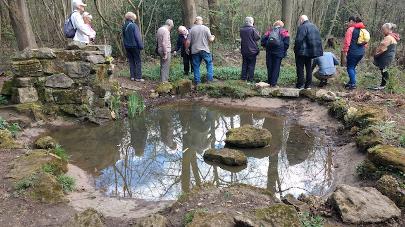
Rainy weather led to the cancellation of this walk but I contacted FSW members to let them know that we would go at the same time on the following day if there was any demand. Two people turned up for the walk with their dogs (plus Neale, Karen and Ted) and we walked round the planned route looking at some of the more striking trees such as the Spindle in F3 laden with berries and the striking silvery leaves of the White Poplar in David's Crook. A few interesting fungi were also seen including Hen of the Woods in West Gorse shown here.
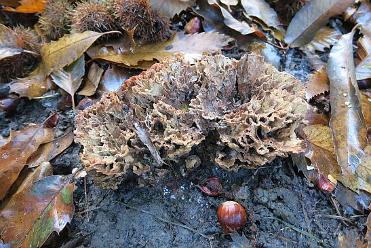
23 people joined the fungus walk, following a route devised by Tony Flecchia to see the fungi found by Heather, Tony and Ted. Even in the couple of days before the walk brief showers encouraged more fungi to appear and new species were being found, with the more obscure ones being identified by Tony. We saw four species of leaf spots on bushes and trees and manged to show a range of fungi from tiny Oak Pin to enormous Chicken of the Woods. Inevitably, several of the walkers pointed out fungi we had not recorded and added a number of species to our list. The participants seemed to enjoy the walk and one or two said they had learned a lot, but refused my invitation to lead the walk next year!
50 different species of fungus were seen - see list below.
Duration of walk 2 hours 5 minutes

|
9 Oct 2016 Fungi Walk, Species List.pdf Size : 10.338 Kb Type : pdf |
Minbeast Hunt - Wednesday 17th August 2016 - led by Roger Hawkins & Vic Wallace
- photos above by Linda Morris and some of the visitors
Around 20 adults and 30 children came to our hunt on a lovely warm sunny day. After a brief introduction from Roger & Vic, the children were issued with collecting tubes, nets and catching sheets and they set off around the car park field with their parents and grandparents to see what could be found. As in previous years, many sharp eared children were able to find the chirruping crickets and with better vision they could even count the spots on the tiniest of ladybirds.
To finish the session several groups walked up into David's Crook to look for butterflies on the marjoram patch and to beat the hedgerows with sticks to knock the minibeasts lurking there onto a catching sheet.
Species collected and identified included: butterflies - Common Blue, Meadow Brown & Speckled Wood; Roesel's Bush Cricket (2 females); Speckled Bush Cricket (male); Green Sheildbug; Pine Ladybird; 16 spot Ladybird; 22 spot Ladybird larva; Common Froghopper; Flower Bug, Anthocoris nemorum; hairy caterpillar of Tiger Moth; Woodlouse; Centipede; White-lipped Snail; Small black Bee (Lasioglossum sp.) male - visiting Ragwort flowers; a dragonfly; many different spiders; bees; wasps; slugs and 2 species of grass moth.
We asked where the attendees had found out about the hunt. Responses included: an advert in Selsdon Library, a poster in Sainsburys, word of mouth, our website, the LB Croydon website; poster in the car park, the Croydon guide (Great Green Yonder). The Flavours Cafe in Warlingham Village was suggested as s good place for a poster as it is frequented by parents with young children.
(Photographs of most of the named species can be found on the Fauna page of this website.)
Bat & Moth Walk with Malcolm Bridge and Ted Forsyth - Thursday July 28th - photos above from Neale Fox
We had almost ideal conditions for the bat and moth walk with cloudy conditions and dry, though we had a shower earlier in the day. We left Malcolm to set up his moth trap while around 15 of us trekked up through Fields 1 and 2. When we reached the Centenary Plantation Heather took us through into Field 3 where we were shown dozens of Cinnabar moth caterpillars feeding on several Ragwort plants. We continued through Gt Field to the top of Langford’s Way where we stopped to operate the bat detectors, hearing a response from a bat over the edge of the nearby trees. As the light dwindled several Pipistrelle bats began swooping down to grass level in pursuit of aerial insects, causing the detectors to respond loudly. The signal detected by my instrument ranged from 45kHz to 51kHz so it is just possible that there might be Soprano Pipistrelles amongst the Common Pipistrelles but more evidence would be needed to be sure.
As we returned to the car park a very vocal Tawny Owl, probably in the tree line between Fields 3 and 2, called repeatedly as we walked by. At the moth trap a large Caddis fly drew our attention and soon we were watching moths fluttering near the lamp or settling on the cloth on which the lamp had been placed. Occasional moths landed on clothing and sometimes remained for long periods while others fluttered out into the dark before returning again. The following species were identified before we left the site but it was obvious that new species were turning up even as we packed up and drove off.
Caddis Fly, July Highflyer, Gallium Carpet, Gelekid Moth, August Thorn, Brimstone, Tree Lichen Beauty, Leopard Moth, Oak Hook Tip, Rustic, Pandemis corylanus, Pug sp, Nut Tree Tussock, Common Footman, Dunbar.
Butterfly Walk Sat 16 July 2016
On a lovely warm sunny day around 28 of us, led by Malcolm Bridge, set off from the car park. We soon saw Meadow Browns which, as expected, were the most numerous of the butterfly species we saw on the walk. A Silver-Y moth flitted amongst the grasses. A Red Admiral was seen and a very active Marbled White was identified. Sharp eyes spotted a small caterpillar almost invisible on a grass stem, and a second was found nearby – probably Meadow Brown caterpillars. A couple of Speckled Wood flew rapidly past us as we were about to enter Pool Grove where we found another Speckled Wood flitting from Bracken to Hazel. Malcolm pointed out leaf mines, made by larvae of small Agromyzid flies, on both Hogweed leaves and Hedge Woundwort. In Linden Glade the first butterfly to appear was the ubiquitous Meadow Brown but we had a brief glimpse of a Silver-washed Fritillary as it came down from the tree tops to investigate bramble flowers. At this stage we decided to modify our route and followed Smith Grove to reach Great Field where we turned right. At the end of the field a bank of Bramble proved attractive to a Comma and also to another Silver-washed Fritillary which gave us marvellous views. Having spent quite a long time admiring the Fritillary we moved fairly rapidly through fields 3 and 2 to get back to the car park.
Butterflies/Moths
Lots of Meadow Browns, several Marbled Whites, a few Speckled Woods, one Red Admiral, one definite Ringlet, one Comma and two Silver-washed Fritillaries. One Silver-Y moth.
Birds
A singing Stock Dove off Linden Glade, a soaring Buzzard high over Great Field, a few singing Blackcap, Blackbird, Coal Tit.
Grasses, etc
Malcolm Pointed out Timothy Grass, Yorkshire Fog, Upright Brome and a meadow grass. Leaf mines on Hogweed and Hedge Woundwort were also shown to us.
Discover Summer Flowers Walk - Sunday 19th June 2016 - photos above from Neale Fox
16 people gathered in the car park for Malcolm’s flower walk and it had hardly got started when Heather spotted a Red Kite disappearing over the Vale Border hedge. Unfortunately, when it reappeared it was much further away and at a greater height and could just be seen vanishing in the direction of Forestdale.
Our route took us along the border and through fields 1, 2 and 3 then into Great Field, Stevens Walk, David’s Crook and back to the car park. Pyramidal Orchids were appearing in all the fields and a few Common Spotted Orchids were found in Field 3, Great Field and Field 2 (just outside Jubilee Plantation where one was found last year). In Steven's Walk the Dryad’s Saddle fungus had returned and one section was about 18 inches across.
Plants: Wall Barley, Greater Plantain, Daisy, Dog Rose, Wild Clematis, Nettle, Goose Grass, Cow Parsley, Greater Yellow Rattle, Hogweed, Bulbous Buttercup. Meadow Buttercup, Creeping Buttercup, Goatsbeard, Cocksfoot, White Clover, Red Clover, Bullace, Pyramidal Orchid, Mousear, Catsear, Scabious, Black Medick, Birds’-foot Trefoil, Oxeye Daisy, Selfheal, Sainfoin, Bladder Campion, Marjoram, Crested Dog’s-tail, Perforate St John’s Wort, Germander Speedwell, Common Spotted Orchid, Hawkweed sp., Ribwort Plantain, Dandelion, Bracken, Rosebay Willowherb, Bramble, Dock, Knapweed, Common Sorrel, Garlic Mustard, Herb Robert, Herb Bennet, Hedge Woundwort, Sanicle, Primrose, Cinquefoil, Wild Strawberry, Comfrey, Sow Thistle, Mayweed sp.
Trees & bushes: Crab Apple, Turkey Oak, Field Maple, Dogwood, Whitebeam, Wild Privet, Hornbeam, Spindle, Elder.
Birds: Red Kite, Swift, Magpie, Carrion Crow, Chiffchaff, Blackbird, Wren.
Butterflies: Meadow Brown, Common Blue.
Fungi: Dryad’s Saddle, St George’s Mushroom (?).
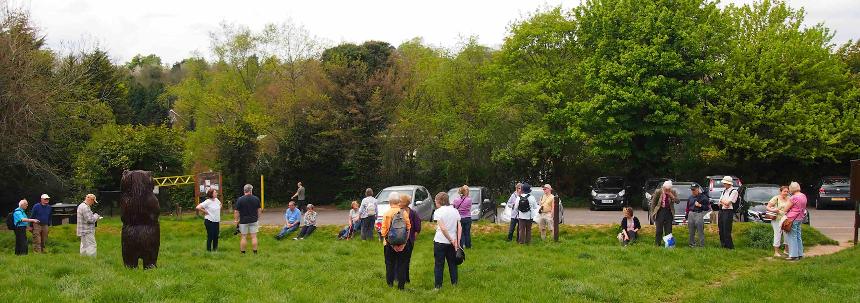
Birds and Flowers Walk - Saturday 7 May 2016 - photos above from Neale Fox
30 participants followed a route from Greenhill Way, through David’s Crook, Bluebell Grove, Leafy Grove, Langford’s Way, Beech Grove, Noakes Way, East Gorse, West Gorse, Pool Grove, David’s Crook and back to the car park.
Birds seen/heard
Blackbird, Jackdaw, Magpie, Robin, Buzzard, Chiffchaff, Great Tit, Blue Tit, Carrion Crow, Jay, Blackcap, Ring-necked Parakeet
Plants identified
Bulbous Buttercup, Dog Violet, Primrose, Wood Anemone, Garlic Mustard, Dogs Mercury, Lesser Celandine, Cowslip, Wild Strawberry, Ground Ivy, Greater Yellow Rattle, Germander Speedwell, Lesser Stitchwort, Ribwort Plantain, Black Medick, Yellow Archangel, Wood Sorrel, Toothwort, Herb Robert, Wild Arum, Hairy Bittercress, Bluebell (blue and white versions), Bracken, Goldilocks Buttercup
Trees & Bushes
Field Maple, Sycamore, Wayfaring Tree, Mirabelle Plum, Blackthorn, Beech, Hazel, Holly, Horse Chestnut, Sweet Chestnut, Oak, Bird Cherry, Wild Cherry, Gorse, Honeysuckle, Raspberry, Rowan
Also St George’s Mushrooms and Orange-tip Butterfly.
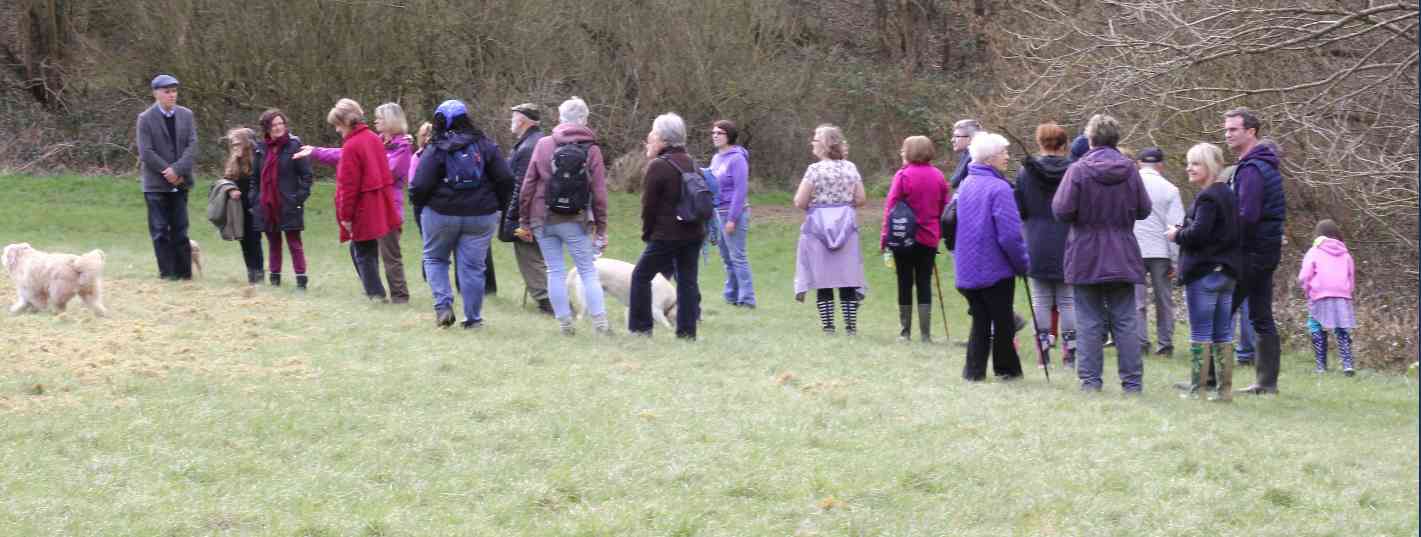
Spring Walk - Sunday 3
April 2016 - photo above from Mark Hemley
About 30 people joined the walk which began by travelling along Vale Border in the car park field where we saw the only butterfly of the day – a male Brimstone. Heather talked about the Blackthorn and Bullace bushes before we crossed the second field to look at Dog Violets. In field 3 Hornbeam, Whitebeam, Red Osier Dogwood and Common Dogwood were seen. The route continued through Broad Walk, Beech Grove, East Gorse, Leafy Grove, Bluebell Grove, David’s Crook, and back to the car park. As the members of the party began to go their separate ways a Buzzard soared over the nearby “birdy” estate.
Species seen/heard
Flowers – Bluebell, Wood Anemone, Wild Arum, Gorse, Wood Sorrel, Primrose, Wild Clematis, Dog’s Mercury.
Trees/bushes – Blackthorn, Bullace, Elder, Silver Birch, Hornbeam, Whitebeam, Red Osier Dogwood, Common Dogwood, Oak, Sweet Chestnut, Ash, Hazel, Sycamore, Larch, Scots Pine, Yew, Buddleia, Mirabelle Plum, Elm
Birds – Magpies, Blue Tit, Chiffchaff, Wren, Robin, Ring-necked Parakeet, Nuthatch, Great Tit, Pheasant, Blackbird, Buzzard, Green Woodpecker.
After the others had dispersed Heather and I walked back across the wood and saw several Jackdaws, Carrion Crows and a Song Thrush. After we separated at Langford’s Way I walked down towards Courtwood Lane and had wonderful views of the white squirrel at the junction with Beech Grove. (We had looked for him on the walk but he could not be spotted.)
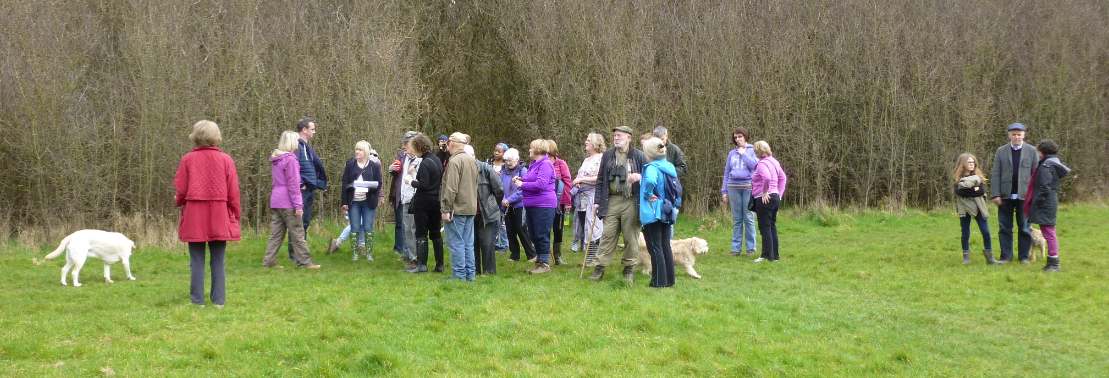
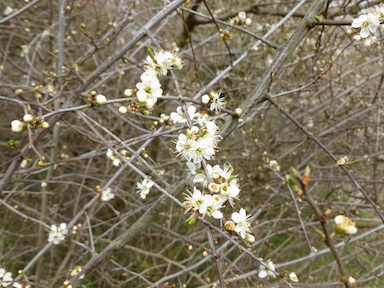
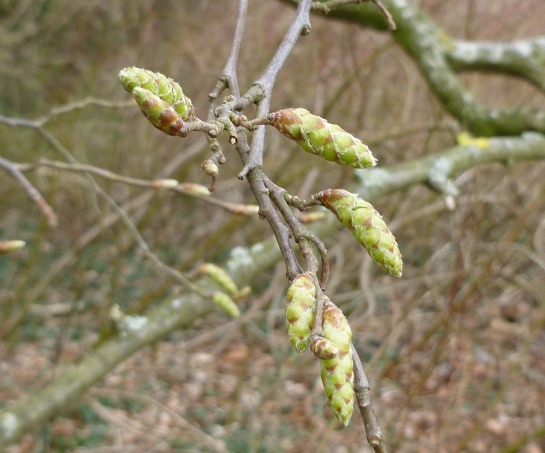
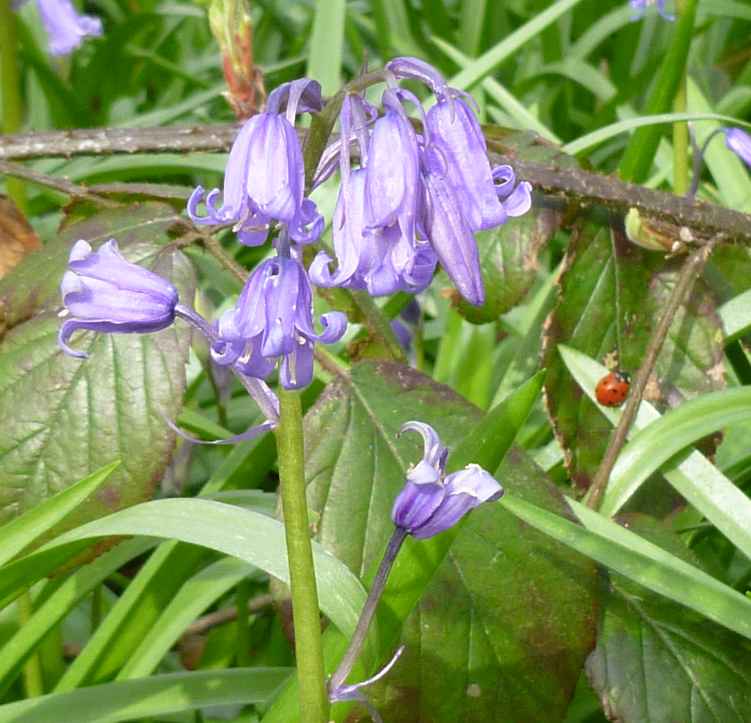
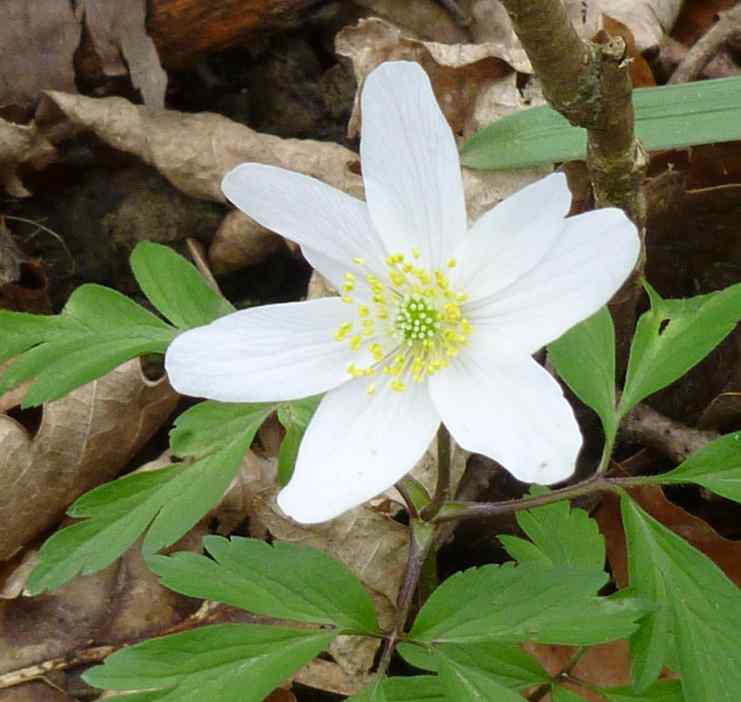
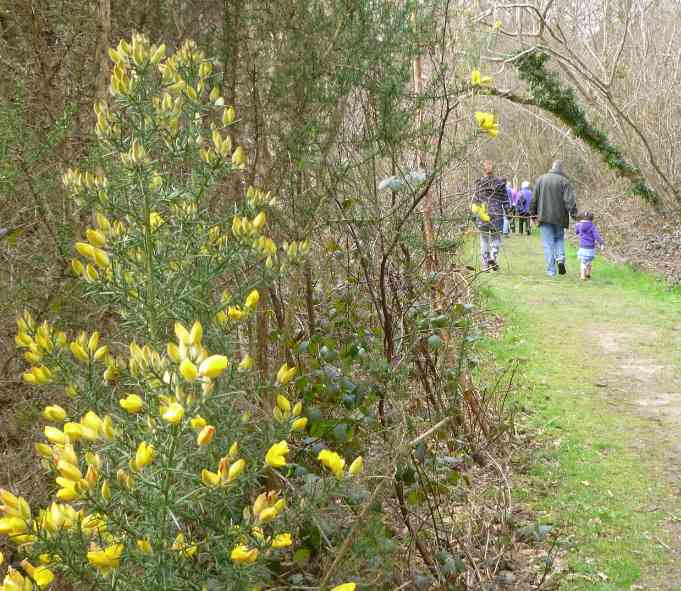
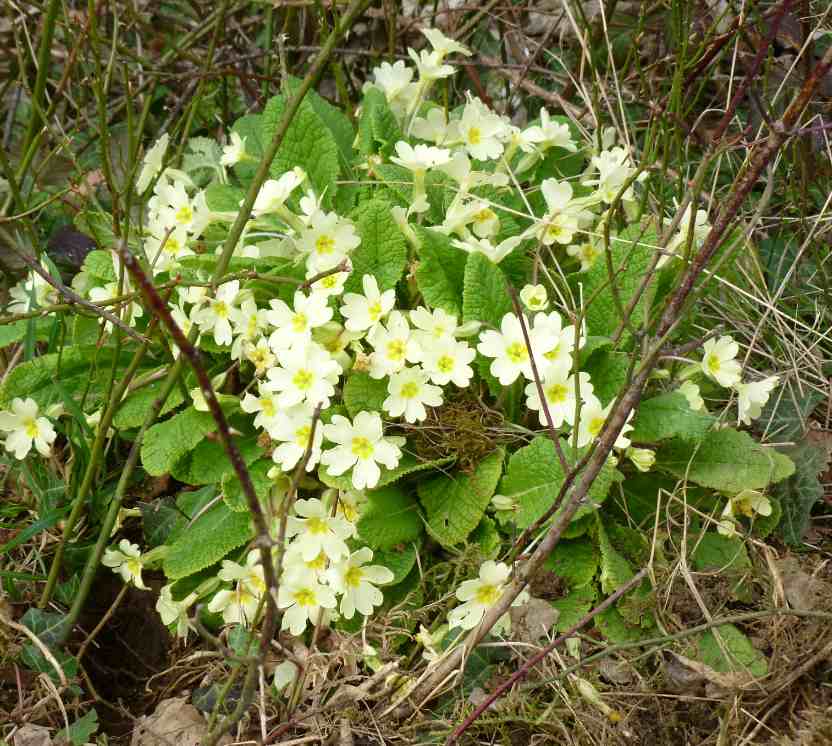
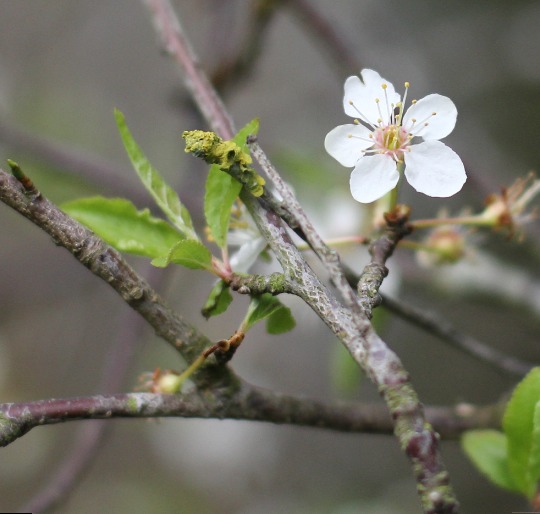
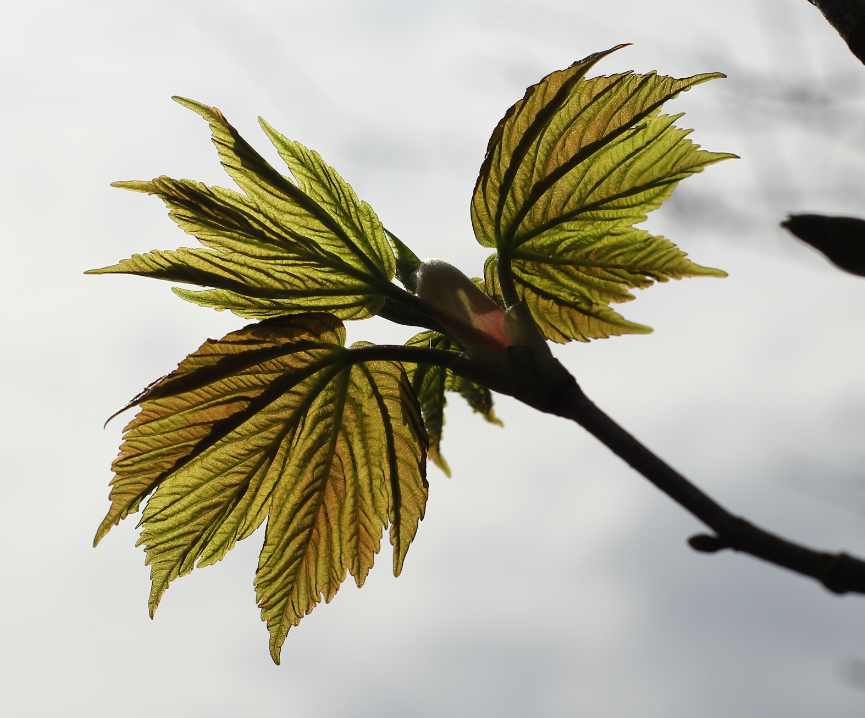
Photos above from Neale Fox
Photos left and below from Mark Hemley - sent in via DropBox
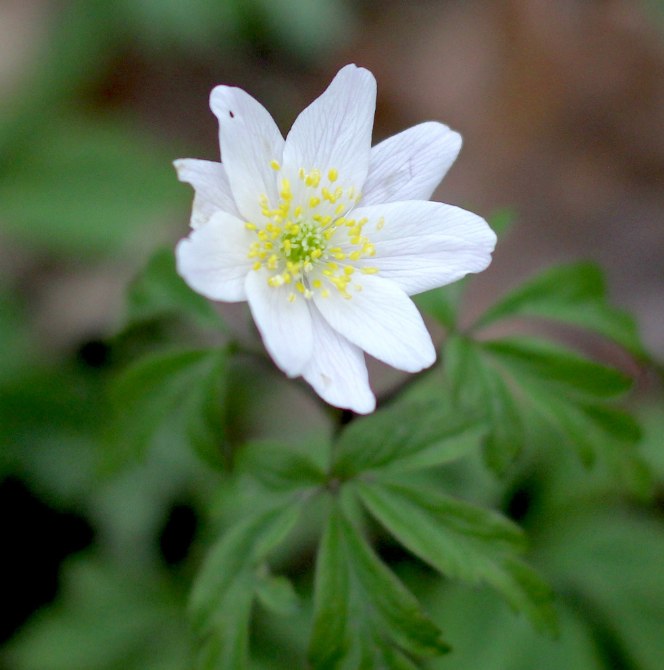
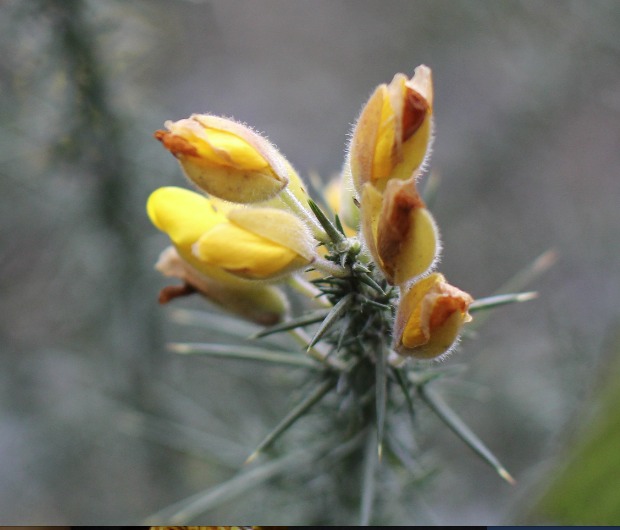
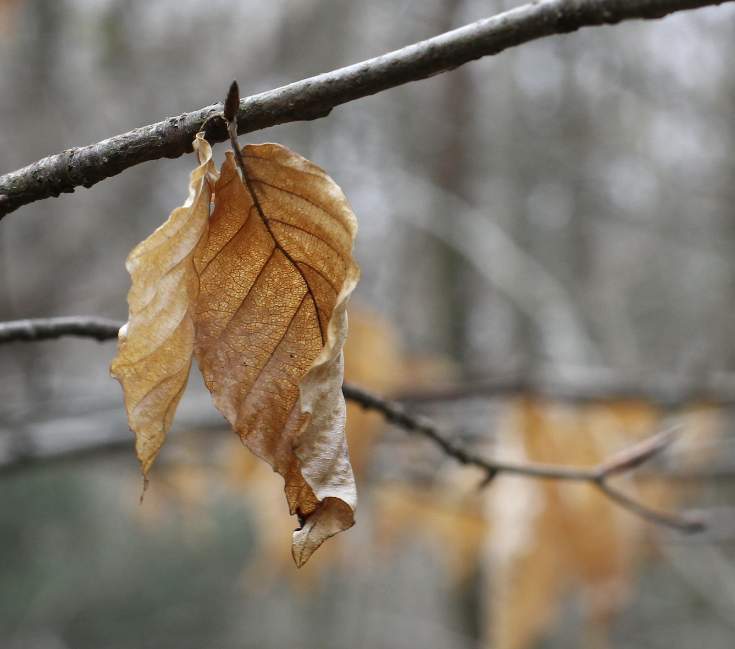
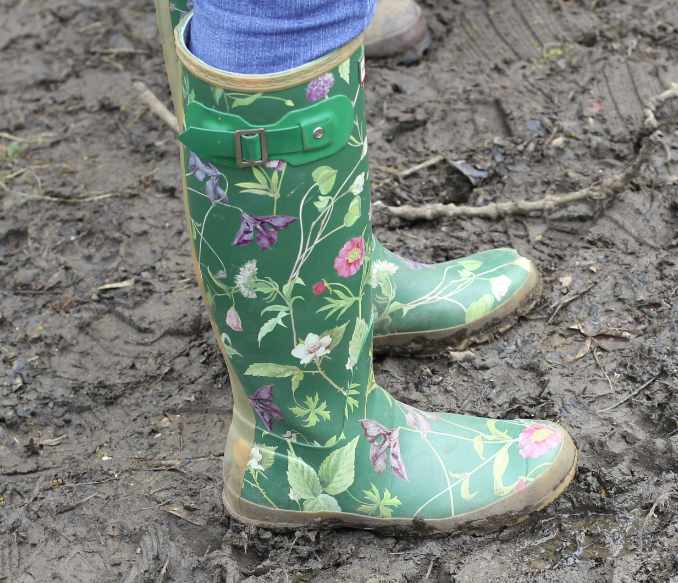

Rain at the end of August and beginning of September produced many fungi but also encouraged slugs which quickly destroyed the fungi. This was repeated several times before about 35 people joined us for the fungus walk on 11th October in fine weather.
Preliminary work had pin-pointed the positions and made initial identifications of many mushrooms, brackets and jellies but some species we saw last year were not found though this was offset by the addition of a few new species.
We began in Greenhill Way with the intention of moving at a good pace from one known fungus to the next but inevitably discussions about each one and requests to identify other fungi found by the participants modified our plan and we had to increase speed to keep to the intended two hour limit. I apologise to those who had been promised a “leisurely stroll”!
Our agreed list - see below - appears to contain 70 species. I must thank Tony Fleccia for his work in spotting and producing identifications for the more obscure species. We had previously found and identified Crested Coral in two places but were surprised when a host of them appeared under our feet at the edge of Linden Glade. We had not seen them even two days before when Tony and I walked the whole route. These coral fungi are initially white but by the time of the walk they had become a grey-brown colour, emphasising why a fungus you find on a walk will not always match pictures in a field guide.
We knew of several Stinkhorn “eggs” and I had hoped one or more might have sprouted to their malodorous full size but that hope was unfulfilled.
It is not unusual to find “green oak” showing the green effect produced by a fungus but it is much less usual to see the culprit in full growth. This is the Green Elfcup fungus which I had seen only once before so I was pleased when I was able to show a specimen on the walk in Langford’s Way.
I hope during October and November that many people will be
spending their time peering into vegetation, under logs, behind tree stumps, on
fallen wood, and in grasslands, and making an attempt to put an identification
to a few of the fungi they find.
Let us know how you get on!
The gallery below shows the 3 species mentioned in the report and a variety of other fungi seen on the walk. Many thanks to Neale Fox and Mogens Holmen for the photographs below and the group shot above.

|
Fungi seen October 2015.pdf Size : 40.98 Kb Type : pdf |
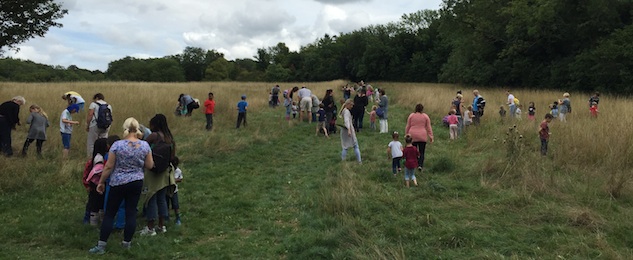
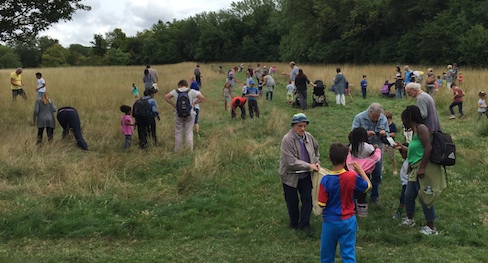
Minbeast Hunt - Wednesday 19th August 2015 - led by Roger Hawkins & Vic Wallace - photos above by Linda Morris & those in the gallery below by Linda Morris and Tony Flecchia
This very successful event was attended by more than 25 adults each of whom was accompanied by at least one child. After a brief introduction from Roger & Vic, all the children were issued with collecting tubes and set off around the car park field to see what could be found. With better hearing than us oldies, almost all were able to find the chirruping grasshoppers and crickets and with better vision they could even count the spots on the tiniest of ladybirds.
To finish the session we all walked up into David's Crook to look for butterflies on the marjoram patch and to beat the hedgerows on the way to knock the minibeasts lurking there onto a catching sheet.
Species collected and identified included: a frog; many spiders; butterflies - Common Blue, Meadow Brown & Gatekeeper; Six-spy Burnet Moth; Meadow Grasshopper (males & females); Roesel's Bush Cricket (males); ladybirds - Seven-spot & Sixtteen-spot; Orange Ladybird larva; Green Sheildbug (nymphs of various sizes); Hairy Sheildbug (adults and Nymphs); green beetle - Oedemera lurida, Harvestman.
(Photographs of all species can be found on the Fauna page of this website.)
Bat walk & moth
trap - Thursday 30 July 2015 - photos above by Neale Fox and blue moon and panoramas below by Linda Morris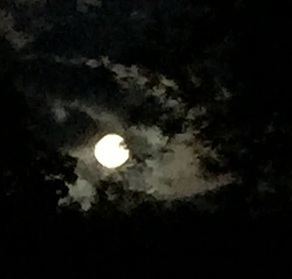
Around 27 people gathered in the car park by 9.00pm. While I was telling Malcolm that it was possible that someone would come to lock the gates, Linda said that the gentleman had arrived and wanted the cars to leave. After some discussion I persuaded him that we had keys and would be sure to lock the gates when we left. While Malcolm set up his moth trap and waited for darkness to fall, the rest of us trudged up the hill and into Great Field where a Roe Deer stood watching us before trotting across towards Stevens Larch. We stopped just before entering the top of Langford’s Way and for the next 20 minutes listened to the noise of bat detectors (we had 3) as single Pipistrelles flew over our heads. We could see them against the sky as they flew by. On the way back to the car park one of the party queried my Scots accent and asked where I came from. It turned out that we were both from Edinburgh and both had studied at the university. He was also a Friend of Croham Hurst. At the moth trap Malcolm showed pictures of various moths then opened the trap within which there was a good collection of the smaller moths, with more arriving. Malcolm identified Ruby Tiger, Hebrew Character, Shuttle-shaped Dart, Marbled Minor, Riband Wave, Common Footman, Light Brocade, Flame Shoulder, Small Magpie, Clay Wainscot, and Green Carpet. As the party began to break up and disappear a July Highflyer was identified on the edge of the trap and a Least Yellow Underwing settled nearby - 13 species in a relatively short space of time. In addition, there were at least two calling Tawny Owls – one from the direction of Vincent Avenue and the other somewhere towards Stevens Larch.
There are photographs of some more of the moths in the Night Flying Moths gallery on the Fauna page.


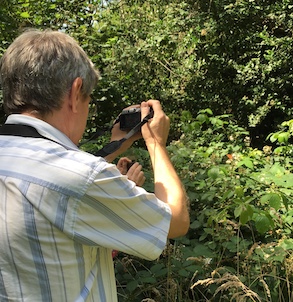
18 people took park on the butterfly walk. As this is the start of the Big Butterfly Count we took particular notice of the insects seen in the first 15 minutes. They were Small White, Meadow Brown, and six-spot Burnet Moth all seen in the car park field, plus Ringlet, Marbled White and Gatekeeper found just inside Field 2 outside the Jubilee Plantation. On the Buddleia opposite the other end of the Jubilee Plantation we managed to see a Comma and a Silver-washed Fritillary, but had a much closer view of the Fritillary just before we entered David's Crook where a clump of bramble was visited also by Large Skipper, Meadow Browns, Ringlets and Gatekeepers. While walking up the slope in David's Crook towards the top seat we stopped at the small patch of Marjoram which is now showing flowers. Here there were Small Skippers, Gatekeepers, Meadow Browns and Ringlets. In Linden Glade the remaining bramble flowers attracted Commas, Meadow Browns, Small Skipper and another glorious Silver-washed Fritillary. Continuing along West Gorse we found a Speckled Wood on its territory just as we reached the Farleigh border path. A Large White was also seen in this area. On East Gorse we found a Red Admiral, initially on the path, but it moved and settled on a less than salubrious pile of dog poo where it was presumably seeking nutrients. We continued down The Wend towards Langford's Way and stopped at the flowering Buddleia where Comma and Large White were the most obvious butterflies but there were brief visits from both Silver-washed Fritillary and a White Admiral. Our route took us along Langford's Way, through Gt Field, Great Hill (Field 3), around the Centenary Plantation to avoid a dangerous broken Ash branch suspended above a narrow path, into Vale Meadow (Field 2) then back to the car park - without adding any new species.
In the absence of the expected leader I led the walk on which we had ten people. Michael Elmer drew people’s attention to possible problems with ticks and recounted a tale of friends who had been affected by tick-borne Lyme disease. A new grass path across the car park field had been created by the grass cutters (this is not shown on the map on the display boards). When Heather investigated this in the previous week she found a Bee Orchid. When we checked before the walk we were able to find more, raising the total to five Bee Orchids. Many Pyramidal orchids were appearing in the fields and a couple of Common Spotted orchids were seen outside Jubilee Plantation in Field 2. In David’s Crook we compared the yellow flowers of Tormentil and Cinquefoil, and nibbled a few Wild Strawberries. In all the grass areas fluttered Meadow Brown butterflies and a few unidentified grass moths were seen. A Broad-leaved Helleborine, thought to have been destroyed by Roe Deer, had revived and was seen outside the Centenary Plantation. In the strip of woodland between Fields 3 and 2 we saw a couple of White Helleborines (now going to seed) and admired the extensive badger sett. On Vale Border we identified a Buckthorn bush but could not find any Brimstone butterfly caterpillars. After adding Hogweed to the list we got back to the car park one and a half hours after starting out.
Orchids: Five Bee Orchids, scores of Pyramidal Orchids, two Common Spotted Orchids (one of which had a Crab Spider with a fly), Broad-leaved Helleborine, White Helleborine.
Trees & Bushesin flower: Buckthorn, Dogwood, Dog Rose.
Other Plants: Wall Barley, Cocksfoot grass, Crested Dog’s-tail grass, Common Sorrel, White and Red Clover, Greater Yellow Rattle, Bulbous Buttercup, Birdsfoot Trefoil, Field Bindweed, Bladder Campion, Self-heal, Common Nettle, Bramble, Cleavers (Goose-grass), Russian Comfrey, Wild Strawberry, Tormentil, Cinque-foil, Goatsbeard, Marjoram, Germander Speedwell, Black Medick, Wood Spurge, St John’s Wort, Hogweed, Scabious.
Fungi: Dryad’s Saddle.
Insects & Spiders: A grass moth, Hoverflies, Meadow Brown butterflies, Soldier Beetle, Crab Spider.
Bluebells, Birds
& Flowers Saturday 2nd May 2015 - photographs above by Neale Fox and Ian Frost
Over 45 people attended and our route took us through Greenhill Way, across David’s Crook to Bluebell Grove, continuing along Leafy Grove and East Gorse to Noakes Way, then via Beech Grove and Langford’s Way to Stevens Walk, finishing by crossing to Centenary Plantation and back to the car park. The main purpose of the walk was to look at the bluebells and we were not disappointed. Following some unseasonably hot weather, the recent rain had brought the flowers out in an amazing display with some wonderful carpets of blue in the wood. Several bird songs were identified near the beginning of the walk but later the wood seemed almost silent and few birds were heard. When we reached Langford’s Way we pointed out the territory of the white squirrel and mentioned we had not seen it for some time. Inevitably one of the party then pointed high up in the trees where he could see the animal perched on a branch. We spent a good few minutes until most people felt they had seen the squirrel then we moved on to Stevens Walk where we saw the recently found Three Veined Sandwort and a vast number of the tiny Lilac Ivy-leaved Speedwell. Further on we examined the Dryad’s Saddle fungi re-appearing on the same tree stump where they have been seen for three or four years. Outside the Centenary Plantation were Ground Ivy and Germander Speedwell and in the plantation was a single specimen of White Helleborine orchid. We were back at the car park after almost exactly two hours. Species identified are listed below.
Birds - Robin, Blackcap, Blackbird, Magpie, Jackdaw, Blue Tit, Great Tit, Jay
Mammals - White Squirrel
Trees & Bushes - Ash, Yew, Sweet Chestnut, Hawthorn, Ivy, Blackthorn, Scots Pine, Larch, Silver Birch, Beech, Holly, Rowan, White Poplar, Gorse, Hazel, Honeysuckle, Bird Cherry, English Oak, Turkey Oak, Wayfaring Tree, Elder
Flowers - Lilac Ivy-leaved Speedwell, Dogs Mercury, Cow Parsley, Cuckoo Pint, Bluebell inc white version, Common Nettle, Burdock, Goldilocks Buttercup, Bulbous Buttercup, Wood Avens (Herb Bennett), Cleavers (Goosegrass), Wood Dog Violet, Common Dog Violet, Forget-me-not, Dandelion, Ribwort Plantain, Wood Sorrel, Greater Stitchwort, Germander Speedwell, Hairy Bittercress, Curled Dock (Identified after the walk), Bracken, Fern, Common Figwort, Yellow Archangel, Wood Spurge, Wild Strawberry, Common Hogweed, Three Veined Sandwort, Cowslip, White Helleborine, Ground Ivy.
Photograph below by Neale Fox shows us all returning to the car park at the end of our walk.

Michael Elmer's Bird walk - Tuesday 21st April 2015
Michael Elmer had arranged to bring his local bird group over for a walk starting in Selsdon Wood so I decided to join them. As we started away from the car park we spotted a pair of Sparrowhawks soaring above the edge of the wood. We continued up to Farleigh Border, through Broom Path and David's Crook to Pool Grove and Linden Glade, along West Gorse and the Gorses, then on to stop by Rob Sowter's bench where we had a word with John Sinclair who is tidying up the edge of the plot before fencing and re-planting. Michael suggested taking Baker Boy Lane so we followed that to the top where I had warned them to look up to the sky. We immediately found a pair of Buzzards! At the Little Owl tree we spent a good few minutes without being able to find the owl and were just about to turn away when Michael said "It is sitting in the nest hole!" We then stayed a lot longer admiring the owl where it could get the sun but was out of the breeze. I took them round Farleigh Court Road then started following the track leading across the golf course towards Frith Wood. I heard a snatch of song and got them to stay quiet while I confirmed it. It was a singing Lesser Whitethroat!
Species seen:
Birds: 2 Sparrowhawks, Kestrel, 2 Buzzards, Little Owl, Wren, Robin, Dunnock, Great Tit, Blue Tit, 3 Long-tailed Tit, Coal Tit, Blackbird, Song Thrush, Chiffchaff, Blackcap, Nuthatch, Pheasant, Jay, Magpie, Carrion Crow, Woodpigeon, Stock Dove, Chaffinch, Greenfinch, Goldfinch, Ring-necked Parakeet, Sky Lark, Swallow, Starling, Collared Dove, House Sparrow, Lesser Whitethroat, Grey Heron, Green Woodpecker, Great Spotted Woodpecker
Butterflies: Brimstone, Peacock, Small Tortoiseshell, Orange-tip
Trees & Bushes: Wild Cherry, Oak, Blackthorn, Downy Birch, White Poplar, Holly, Laurel, Larch, Gorse, Hawthorn, Ash, Hazel, Buddleia, Spindle, Horse Chestnut
Flowering Plants: Bluebell, Wood Anemone, Cowslip, Dandelion, Wild Strawberry, Dog Violet, Wood Dog Violet, Honeysuckle, Primroses, Lesser Celandine, Cuckoo Pint, Cow Parsley, Hogweed, Garlic Mustard, Cleavers, Bramble, Green Alkanet, Ivy, Greater Stitchwort, Herb Robert, Herb Bennet, Periwinkle, Speedwell, White Deadnettle, Wood Sorrel
Fungi & Slime Moulds: Birch Polypore, Lycogale epidendrum – Wolf’s Milk
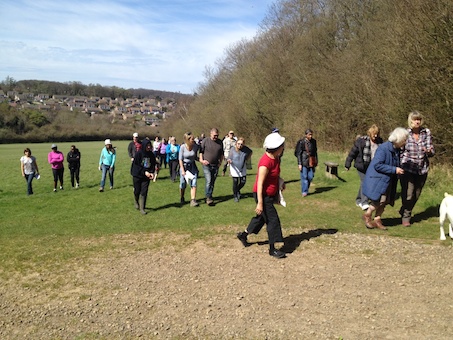
Thanks to Linda Morris (left) and Neale Fox (right) for the photos above and to Linda for the photo of the Cowslips behind the toilet block (below).
On this lovely spring day about 35 people joined us on our walk to spot the signs of spring. Heather led the walk supported by Ted, Linda, Sandra and Karen (and, as always, Bella).
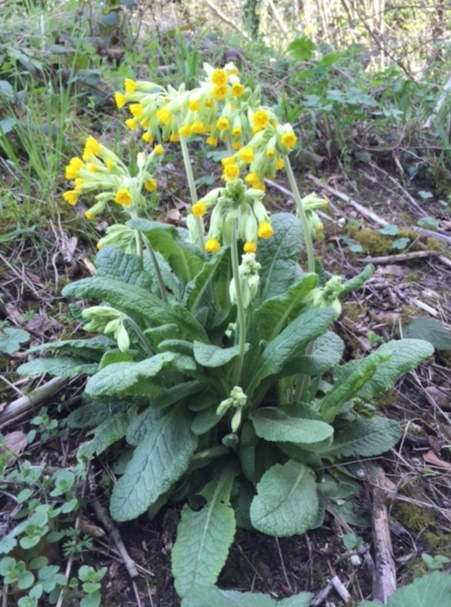
In the car park field we started with Green Alkanet near the entrance gate, Red Dead-nettle on the soil bund and a tall Cowslip clump by the toilet block. Moving on to Vale Meadow we added Daisy, Grape Hyacinth and a huge patch of Cowslips near the badger sett. Outside the Centenary Plantation we found scattering of Ground Ivy. While we walked in the fields we saw occasional Brimstone and Peacock butterflies. As we approached Avis Grove there was a large number of flowering Bluebells amongst the bramble and scattered ones were in flower elsewhere. Norway Spruce was seen at the entrance to Avis Grove where there was also a carpet of Periwinkle. A very large Yew tree was pointed out in Beech Grove and a large Laurel was beginning to show buds but they were not yet open. Lesser Celandine and Wild Strawberry were seen as we turned to move into The Wend where we eventually stopped to admire Rob Sowter's memorial bench. A flowering clump of the relatively insignificant Hairy Bittercress was found by the side of the path. Seeing the magnificent flowering Gorse made it difficult to realise that a few years ago there were hardly any Gorse plants in this area. In East Gorse a few flowering Wood Sorrel were found and we examined the only group in the wood of the strange Toothwort plants. In West Gorse we found the remains of the winter-fruiting Scarlet Elfcup fungus, and in Linden Glade we looked at the large female Holly and the Corsican Pine. Blackthorn in David's Crook was well into bud but not yet in flower and the Mirabelle Plum had its flowers now hidden in the opening leaves. Passing through the gap towards the Jubilee Plantation we briefly examined the old King Alfred's Cakes fungi on a log and saw the large amount of Dogs Mercury by the side of the path. That brought as back to the car park where the walk ended just under two hours after we started.
SPECIES SEEN (or heard)
Mammals: Roe Deer, Badger sett
Butterflies: Brimstones, Peacocks
Trees & Bushes: Ash, Elder, Norway Spruce, Laurel, Corsican Pine, Scots Pine, Larch, Yew, Holly, Gorse, Blackthorn, Mirabelle Plum
Fungi: Scarlet Elfcup, King Alfred's Cakes
Birds: Magpie, Nuthatch, Wren, Robin, Great Tit, Blue Tit, Coal Tit, Chiffchaff, Dunnock, Blackcap, Woodpigeon
Flowering Plants: Green Alkanet, Red Dead-nettle, Cowslip, Daisy, Grape Hyacinth, Ground Ivy, Ribwort Plantain, Bluebell, Periwinkle, Cuckoo Pint, Wood Anemone, Dog Violet, Primrose, Dandelion, Dogs Mercury, Hairy Bittercress, Wood Sorrel, Toothwort, Lesser Celandine, Wild Strawberry

|
Flower Guide Spring 2015.pdf Size : 636.277 Kb Type : pdf |
Family Woodland Walk with Meike Weiser - Saturday 7th March 2015 (for families with children aged 5+)
The weather was so nice that many people must have decided to go further afield and only 2 families turned up. We nevertheless had a leisurely walk through the woods. Many thanks from the FSW to Meike for leading this walk.
photo by Linda Morris
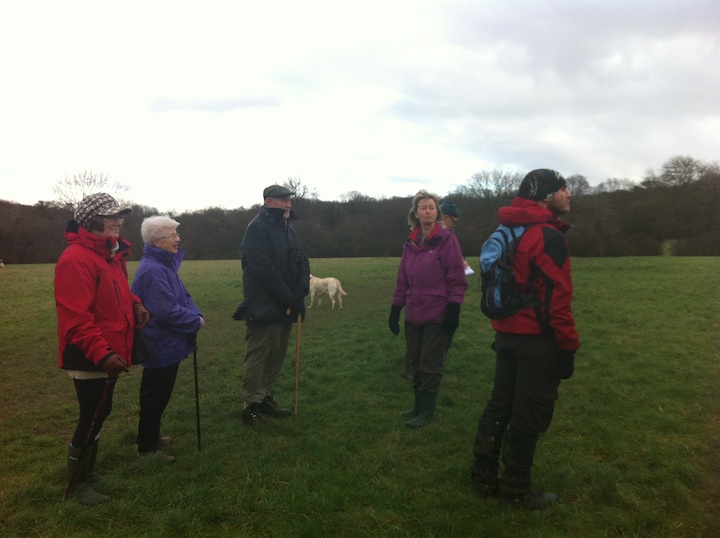
Four visitors joined 3 members of the committee (Heather, Ted and Linda) + Bella on this walk.
Bold text shows that we spotted 29 of our 39 tree species. We also saw the white squirrel and several fungi.
I have to begin by apologising for, and correcting, two known errors in identifying fungi. Just inside the wood on Greenhill Way when “black fingers” were found I proclaimed them to be Dead Moll’s Fingers. Later examination of photos showed them to be Dead Man’s Fingers. Later we looked at what I had originally called Beech Jellydisc, though I had expressed some doubt. We have now decided it is a specimen of Leafy Brain.
While we were waiting for the last stragglers to arrive in the car park we found a solitary fungus growing in the grass by the toilet block, later identified as Coprinellus xanthothrix. This gave us some hope that the recent heavy rain had at last encouraged fruiting of mushroom-type fungi. Heather, Tony and I had been searching for and identifying fungi during the drier weeks but the majority were brackets and other types growing on wood. At least this gave us the chance to plan a route. After the rain, Candlesnuff had put in an appearance but in most cases was still very small. Mycena bonnets of various kinds were found in a number of places and Tony took some away for examination.
When we have agreed our list of fungi it will be added to the website. Here I can mention only a few highlights. Our pre-walk preparations had found three Beefsteak fungi in Noakes Way but a new one was added on a fallen tree stump in Linden Glade. A twig with Common Jellyspot also displayed a Flat Backed Millipede. Both Yellow Stagshorn and Small Stagshorn were seen. A classic violet-coloured Amethyst Deceiver was found in David’s Path, and nearby a Waxy Crust rolled back the bark on a small branch. In Middle Gorse the last remaining Olive Oysterlings were seen and the toppled solitary Weeping Bolete was still identifiable.
The walk was attended by 37 people, some of whom must have
had problems seeing most of the fungi. My apologies to anyone who feels they have missed out. With the wetter weather more fungi will
be appearing so take the chance to get out to look for them. You never know what you might find!
Addendum: Two days after the walk Tony and I returned to the log with the Dead Man's Fingers and found that it also carried Dead Moll's Fingers!
Armillaria tabescens, Ringless Honey Fungus - Ascocoryne sarcoides, Purple Jellydisc - Auricularia auricula-judae, Jelly Ear - Boletus badius, Bay Bolete - Bulgaria inquinans, Black Bulgar - Calocera cornea, Small Stagshorn - Calocera viscosa, Yellow Stagshorn - Coprinellus disseminatus, Fairies Bonnets - Coprinellus xanthothrix - Cudoniella acicularis, Oak Pin - Dacrymyces stillatus, Common Jellyspot - Daedaleopsis confragosa, Blushing Bracket - Daldinia concentrica, King Alfred's Cakes or Cramp Balls - Diatrype stigma, Common Tarcrust - Exidia nucleata, Crystal Brain - Fistulina hepatica, Beefsteak Fungus - Ganoderma aplanatum, Artists' Bracket - Ganoderma australe, Southern Bracket - Hyphodontia sambuci, Elder Whitewash - Hypoxylon fuscum, Hazel Woodwart - Inonotus nodulosus, Silvery Porecrust - Ischnoderma benzoinum, Benzoin Bracket - Laccaria amethystina, Amethyst Deceiver - Laetiporus sulphureus, Chicken of the Woods - Lycoperdon pyriforme, Stump Puffball - Marasmiellus ramealis, Twig Parachute - Marasmius oreades, Fairy Ring Champignon - Mycena abramsii, Summer Bonnet - Mycena citrinomarginata - Mycena crocata, Saffrondrop Bonnet - Mycena inclinata, Clustered Bonnet (Oak Stump Bonnet) - Mycena maculata - Mycena olida, Rancid Bonnet - Mycenella salicina - Nectria cinnabarina, Coral Spot - Panellus serotinus, Olive Oysterling - Phellinus sp., Rusty or Cinnamon Porecrust - Piptoporus betulinus, Birch Polypore (Razorstrop Fungus) - Rhytisma acerinum, Sycamore Tarcrust - Russula amoenolens, Camembert Brittlegill - Schizopora paradoxa, Split Porecrust - Scleroderma citrinum, Common Earthball - Skeletocutis nivea, Hazel Bracket - Stereum gausapatum, Bleeding Oak Crust - Suillus granulatus, Weeping Bolete - Trametes gibbosa, Lumpy Bracket - Trametes versicolor, Turkeytail - Tremella foliacea, Leafy Brain - Trochila ilicina, Holly Speckle - Vuilleminia comedens, Waxy Crust - Xylaria hypoxylon, Candlesnuff - Xylaria longipes, Dead Moll's Fingers - Xylaria polymorpha, Dead Man's Fingers
Minibeast
Hunt - Wednesday 20th August 2014 - report by Heather Govier (photos from Dawn Gibbons & Linda Morris)
Although not quite as sunny and warm as last year we had fine weather for our 2014 Minibeast Hunt as it stayed dry and there was little wind. Again, the event was well attended with 18 adults (mums, dads and grandparents) accompanying 25 children, and four FSW volunteers supporting the leaders Roger Hawkins and Vic Wallace. We were interested to discover that Roger has written books on the Ladybirds and Shieldbugs of Surrey - see below for full references.
A gazebo was set up in the overspill car park beside the new soil bund and guides and leaflets were put out for participants to take. We asked the visitors how they had found out about the event and most people said that they has seen it advertised on the web site, with a few mentioning posters in shops, libraries and the Forestdale Link newsletter. One mother said she had seen it advertised in the Green Croydon booklet.
Roger and Vic introduced the activity, demonstrating the use of the nets and distributing collecting tubes, then everyone dispersed around the car park field to see what could be found. One of the first insects spotted was a large female Bush Cricket, which led us, a merry dance but was at last caught in one of the nets. The children were amazingly sharp eyed and soon had lots of spiders, centipedes and insects in their tubes, which they took to Roger and Vince for identification.
Later the group walked past the Jubilee Plantation and up to David’s Crook to look for butterflies on the marjoram patch. As we passed Vincent Avenue the children were intrigued to see a huge vehicle drive past carrying massive logs to the Council log store. It was just as though we had laid on a special parade!
It was not really butterfly weather but there were a few Meadow Browns, Common Blues and Small Coppers. Bushes and bracken were beaten with a stout stick while a collecting screen was held below. This collected lots of shield bugs, spiders and flies and one exquisite little larva - that of the Orange Ladybird. Although the Burnet Moths already seemed to have finished this year the children did find a few of the empty chrysalises in the long grass.
Findings included:
Bush Cricket (female), Earthworm, Spiders (various species), Flies (various species), Meadow Grasshopper, Common Blue Butterfly, Small Copper Butterfly, Meadow Brown Butterfly, Common Earwig, Shield Bugs (various species), Harvestmen, Orange Ladybird larva, and Snails (various species).
Roger D Hawkins, Ladybirds of Surrey, 2000, published by The Surrey Wildlife Trust (The Surrey Wildlife Atlas Project)
Roger D Hawkins, Shieldbugs of Surrey, 2003, published by The Surrey Wildlife Trust in the Atlas Series
Twenty-five people joined the walk up to the end of Langford's Way where we waited for the light to dim and for bats to become active. Three people had bat detectors and they were soon finding occasional Pipistrelle Bats as they flew along the edges of the trees. As time went on bats sometimes flew a few feet over our heads and the noise from the detectors increased dramatically when more than one bat came close at the same time. Some of the bats seemed to be flying down to the tops of the grasses. When we had seen enough of the activity we returned to the car park where Malcolm Bridge had set up his moth trap on the grass in the extension to the car park. When we arrived, most of the group joined Malcolm who began his talk about moths illustrated by a series of large pictures of some species. Neale, Karen and I dealt with a old dumped wheelie bin within which someone had set a fire. We managed to find a water container and used it to put out the flames, setting a board on top to reduce oxygen.
We joined the others and listened to the end of Malcolm's talk. In the weather conditions, having had rain during the day though it was dry by the evening (but we did have one burst of thunder!), we did not expect much when the trap was opened. Sitting inside was an Orange Swift and on the outside of the trap a Cypress Pug was identified. A rather worn Flame Shoulder entered the trap and later a better specimen turned up. The trap was lying on a wide cloth on which a Straw Dot flitted, while a Dingy Footman remained stationary nearby. There was great excitement (particularly from Malcolm) when a large and colourful JerseyTiger Moth flew into view, fluttering from place to place until it settled and someone persuaded it to walk on to their hand. Eventually it was transferred to my thumb where it sat still until released. Malcolm identified a Light Brown Apple Moth which he said was originally from Australia. One or two yellow Brimstone moths fluttered around the trap and a Cream Wave moth settled on the cloth. The last moth, originally thought to be a Dot Moth, was re-identified as either Common Rustic or Lesser Common Rustic which are only separable by dissection. In addition, the light brought in a Hawthorn Shield Bug.
The last of us left the car park around 10.20pm.
Butterfly Walk Sat 19 July 2014
After overnight thunderstorms nine of us gathered in the car park hoping the rain would hold off. As we waited for possible latecomers Malcolm told us about Butterfly Conservation’s request for sightings of nineteen species of butterfly and exhorted us to send in our results. He also handed out copies of their leaflet on Gardening for Butterflies which included pictures of a dozen or so common butterflies.
Meadow Brown and Marbled White were the first species seen before we reached the edge of the wood where we turned left. Small Skipper, a solitary Ringlet, and the first of many 6-Spot Burnet moths were added, then we stopped by a nettlebed to look at the discarded skins of Peacock caterpillars. A yellow Crab Spider tried unsuccessfully to hide behind a dried stem of a nettle.
Between Jubilee Plantation and David’s Crook a large
flowering Buddleia caused excitement when a bright orange Silver-washed
Fritillary (see photo) fluttered into sight and a recently emerged Peacock landed on a
flower spike. As we entered
David’s Crook a 7-Spot Ladybird was seen on nettles and both Green-veined White
and Gatekeeper butterflies appeared.
Malcolm picked an Oak leaf and showed us a blotch leaf mine made by the larva of a micro moth – Tischeria ekebladella.
Both male and female Brimstones were seen. In Linden Glade another Silver-washed Fritillary flew back and forth across the glade, often skimming our heads before settling momentarily on Bramble flowers (though most had already turned to fruit).
Following West & East Gorse, we continued along The Wend to reach the Buddleia where we saw two male and one female Silver-washed Fritillary, female Brimstone and our only Large Skipper.
One or two Long-horned Moths perched on the Scabious in the fields on our way back to the car park and one of the party added a Purple Hairstreak to the list.
Eleven butterflies and two moths identified, plus a Ladybird and a Crab Spider. Not even a spot of rain on a day when we thought we would be swamped, and we even had multiple good views of the gorgeous Silver-washed Fritillaries!
The Great Green Yonder booklet had erroneously advertised Malcolm Jennings walk for 15th June so I went along to see if anyone turned up. I had three customers plus Ernie Thomason (one-time ranger for Selsdon Wood). We saw most of what was seen on Malcolm's walk on 8th June but the Grass Vetchlings were invisible - presumably the flowers do not last long. Additions to the species list seen last week included:
Grasses: Crested Dogstail, Cocksfoot, Wall |Barley
Flowers: Agrimony, Hairy St John's Wort, Herb Robert, Pignut, Nipplewort
Trees: Downy and Silver Birches, Elm, Norway Maple
Fungi: King Alfred's Cakes, Sulphur Tuft
Insects: Speckled Bush Cricket, 2- and 7-spot Ladybirds plus an as-yet-unidentified yellow moth.
Flower Walk Sun 8 June 2014 - report by Ted Forsyth
Malcolm Jennings walk followed Vale Border to Field 2 (Vale Meadow) then took the diagonal path across to the next line of trees, following the trees down to Vale Border again to continue into Field 3 (Great Hill). We walked by the trees between Fields 2 and 3 until we could enter the woodland to take an internal path. Exiting back into Field 2, we passed through Great Field (Field 4) and Jubilee Plantation to get into David’s Crook, then returned to the car park via Greenhill Way.
The highlights were a scattering of Pyramidal Orchids in Field 2, our first record of Bee Orchid near Murray Silverstone’s memorial seat in Field 2 and nearby our only Sainfoin. While in Great Field near the Jubilee Plantation fence we found several Grass Vetchling with a bright scarlet flower on top of a grass-like stem, and another in David’s Crook. Lesser Stitchwort was also seen by the Jubilee Plantation fence.
Species list:
Flowers & other plants (54 species)
Bee Orchid, Birds Foot Trefoil, Black Bryony, Black Medick, Bladder Campion, Bluebell, Bramble, Bulbous Buttercup, Burdock, Cinquefoil, Cocksfoot Grass, Common Mouse-ear, Common Sorrel, Cow Parsley, Creeping Buttercup, Daisy, Dandelion, Dock, Dog Rose, Dog Violet, Enchanters Nightshade, Garlic Mustard, Germander Speedwell, Goatsbeard, Goose Grass, Grass Vetchling, Greater Plantain, Greater Yellow Rattle, Ground Ivy, Hedge Mustard, Hedge Woundwort, Hogweed, Lesser Stitchwort, Marjoram, Meadow Buttercup, Nettle, Old Man’s Beard, Oxeye Daisy, Perforate St John’s Wort, Pyramidal Orchid, Red Clover, Ribwort Plantain, Sainfoin, Sanicle, Scabious, Shepherds Purse, Sow Thistle, Spear Thistle, White Clover, White Helleborine, Wild Strawberry, Wood Avens, Wood Speedwell, Wood Spurge
Trees (24 species)
Ash, Beech, Blackthorn, Buckthorn, Crab Apple, Dogwood, Elder, Field Maple, Hawthorn, Hazel, Holly, Hornbeam, Large-leaved Lime, Laurel, Mirabelle Plum, Privet, Red Osier Dogwood, Sessile Oak, Spindle, Sycamore, Turkey Oak, Wayfaring Tree, Whitebeam, Yew
Insects (4 species)
Brimstone butterfly egg, Harlequin Ladybird, Large White butterfly, Speckled Wood butterfly
Spring Birds and Flowers Walk Sun 18 May 2014 - report by Ted ForsythI had six customers for the walk which was one of the most pleasant I have been on. There were lots of questions and several helped with identifications or pointed out something I was about to miss. One quiet young chap said at the end that he felt he could identify a few more bird songs than before we began.
My route followed Greenhill Way,
Vincent Avenue, Jubilee Plantation, David’s Crook, Pool Grove, West Gorse, East
Gorse, Noakes Way, Beech Grove, Langford’s Way, Great Field and back to the car
park. The highlights were hearing a
Treecreeper at the junction of Noakes Way and Beech Grove, watching a family of
young Wrens just inside the deer fence in Beech Grove, and seeing a White
Squirrel walking across Langford’s Way before it dashed up a tree then jumped
across to another tree. Among the things we recorded were:-
Birds (13 species)
Blackbird, Blackcap, Carrion Crow, Chaffinch, Chiffchaff, Greenfinch, Jackdaw, Magpie, Ring-necked Parakeet, Robin, Treecreeper, Woodpigeon, Wren
Other animals (6 species)
6-spot Burnet Moth, an unidentified green
caterpillar on the Elm by Jubilee, Brimstone butterfly, Common Blue butterfly, Soldier
Beetles, White Squirrel
Trees (21 species)
Ash, Blackthorn, Cherry Laurel, Copper Beech, Downy Birch, Elm, Field Maple, Goat Willow, Hawthorn, Hazel, Holly, Mirabelle Plum, Pedunculate Oak, Rowan, Silver Birch, Spindle, Sweet Chestnut, Sycamore, Turkey Oak, White Poplar, Wild Cherry
Flowers & other plants (28 species)
Black Medick, Bracken, Bramble, Bugle, Bulbous Buttercup, Common Sorrel, Cow Parsley, Creeping Buttercup, Dog’s Mercury, Fern, Germander Speedwell, Goosegrass, Gorse, Greater Stitchwort, Greater Yellow Rattle, Ground Ivy, Hogweed, Ivy, Lesser Stitchwort, Meadow Buttercup, Nettle, Raspberry, Red Clover, Rosebay Willowherb, Toothwort, Wild Clematis, Wild Strawberry, Yellow Archangel
Fungi (1 species)
Birch Polypore
Bluebell Walk Sat 3
May 2014 - report by Ted Forsyth - photographs below by Lenny Burns
On a bright and sunny May morning 30 people gathered in the car park. With Heather and Ted leading the way we walked up Greenhill Way, turning left at the Friends’ seat, then past Jubilee Plantation into David’s Crook to reach Bluebell Grove. After walking the full length of Bluebell Grove we followed Leafy Grove, Noakes Way, Beech Grove, Courtwood Grove then followed Broad Walk back towards the car park taking almost exactly two hours in total. Apart from the bluebells we tried to point out and identify anything we saw. With 30 people strung out along paths it is possible species identified at the back might not have been seen by those at the front. The following lists may not contain everything seen today.
Trees (20 species)
Bird Cherry, Blackthorn, Buckthorn, Copper Beech, Elm, English Oak (Pedunculate Oak), Field Maple, Hawthorn, Hazel, Holly, Horse Chestnut, Larch, Mirabelle Plum, Rowan, Silver Birch, Sweet Chestnut, Sycamore, Wayfaring Tree, Whitebeam, Yew
Flowers & other plants (30 species)
Bracken, Bramble, Bugle, Bulbous Buttercup, Cleavers (Goose Grass), Common Mouse-ear, Common Sorrel, Cow Parsley, Daisy, Dandelion, Dog Rose, Dog Violet, Early Purple Orchid, Germander Speedwell, Gorse, Ground Ivy, Jack in the Pulpit (aka Lords & Ladies, Wild Arum, Cuckoo Pint etc), Male Fern, Nettle, Red Clover, Ribwort Plantain, Sanicle, Sheep’s Sorrel, Wild Clematis, Wild Strawberry, Wood Anemone, Wood Sorrel, Yellow Archangel, Yellow Pimpernel, Yorkshire Fog (grass)
Animals (13 species)
Blackbird, Blackcap, Brimstone butterfly, Chiffchaff, Great Tit, Jackdaw, Magpie, Peacock butterfly, Ring-necked Parakeet, Robin, Song Thrush, Squirrel (albino Grey=white), Wren
In trying to look at the differences between Hawthorn and Midland Thorn you can compare the leaves. When we did this in Courtwood Grove, a bush, which by its leaves should have been Hawthorn, happened to be carrying one of last year’s berries. When this was examined it contained two stones which is a characteristic of Midland Thorn. It was presumably a hybrid between the two species. The Hawthorn’s botanical name is Crataegus monogyna, the latter part of which means one ovary – hence one stone.
Bluebells were still giving a good display in many parts of the wood but the Wood Anemones were down to ones and twos. Wood Sorrel, often in flower at the same time as Wood Anemone, seems to be late this year.
Spring Walk - Sunday 13 April 2014 - report by Ted Forsyth
Our extra walk on Sun 13 April for Bluebells and other flowers was attended by 11 people. I pointed out the Copper Beeches on the horizon as we began by walking to the top of Field 2 to see the patch of Cowslips, where there was also a solitary Speedwell. We then entered Great Field to find more Cowslips and continued via Stevens Walk to David’s Crook. On the way we identified Wild Arum, Dog’s Mercury and Lesser Celandine. In David’s Crook a clump of Primroses nestled at the base of the slope. Near the Mirabelle Plum we found Ground Ivy, a lot more Speedwell, and looked at the Wild Strawberry while we discussed the details which would identify Barren Strawberry (though we did not find any). Peacock and Comma butterflies were seen here. Amongst the Blackthorn at the top of the slope Wren and Blackcap were singing. Ribwort Plantain was pointed out. In Bluebell Grove we were faced with a sea of Wood Anemones and Bluebells and also identified Dog Violet and Wood Sorrel, though the latter unfortunately was not in flower. A Downy Birch was by the side of the track along which there were many small Rowans and an occasional Beech showing young green leaves. King Alfred’s Cakes fungi were seen on a fallen log.
A route along Leafy Grove and down Noakes Way brought us to Beech Grove where Blue Tit, Blackcap and Chiffchaff were in song. When we reached Langford’s Way I decided to show where the white Squirrel and Treecreeper were seen recently. As we stopped I heard a Treecreeper calling and someone managed to point it out to the others of the group. As I listened to a Song Thrush, Linda found the White Squirrel sitting stationary in the fork of a tree.
On crossing Langford’s Way into another part of Beech Grove we stopped to look at a small Bird Cherry which had a few flowers high up. Deeper into the wood a large Wild Cherry was in full flower and stood out like a beacon. On turning into Court Wood Grove we examined a Garlic Mustard (Jack-by-the-Hedge) but there was no sign of Orange Tip eggs. At the bend in the track several Early Purple Orchids were in flower. While continuing along Court Wood Grove we compared the different leaves of Common Hawthorn and Midland Thorn.
Returning to the car park via Broad Walk we heard Great Spotted Woodpecker calling and, finally, a Jackdaw flew over when we reached the cars.
Luckily the day was fine - a rare event this February - and about 30 children plus accompanying adults met by the Bear ready for the adventure. The second Family Woodland Adventure in Selsdon Wood was again very well attended with over 40 people. The weather was kind and in full sunshine we wandered up the hill and through the woods locking for animal tracks and trails, following badger tracks, finding snail shells, feathers and nibbled nuts, children investigated nests and woodpecker holes, and climbed and balanced on fallen trees. We set up camp in David's Crook, and while some families helped to split the firewood with a mallet and bill-hock others foraged for the perfect stick to toast a marshmallow over the small fire in the fire dish. Despite the muddy conditions it was another successful event.
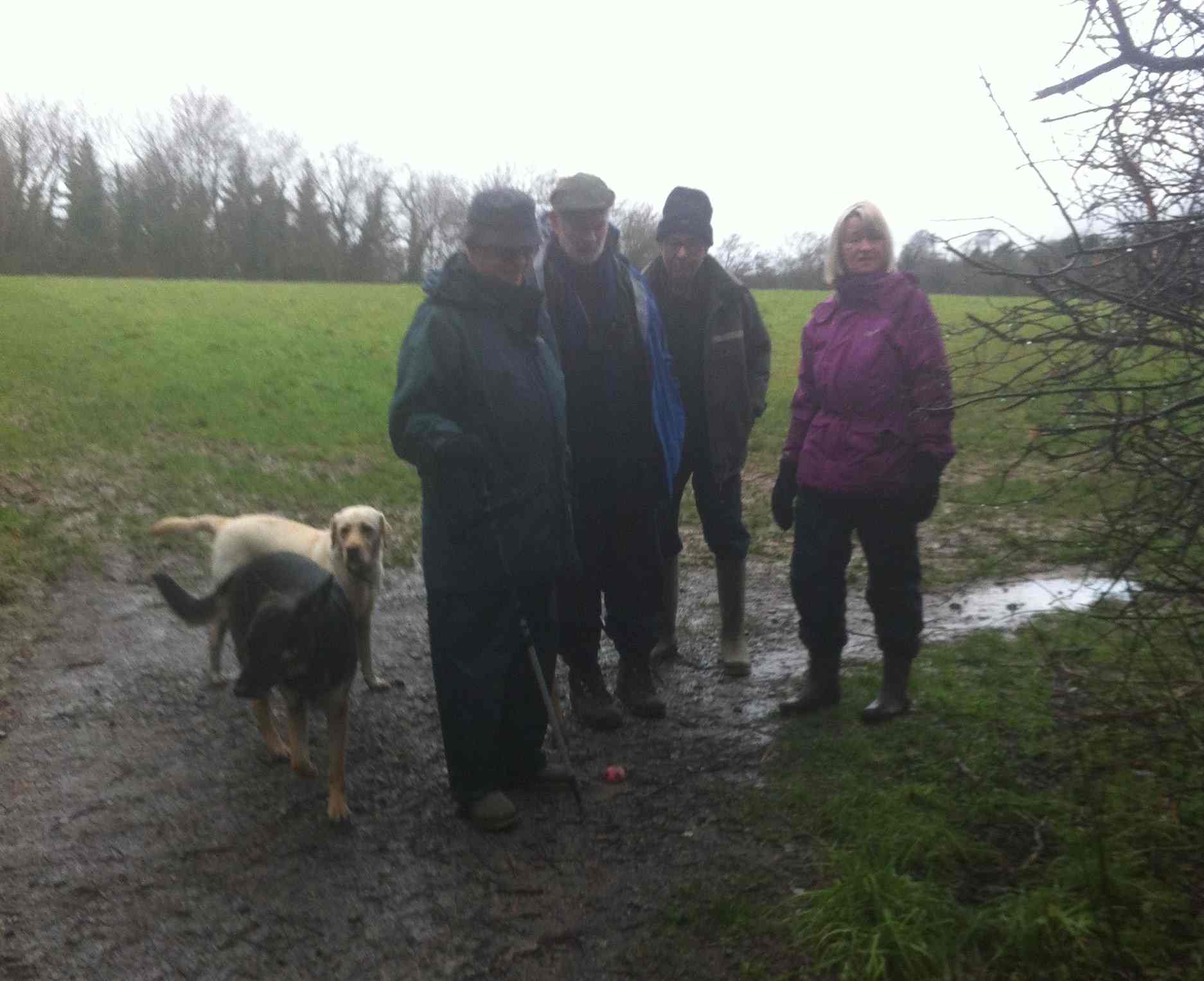
In a period of several stormy weeks we were really lucky to time things just right and have a dry and relatively calm couple of hours for our walk. Only one hardy soul turned up to accompany 3 of the Friends with another regular walker joining us for a little way. It was a shame there were not more takers but folks could hardly be blamed for staying indoors given the uncertain weather and the very muddy conditions.
We have 39 species of trees/shrubs in Selsdon Wood including 7 evergreens (see the listing below). Oak dominates the canopy and Hazel the understory. On our walk we were able to identify all of the evergreens and 17 of the deciduous trees which have clear distinguishing features visible at this time of the year. (Bold shows the species seen and the comment in bracket gives the key identifying features.)
Alder (woody round female catkins and dangling male catkins in high branches), Ash (stubby black buds and keys still attached), Beech (leaves still attached, slender buds), Birch (silver bark, lacy upper twigs), Blackthorn (thorns), Buckthorn, Buddleia, Cherry (shiny bark with horizontal slash lenticels), Bird Cherry, Chestnut (Sweet) (leaf litter, grooved bark with grooves spiralling), Crab Apple, Dogwood (red stems), Elder (distinctive pitted bark), Elm (distinctive lenticels on bark):, Field Maple, Gorse (low growing evergreen, yellow flowers), Hawthorn, Hazel (dangling catkins), Holly (distinctive leaves and berries), Hornbeam, Horse Chestnut, Larch (cones, Xmas tree profile, not evergreen), Laurel (large, glossy leaves), Lime, Oak (stubby brown buds, rounded profile), Turkey Oak (hairy buds), Pine (long needles, cones, distinctive profile), Plum, Poplar (rhomboid lenticels), Privet (semi-evergreen), Rose (hips still attached), Rowan, Spindle (distinctive pink berries), Spruce (Xmas tree profile), Sycamore, Wayfaring Tree, Whitebeam, Willow, Yew (bushy, leaves in the form of short flattened needles).
To find out more about the trees of Selsdon Wood download the tree spotters guides from the Flora page of this website.
The gallery below shows photographs taken on some of the walks in 2011-2013.
Hover over each photo for details or click to see full size.
Children's Woodland Fun - 10th November 2013 - led by & report by Meike Weiser - photo by Linda Morris
After days of rain, Sunday 10th November started with bright sunshine, which might be the reason for the fantastic turnout. More than 50 people, parents, grandparents, children and friends gathered in the car park for an afternoon of forest school inspired woodland fun.
Meike Weiser, Community Partnership Officer for LB Croydon, led the group up towards Stephen’s Larch, investigating trees and other autumn treasures along the way. Camp was established by a bench and everyone went out to gather kindling and fallen twigs for the marshmallow fire later. The large group was then split into two, with one group making French darts* to start a competition, the other trying their hands on friction fire lighting and finding and preparing the perfect marshmallow toasting stick.
George Campbell, scout leader at 2nd Croydon, kindly organised the French dart production, amply assisted by Henry Weiser, and soon sticks adorned with paper flies soared through the air across the field.
Children in the other group had a go at producing sparks using a fire steel before lighting a small fire in the fire dish. While the fire established, everyone went in search for a live twig and sharpened one end with a potato peeler. With the help of parents everyone soon had the perfect toasted marshmallow squashed between two cookies.
The groups swapped round and by the time the sun started to disappear behind the trees a large group of happy people descended back into the car park. The feedback was overwhelmingly positive and the aim of the event ‘to enable families to enjoy the outdoor with their children’ was clearly achieved.
For more information about forest school and nature play in the borough please contact Meike Weiser at biodiversity@croydon.gov.uk
* a French dart is a stick with a paper fly attached to the end used for a game of hitting the target - a ring of ivy on the ground.
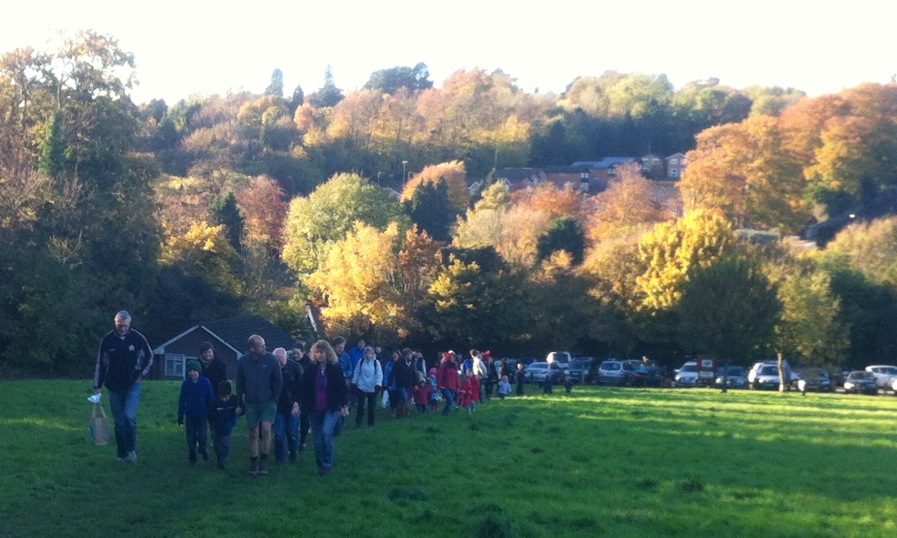
Autumn Fruit & Fungi Walk - 13th October
2013 - led by Jane McLauchlin - report by Ted Forsyth - photo by Neale Fox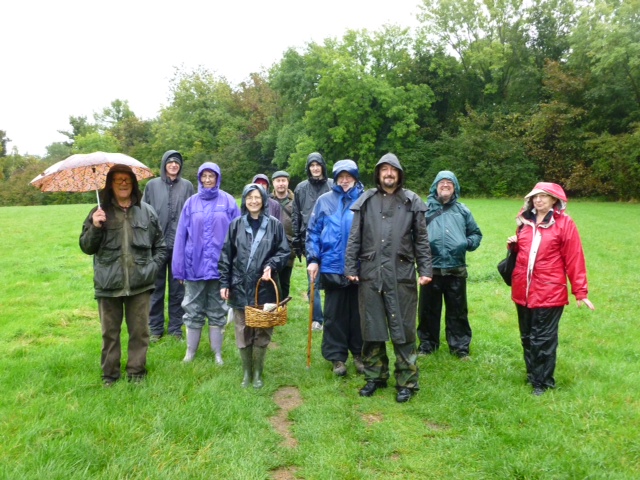
When
I arrived in the car park this morning it was almost empty. When I
noticed Jane arrive I joined her and two other people, followed by Neale
and Karen, then a stream of others, eventually totalling 12 including
Jane. After brief discussion we decided to brave the elements and set
off up Greenhill Way to get under the trees - the rain was pouring down.
For about an hour and 45 minutes we squelched up Greenhill Way and
along David's Path - the usual route we have taken in previous years.
Jane was recording what we found on a waterproof tablet using a pencil.
By the end we had seen over 30 species and Jane was taking away more for
later identification, probably raising the total to nearer 40. Among
those we have never recorded in the wood before were Horn of Plenty
(which Jane would probably eat tonight!), a Waxcap, a Woodwax, a Coral -
some of which are still to be identified. When we stopped we were all
thoroughly soaked but happy. (The 43 species seen are listed below left - thanks to Jane
McLauchlin for this list.)
Amanita muscaria (Fly Agaric), Armillaria gallica (Bulbous Honey Fungus), Armillaria mellea (Honey Fungus), Auricularia auricula-judae (Jelly Ear), Bolbitius vitellinus (Yellow Fieldcap), Clavulina cineria (Grey Coral), Clitocybe dealbata (Ivory Funnel), Clitocybe nebularis (Clouded Agaric), Colletotrichum liliacearum (Bluebell Spot), Collybia butyracea (Butter Cap), Collybia dryophila (Russet Toughshank), Collybia maculata (Spotted Toughshank), Coprinellus micaceus (Glistening Inkcap), Craterellus cornucopioides (Horn of Plenty), Crepidotus variabilis (Variable Oysterling), Exidia nucleata (Crystal Brain), Hygrocybe chlorophana (Golden Waxcap), Hygrophorus eburneus (Ivory Woodwax), Hypholoma fasciculare (Sulphur Tuft), Inocybe geophylla (White Fibrecap), Inocybe sp (a Fibrecap), Laccaria amethystine (Amethyst Deceiver), Lactarius pyrogalus (Fiery Milkcap), Lactarius subdulcis (Mild Milkcap), Lycoperdon perlatum (Common Puffball), Lycoperdon pyriforme (Stump Puffball), Marasmiellus ramealis (Twig Parachute) - on bramble stems, Meripilus giganteus (Giant Polypore), Mycena epipterygea (Yellowleg Bonnet), Mycena galericulata (Common Bonnet), Mycena pura (Lilac Bonnet), Phlebia radiata (Wrinkled Crust), Piptoporus betulinus (Birch Polypore), Rhopographus filicinus (no common name) - black patches on bracken stems, Rhytisma acerinum (Tar Spot) - on Sycamore leaves, Russula amoelens (a Brittlegill), Russula nigricans (Blackening Brittlegill), Schizopora paradoxa (Split Porecrust), Septoria cornicola (Dogwood leaf spot), Trametes hirsute (Hairy Bracket), Trametes versicolor (Turkeytail), Tricholoma lascivum (Aromatic Knight), Xylaria hypoxylon (Candlesnuff fungus)
Open Day Walks - 1st Sept
2013 - report by Ted Forsyth
The first walk at 12.30pm was attended by a couple who were both using sticks. We strolled up to the new seat, along past Jubilee Plantation, up past the Marjoram clump in David’s Crook, across one of the grass paths then back along Greenhill Way to the gazebos. We discussed Ash dieback disease, pointed out the Hemp Agrimony in Jubilee & its association with butterflies, mentioned the history of our association with the plantation and the 250 tree whips we have planted and the 60 planted by the Brownies, noted the Buddleia opposite the Jubilee, identified most of the trees and bushes leading up to the Marjoram, added in some tales about finding Brown Hairstreak butterfly eggs on Blackthorn (unfortunately not in Selsdon Wood), found a Meadow Brown butterfly in David’s Crook and several distant flying white butterflies, and generally responded to questions. The walk lasted exactly one hour.
The second walk began at 2.30pm and followed the same route with five ladies including one young girl. With the help of their very sharp eyes we saw Small Copper, Gatekeeper, Meadow Brown, Brown Argus butterflies all near the Marjoram. I pointed out the smooth feel of a Hazel leaf and compared it with the sandpaper feel of an Elm leaf and mentioned he association of the tree with White-letter Hairstreak butterflies (which we have not found in the wood). I mentioned Purple Hairstreaks at the top of Oak trees feeding on aphid honeydew (many were surprised at butterflies being found at the tops of trees), and the elusive Brown Hairstreaks with males at the top of a high “master” tree, visited by females who then disperse to lay their eggs on young Blackthorn twigs. I mentioned a story I heard at a Butterfly Conservation AGM where a group in Oxfordshire knew they had the butterfly in a few 1km map squares, but when they searched for eggs they realised the butterflies were in most of the squares in their area. I also said that some of my friends search for the eggs on Bookham Common on first of January and usually find them. The sharp eyes of the group spotted a scattering of small red galls on the leaves of a Field Maple and when we examined them more closely we found a larger second type like a very small marble (both unidentified). There were many questions which seemed to be answered to their satisfaction and the group were certainly interested. I also mentioned Silver-washed Fritillaries and Clouded Yellows and showed pictures of Wasp Spiders and Crab Spiders though we did not see any.
I had with me several identification sheets for butterflies, spiders, grasses, moths and caterpillars with the butterfly chart being the most useful as I was able to point out the butterflies we were seeing and to show the differences of male and female. I also talked about some trees having separate male and female, like Holly, which seemed to surprise some of the group.
Minibeast Hunt - Wednesday 21st August 2013 - report by Heather Govier
The weather was superb for this summer’s Minibeast Hunt, sunny and warm with not too much wind. The event was well attended with 18 adults accompanying 23 children, and four FSW volunteers supporting the leaders Roger Hawkins and Vic Wallace.
Roger introduced the activity, demonstrating the use of the nets and distributing collecting tubes, then everyone dispersed around the car park field to see what could be found. Later the group walked up Greenhill Way and back round through David’s Crook to look for butterflies on the marjoram patch.
Roger, Vince and FSW member, Tony Flecchia, were able to help
with the identification and at least 16 different species were found:
24
Spot Ladybird, 7 Spot Ladybird, 14 Spot Ladybird (yellow), Common Crab Spider,
Gatekeeper Butterfly, 6 Spot Burnett Moth (and many of the empty papery chrysalises in the long grass), Oak Bush Cricket (female), Ant Damsel Bug,
Meadow Grasshopper, Cuckoo Bee, Silver Washed Fritillary Butterfly, Straw Dot
Moth, Common Blue Butterfly (female), Small Copper Butterfly, Meadow Brown Butterfly,
Common Earwig (male, female and juvenile).
Bats & Moths Thurs 8 August 2013 - report by Ted Forsyth - photo by Neale Fox)
Forty people came to participate in this dual event. 8.15pm was probably slightly too early and 8.30pm would have been better. We walked slowly up to the end of Langford’s Way and stopped in Leafy Grove to wait for some batty action. Every few minutes I switched on the detector in the hope of registering the presence of a hunting bat and continued doing this until a Pipistrelle Bat flew in front of the group and caused the detector to produce an appropriate noise. After several more flypasts we moved to the edge of the nearby Great Field and were rewarded by a continuous show by one to three bats which came very close to the group. We remained at that spot for some time to allow the light to fade so that the moth trap in the car park could catch something. Around 9.15pm we returned to the trap where Malcolm had overcome some difficulties and the moths had started to arrive. At least 30 people remained for more than an hour listening to Malcolm’s tales while we waited for more moths to enter the trap. Eventually the trap was opened and moths were identified. Malcolm has supplied a list of what was seen:-
Muslin (male), Dun-bar, Dark Umber, Orange Swift, Buff Arches, Currant Pug, Narrow-winged Pug, Yellowshell, Sallow Kitten, Coxcomb Prominent, Flame Shoulder, Nut-tree Tussock, Straw Dot, Bee Moth, and several Crambids, probably C.culmella.
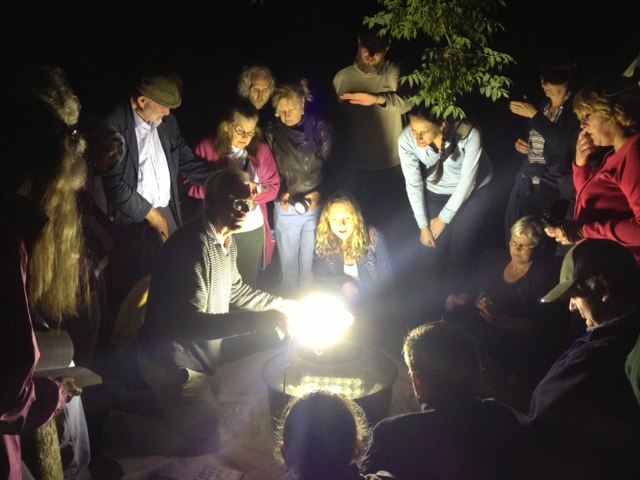
Selsdon Wood Butterfly Walk Sat 20 July 2013 - report by Ted Forsyth
After a long period of hot weather we were faced with changed conditions and on an overcast day, with a cool breeze blowing, a dozen or so people gathered for the walk. On Greenhill Way we began to separate Meadow Browns from Ringlets and had many opportunities to repeat the process as these were the most numerous butterflies, though numbers were much reduced from totals on warmer days. Marbled Whites and Gatekeepers appeared in small numbers but that ended the list of species until the very end when one lady said she had seen a single Large Skipper. Many 6-spot Burnet Moths were seen but, surprisingly, we were not able to find any of the empty papery chrysalises which usually adorn the long grasses. It was a disappointment to miss species which were so visible earlier in the week, such as Comma, White Admiral and Silver-washed Fritillary.
Flower Walk in Selsdon Wood led by Malcolm Jennings Sun 16 June 2013 - report by Ted Forsyth
The route was along Vale Border to Field 2, diagonally across to the next tree belt, through by the badger sett, diagonally across Field 3, up the edge of the trees and into Great Field, along Stevens Walk and back to the car park. About 20 people attended.
Species seen:Cow Parsley, Wall Barley, Rye Grass, Cocksfoot, Daisy, Dandelion, Bulbous Buttercup, White Clover, Ribwort Plantain, Broad-leaved Plantain, Hogweed, Red Clover, Goats Beard (Jack-go-to-bed-at-noon), Lesser Stitchwort, a Hawksbeard, Dog Rose, Greater Yellow Rattle, Meadow Buttercup, Oxeye Daisy, Birdsfoot Trefoil, Scabious, Common Sorrel, Germander Speedwell, Knapweed, Black Medick, Catsear, Bladder Campion, White Helleborine, Sanicle, Crested Dog’s-tail, Wood Avens, Yellow Archangel, Bluebell, Enchanter’s Nightshade, Dog Violet, Woody Nightshade, Bramble, Herb Robert, Black Bryony, Dogs Mercury, Wild Clematis, Perforate St John’s Wort, Wood Spurge, Cleavers (Goosegrass). Wood False Brome, Common Nettle, Bugle, Creeping Buttercup, Cuckoo Pint, Broad Buckler Fern, Bracken, Male Fern, Broad-leaved Helleborine.
Field Maple with galls and Harlequin Ladybird, Turkey Oak, Sessile Oak, Hornbeam, Privet, Elder, Hazel, Wild Cherry, Larch, Hawthorn, Sycamore, Wayfaring Tree.
30 people joined the walk which passed through Greenhill Way and David's Crook to reach Bluebell Grove where the Bluebells had at last produced a wonderful show. Relatively few bird species were encountered but throughout the walk the many Robins lazily released their mouthfuls of notes and Blackbirds threw in an odd phrase or two. The Song Thrush repeated its short song in case we had missed it the first time. Great Tits punctuated the chorus with their simple "teacher, teacher" calls.
In some parts of the wood the Wood Anemones had already gone to seed while elsewhere they still carpeted the ground with flower. Yellow Archangel displayed its bright yellow flowers while Wood Sorrel was still in leaf. In Courtwood Grove, where we paused to admire the Early Purple Orchids, there were many Bird Cherry bushes covered in flower. A brief exit from the wood at The Cascades allowed us to see the Herb Paris. Back in the wood we followed Broad Walk then crossed Great Hill to the Centenary Plantation for an unsuccessful hunt for five White Helleborines I had found earlier. Rather than inadvertently trample the plants we left and returned to the car park.
Hunt the Bluebell Walk 27th April 2013 - report by Ted Forsyth - photos by Andrew Smith
I walked through the wood to join the others at the car park and had almost reached there when a Swallow flew across skimming the tops of the grass.
About 30 people came to the Hunt the Bluebell Walk. We began by walking up Greenhill Way admiring the Wood Anemones and comparing the flowers when we found a clump of Wood Sorrel in flower. A small plant attempting to open whitish flowers was probably a Bittercress. Scattered groups of Dog Violets grew by the sides of the paths and a few yellow-flowered Lesser Celandine were seen. Yellow Archangel had not yet reached the stage of producing its yellow flowers and Garlic Mustard was showing only a few leaves. Bursts of song were heard from Robins, Wrens and Blackbirds and by the time we reached Farleigh Border the loud notes of a Mistle Thrush drifted down from the tree tops.
In East Gorse Raspberry canes by the path marked the route to the only group of Toothwort we know in the wood. Luckily several of these unusual parasitic plants had appeared over the past week.
A drumming Great Spotted Woodpecker, a piping Nuthatch, and a Chiffchaff announcing its name, accompanied us as we walked to the Gorse Plantation where David described its history and explained the work we are doing in repairing benches. Via Leafy Grove, with a brief talk about our coppice area, we got to Courtwood Grove where the extensive carpet of Wood Anemones made a splendid sight. Continuing down Beech Grove, we got to the Early Purple Orchid area where we managed to find several almost in flower – some the usual purple colour and one or two which will obviously have white flowers. Opposite the Centenary Plantation Cowslips were in flower and David took the opportunity to talk about the Centenary Plantation. The walk passed the Jubilee Plantation where again the history and our recent work in clearing Wild Clematis was mentioned.
In various places we even managed to see a few scattered Bluebells but the full display probably needs another week.
Eleven intrepid enthusiasts braved the drizzle to be led by Meike Weiser (Croydon Community Partnership Officer), ably assisted by her son Henry, to identify the young growth of trees in Selsdon Wood. As so often happens on our walks, we only had to arrive at the tree belt between fields 1 and 2 to start finding plenty of twigs to look at. On the walk Meike helped us to identify the deciduous trees by following the steps from the ‘What’s That Tree’ chart which is summarised below:
A. Buds on opposite sides:
buds black – Ash
or buds fat & green – Sycamore
or buds small, flattened brown – Field Maple
or buds sticky – Horse Chestnut
or twig red – Dogwood
B. Buds on alternate sides:
twig thorny - twig red-brown – Hawthorn or twig grey-black – Blackthorn
or twig hairy: buds green – Hazel or buds brown – Elm
or twig plain: buds thin & pointed, sticking out – Beech or lying flat – Hornbeam
or twig zig-zagged – Lime
or twig is ridged – Sweet Chestnut
If none of the above:single end bud – Willow or end bud cluster – Common Oak
We also identified Yew, Larch, Norwegian Spruce and Scots Pine. We saw new Hazel catkins and found its tiny red female flowers. When looking along the top or east side of field 3 we found common or Pedunculate Oak and Turkey Oak with its hairy acorn cups. We finished, a little early, by looking along the south-east side of David’s Crook at White Poplar with rhomboid lenticels in its bark, an ancient Wild Cherry and a small clump of Alders. A very informative, if a little damp, morning. We all appreciated Meike’s expertise. Woodland Trust offer a useful pamphlet ‘Winter Twigs’ with coloured pictures at naturedetectives.org.uk.
Sunday 14th October 2012 - Discover Autumn Fungi and Fruit - with Jane McLauchlin
Armillaria mellea (Honey Fungus) - Auricularia mesenterica (Tripe Fungus) - Collybia dryophila (Russet Toughshank) - Collybia peronata (Wood Woollyfoot) - Coprinus micaceus (Glistening Inkcap) - Cortinarius triumphans (Birch Webcap) - Crepidotus sp (an Oysterling) - Daldinea concentrica (King Alfred's Cakes) - Diatrype disciformis (Beech Barkspot) - Hypholoma fasciculare (Sulphur Tuft) - Hypoxylon fragiforme (Birch Woodwart) - Lactarius quietus (Oakbug Milkcap) - Lycoperdon pyriforme (Stump Puffball) - Macrolepiota procera (Parasol) - Meripilus giganteus (Giant Polypore) - Mycena crocata (Saffrondrop Bonnet) - Mycena galericulata (Common Bonnet) - Mycena haematopus (Burgundydrop Bonnet) - Mycena pura (Pink Bonnet) - Mycena sp (tiny white one) - Mycena vitilis (Snapping Bonnet) - Piptoporus betulinus (Birch Polypore) - Polyporus leptocephalus (Blackfoot Polypore) - Polyporus squamosus (Dryad's Saddle) - Rhytisma acerinum (Tar Spot on Sycamore leaves) - Rutstroemia firma (Brown Cup) - Stereum gausapatum (Bleeding Oak Crust) - Stereum hirsutum (Hairy Curtain Crust) - Trametes versicolor (Turkeytail) - Trochila ilacina (Holly Speckle) - Vuilleminia comedens (Waxy Crust) - Xerula radicata (Rooting Shank) - Xylaria hypoxylon (Candlesnuff Fungus) - Xylaria longipes (Dead Moll's Fingers)
Our walks on the FSW Open Day on Sunday 2nd September were led by Ted Forsyth. Both walks went very well with about eight participants on each. In the first walk there was a family with a small boy who, every time Ted showed a berry, would ask "Is it edible?". It became a standing joke which all anticipated when the next fruit, berry or nut appeared. On the second trip there was a couple in which the young woman was deaf and her partner asked lots of questions and passed the answers on to her. They made a point of finding Ted later to thank him for the walk.
The route was Greenhill Way, Pool Grove, Middle Gorse, The Wend, Centenary, Jubilee - with items of interest pointed out along the way including the difference between Common Hawthorn and Midland Thorn in leaves and in berries, our single specimen of a Broad Leaved Helleborine and Raspberry canes in Middle Gorse. On the second walk a gent asked about the Oak trees near Centenary and the strange acorns. Ted explained that these were galls and discussed the differences between Pedunculate, Sessile and Turkey Oak and was able to show them the Turkey Oak in the gap to the next field.
Approximately 50 people, including many children, supported this event. At least six bat detectors were in use as we walked along the edge of Stevens' Larch but it was not until we entered Leafy Grove, by our coppice area, that the detectors began to respond to the presence of Pipistrelle bats. The bats could be seen as they sped above our heads or showed as silhouettes against the sky, causing much excitement. Meike Weiser's input was much appreciated (as was the loan of two of the detectors).
We walked back towards the car park where Malcolm Bridge had set up his moth trap, still hearing occasional bursts of sound from the detectors. We also heard an occasional call from a Tawny Owl. Once we were crowded around the bright light of the mercury vapour lamp Malcolm talked about moths and their habits and introduced local moth expert, Bernard Skinner. Moths frequently flew around the trap and some were quickly identified. At one point a large dark moth crashed through the group - an Old Lady Moth. The trap was sitting on a white sheet and several of the moths preferred to settle on this, making it easier for identification.
Moths recorded included: Dun-bar, Chinamark, Speckled Yellow, Common Swift, Orange Swift, Brimstone, Old Lady, Black Arches, Yellow Underwing, Mother of Pearl, Double Square Spot.
Try looking at the website www.ukmoths.co.uk to see what some of these species look like, or to identify any you find yourself.
Butterfly Walk Sat 14 July 2012 (15 attendees including 2 children) - report by Ted Forsyth
I walked across the wood to join the group and while passing through David's Crook during a sunny period I found more than a dozen Meadow Browns, a couple of Ringlets and a single Marbled White.
Once the walk began we saw several Meadow Browns on our way up to the wood, fluttering in the grass or perched on Knapweed. There were many Pyramidal Orchids in flower. As the rain fell we sheltered in the edge of the wood while Malcolm Bridge showed pictures of butterflies and mentioned some of their habits. In reply to a question about introduced species he regaled us with the story of the extinction of the British population of the Large Blue and its re-introduction using the Swedish sub-species. He told us the intriguing life of the caterpillar with its need to be taken into an ants' nest to be cared for by the ants and to feed on the ants' grubs. Another question related to changes in species in this country which he illustrated by reference to the Jersey Tiger moth which is now moving slowly north.
With a slight lull in the rain we continued our walk past the Jubilee Plantation and into David's Crook where we saw more Meadow Browns and several Ringlets. By the time we got to Linden Glade and had sheltered for a short period It was obvious that the rain was not going to stop so we reversed direction and returned to the car park.
While Malcolm's talk had been worthwhile it was a pity the weather had not been better as we had seen before and after the walk species such as Silver-washed Fritillary, Marbled White and White Admiral.
Photographs of this walk are included in the gallery above.
Species seen on Malcolm Jennings’ walk on Sunday 17 June 2012 - report by Ted Forsyth
The walk began along Vale Border until field 3 then up the side of the field, round the Centenary Plantation, across to Stevens Walk, round the Jubilee Plantation and back to the car park.
We started with Dog Rose, a possible Plum, Wild Clematis, Daisy, Black Bryony, Nettles and Cow Parsley. A large Red Admiral butterfly flew along the hedge and a Blue Tit perched at the top of a tree. Crab Apple, Wood Avens and Meadow Buttercup quickly followed, then a 7-spot Ladybird and a tiny green Weevil were found. Dock, Hogweed, Goatsbeard, White and Red Clovers, Ox-eye Daisies, Dandelion, Ribwort Plantain, Lesser Stitchwort, Greater Yellow Rattle, Birdsfoot Trefoil, Hawkbit and Elder in flower brought us to the end of the first field.
Quickly moving on to the third field, we turned right up the edge, noting Germander Speedwell at the beginning and Red Osier Dogwood and Privet in the hedge. Hornbeam and Whitebeam growing next to one another were compared. A few Long-horned Moths were seen and a Meadow Brown butterfly. Greater Plantain and Peforate St John’s Wort were identified, and the last of the White Helleborines was pointed out at the base of a Hazel.
Outside the Centenary Plantation we stopped to look at the only Broad-leaved Helleborine in the wood before moving across to Jubilee Plantation to look at the Yellow Irises in the pond. The common Dogwood was seen in the plantation. A few grasses were identified – Cocksfoot, Wall Barley and Crested Dog’s Tail. Some Pyramidal Orchids were beginning to open up and a Speckled Wood butterfly appeared. Cut-leaved Cranesbill was found. At a corner of the Jubilee Plantation we looked at the caterpillar of an Orange-tip butterfly on Garlic Mustard. Spear Thistle and a probable Sow Thistle were inside the plantation.
We then returned to the car park.
Discover Spring Birds Walk 13th may 2012 - report by Ted Forsyth
As
about eight of us gathered to begin the walk two Ring-necked Parakeets
and a Jackdaw flew over. As we walked up to the Farleigh Border the most
frequent song came from Blackbirds with Robin close behind. Smaller
numbers of Wren, Chaffinch, Blue Tit, Great Tit and Song Thrush were
heard. Great Spotted Woodpecker was heard several times and one one
occasion made a brief appearance. In Beech Grove Blue Tits were seen at
a nest hole, including adults entering with food. Surprisingly, we did
not detect Nuthatch which suggests the timing of the walk should have
been earlier in the day.
While keeping eyes and ears open for
birds, we also identified plants. Among those recorded were Yellow
Archangel, Cuckoo Pint (Wild Arum), Stitchwort, Garlic Mustard. The
clump of Toothwort was examined but the plants were well past their
best. Towards the end of the first section of Beech Grove was a large
Bird Cherry still showing some flower and nearby a smaller version
seemed to be in full flower. Oak Apple Galls were found and
photographed. In a couple of places we noted King Alfred's Cakes fungi.
Butterflies
included Orange-tip (see photo above), Holly Blue, Speckled Wood,
Peacock. St Mark's Flies were abundant, flying in swarms with their
legs dangling. One golden sheened Long-horned Moth (Adela reaumerella)
was seen at rest on a bush.
We ended the walk by visiting the
large group of Early Purple Orchids off Beech Grove near Broad Walk.
While most of the plants were in the usual range of reddish-purple
shades, there were several specimens which were pure white.
Photographs of this walk are included in the gallery above.
Bluebell Walk 28th April 2012
This walk, on a wet Saturday afternoon was led by Linda Morris, ably assisted by David Malins and Ted Forsyth. In spite of the weather, 7 non-Friends and 2 Friends joined us and the walk was expanded to include many other aspects of the wood as the bluebells could not really be seen at their best in the drizzle.
Photographs of this walk are included in the gallery above.
Walks in 2011
October 9th Fungi Walk with Jane McLauchlin and the Friends
About 25 people attended. The day was fine warm and cloudy and the weather had been dry. Species observed:
Armillaria
mellea, Honey
Fungus - Calocera viscosa, Yellow Stagshorn - Clitocybe nebularis, Clouded
agaric - Collybia dryophila, Russet Toughshank - Ganoderma australe, Southern
Bracket - Hypholoma fasciculare, Sulphur tuft - Hypoxylon multiforme,
Birch Woodwart - Lycoperdon perlatum, Puffball - Lycoperdon
pyriforme, Puffball - Marasmiellus ramealis, Twig Parachute - Marasmius
wynnei, Pearly Parachute - Megacollybia platyphylla, Whitelaced
Shank - Mycena pura, Lilac Bonnet - Phragmidium violaceum, purple
spots - Piptoporus betulinus, Birch Polypore - Psathyrella sp, a
Brittlestem - Rhytisma acerinum, Tar Spot - Russula atropurpurea, Dark
Red Russula - Russula cyanoxantha, Charcoal Burner - Russula
ochroleuca, Common Yellow Russula - Stereum hirsutum, Hairy Curtain
Crust - Stereum rugosum, Bleeding Broadleaf Crust - Trametes
versicolor, Turkeytail - Xylaria hypoxylon, Candlesnuff Fungus
July 23 9.15pm July Bat Walk & Moth Trap with Malcolm Bridge
On our July Bat Walk several bats were detected and seen flitting by but the highlight was our Moth Trap. Malcolm had caught a number of moths. He went on to show us photographs of moths we might see in the coming weeks. The most interesting was the Jersey Tiger moth that has extended its range from the coast to Crystal Palace. Tiger moths fly by day and night and could still be around in September.
June 25 Sat 10-12noon Summer Bird Walk with Ernie Thomason (Croydon Council Ranger)
Birds observed were: Swift, 3 Carrion Crow, Robin, Song Thrush, Great Spotted Woodpecker, Skylark, Woodpigeon, Jay, Blue Tit, Great Tit, Blackcap, Magpie, Nuthatch and Greenfinch. We also saw Meadow Brown and Ringlet butterflies and one fungus, Chicken of the Woods.
May 1 Sun 11-1pm Bluebell Walk with Ernie Thomason (Croydon Council Ranger)
We had a beautifully sunny day for a walk in the country. There were about 19 in the party, including a family with two young children. Ernie took the group on quite a long meandering route through the wood. Bluebells were very much in evidence everywhere, but Ernie was able to show many other common and unusual species. Amongst them were Cuckoo Pint, Cuckoo Flower, Dock, Germander Speedwell, Holly (there are male & female Holly trees.), Greater Stitchwort, Periwinkle. Toothwort, Primrose, Figwort and Bugle. Around half-way the youngest of our walkers left us for their picnic but they had said they had been pleasantly surprised by the delights of Selsdon Wood and would come again. The group stopped by a Friends Working Party in the Gorse area. David Malins explained how they were cutting bracken and bramble to help the gorse seedlings that had sprung up after the felling of the crowded unsafe larch plantation. He hoped that they might join the FSW and come to help the Friends. Ernie then went on to find more flowers -Yellow Archangel, Foxgloves (not yet in flower), Early Purple Orchids and Herb Paris (our logo). In the Gorses are we also saw a number of minibeasts: Green Hairstreak, Orange Tip, Small White, Brimstone and Peacock butterflies and a Wolf Spider!
The walk finished in the car park at about 1.30pm. A few people stayed to look at more of the main bluebell areas. Everyone seemed to enjoy the walk and had learned something about English wildflowers or an area that they had not known before. It was good to see people not just from the immediate locality - there were visitors from Beckenham, Norwood and East Croydon - and several took leaflets about FSW and said they would contact the FSW email for more information as they were very impressed by what they had seen of the work of the FSW today (the signs and the work activities) and by what they had heard of FSW future plans.
April 17 Sun 12-2pm Spring Bird Walk with Ernie Thomason (Croydon Council Ranger)
This walk attracted a good turnout. Birds were the main target, largely identified by their songs or calis, including many Robins, Blackcaps and Chiffchaffs. Willow Warblers do not always appear in the woods nowadays so we were pleased to discover two singing in the area where Rob Sowter has been restoring hazel coppice along The Wend. The regrowing Hazel may now be in a state to attract nesting Willow Warblers and Chiffchaffs, both of which nest on or near the ground. In Middle Gorse a Great Spotted Woodpecker had earlier been seen at a nest hole in a Birch tree but was not present when we looked at it. We usually take the opportunity to keep an eye on the plants which are coming up and found Common Figwort in places where we did not realise they grew. There was also an abundance of Blackthorn blossom. Unfortunately, after most people had left the car park, a Sparrowhawk circled overhead with its diagnostic flap, flap, flap, glide flight. The full list of birds seen is: 2 Robin,l 3 Blackcap, Willow Warbler, Chiffchaff, Blackbird, 2 Jackdaw, 4 Great Tit, Blue Tit, Carrion Crow, Nuthatch, Song Thrush, Sparrowhawk, Woodpigeon.
February 20 Sun 12-2pm Before the Buds Burst with Ernie Thomason (Croydon Council Ranger)
Ernie identified 23 trees - mainly by the shape and position of the buds and told us what each species could be used for. He found one Elm sapling - we can only wish it well. Hazel catkins and the first shoots of Bluebell and Wild Arum peeping through the soil were amongst the early signs of Spring. Birds observed were: 5 Blackbirds, Coal Tit, 4 Robins, 4 Woodpigeons, Great Spotted Woodpecker drumming, Green Woodpecker, Nuthatch, 7 Blue Tits, Wren, 2 Song Thrush, 2 Dunnock, 2 Great Tit and 2 Jay.
January 22 Sat 12-2pm Winter Walk with Ernie Thomason (Croydon Council Ranger)
There was a good turnout for this walk the highlights of
which were the sounds of the Great Spotted Woodpecker drumming and distant
views of a flock of Redwing high in the trees. Other bird species seen were:
Woodpigeon, Carrion Crow, Magpie, Robin, Blue Tit, Great Tit, Blackbird and
Jay.
Summary of the Open Day Walks Sept 5th 2010 - report by Ted Forsyth
The first walk was nominally from 12.30 to 1.30pm and was attended by about ten people. The second, towards the end of the day, had a nominal time span of 3.00 to 3.45pm and had an attendance of approximately eighteen. Though the walks followed the same route there were some differences in the things I pointed out, possibly through distraction at the appropriate moment, and in the case of the second walk because I felt I was sprinting. Next year we should arrange the same time span for both walks.
Starting in the car park field I pointed out the large amount of Bramble and said that the experts reckoned there were around 400 kinds of bramble including hybrids – not something for amateurs to try to separate! In the hedge along the right side of this field there were Hazel, Ash, Wayfaring Tree and Dogwood.
On entering the woodland on Greenhill Way I pointed out Elder and Hawthorn. A Spindle with its pink fruits and a Wild Clematis (Old Man’s Beard) were shown. Two of the trees with winged seeds – Sycamore and Field Maple were found and later, at the far end of Vincent Avenue, they were compared with the third of the trees with winged seeds – Norway Maple. Norway Spruce was also in Vincent Avenue. On one of the walks we spotted a large Dryad’s Saddle fungus growing on a large piece of fallen timber. There was a large quantity of beechmast being crunched underfoot, having fallen from the Beech trees.
I had samples of the three Oaks and was able (with the first walk) to show the Sessile Oak (stalked leaves, no stalk on the acorns), Pedunculate or English Oak (no stalks on the leaves, long stalks on the acorns – also with galls in the example), and the Turkey Oak (deeply serrated leaves and acorns with whiskers) though we did not get to examine the trees.
Returning to Greenhill Way we found Wood Avens (Herb Bennett) and Enchanter’s Nightshade, two plants which are weeds in my garden.
Before exiting the woodland on to David’s Crook we saw a Cherry Laurel on the left. In David’s Crook the Blackthorn bushes had a heavy crop of sloes. I pointed out the two Scots Pine and a Larch at one end of David’s Crook, a Silver Birch at the other end and the White Poplar just before the entrance to Pool Grove.
In Pool Grove there was a Rowan showing its orange berries, and a
Sweet Chestnut covered in its spiky
husked nuts. By the old bird pool
there was a large female Holly with
a huge crop of berries, some of which were changing from green to orange, and
nearby is the only Small-leaved Lime
that I am aware of in the wood.
Continuing on the right hand part of West Gorse and then down East
Gorse, I showed the Raspberries
growing and fruiting all along the path edge. A large Wild Cherry,
with the distinctive horizontal corky bands on the trunk, was seen at the edge
of the path. On the right, where
there is an exit to Baker Boy Lane, we looked at the Horse Chestnut and remarked on its propensity for dropping large
branches unexpectedly – a habit it shares with Beech, possibly because of the
weight of the heavy branches rather than disease. Somewhere on this part of the track there was Rosebay Willowherb. I mentioned the clearing of Bracken and the regenerating of the Gorse, and tried to distinguish between
Bracken and Ferns. Following the curve of East Gorse, we
found Greater Plantain on the path
and a few examples of St John’s Wort,
Ragwort, Buddleia and Common Knapweed.
Fruit, berries, nuts, etc which we were able to see (though not always very numerous) included black Dogwood berries, obvious Elderberries, Brambles and Raspberries, a few black/green/red berries of Wayfaring Tree, and a single Yew berry on a tree in Vincent Avenue (though there are Yews all over the wood). At the bottom of Vincent Avenue is English Elm, which I did not mention – it may be worth examining in the summer for breeding White- letter Hairstreak butterflies, if there are any in the wood!
At the bend in East Gorse, we could have taken the short path which leads on to The Wend and down to Courtwood Lane. A hundred yards down this track there is a Crab Apple on one side of the path and a tall Goat Willow on the other. The Willow has a rather distinctive patterned bark and the Crab usually has fallen apples underneath. At the end of the walks, we noticed a tree in the hedge near the car park laden with a huge crop of apples. Close examination showed it to be a Crab – which could easily be pointed out on a walk.
When we found a straggly bit of Honeysuckle I mentioned that it was favoured by the White Admiral butterflies for laying their eggs but they would avoid magnificent big clumps of Honeysuckle. The brambles, when in flower, next to the old bird pool were attractive to a number of species of butterflies in the summer.
The route now entered The Wend and just before it came to the grassy area of Great Field we stopped to examine the Midland Thorn. On the first walk I had pulled off a berry and found that it contained a single stone which is usually a sign of a common Hawthorn. On the second walk we tried three more berries and found each contained two stones, so I am happy with the identification. We were able to compare the deeply serrated common Hawthorn leaves with the almost non-serrated Midland Thorn leaves. I am sure that elsewhere in the woods there may be hybrids between the two. I also mentioned that there are two Birches, Silver Birch and Downy Birch which also hybridise. We had a look at the Dryad’s Saddle fungus in Steven’s Walk but it was well past its best. We then returned to the car park.
Near the end of a walk, Beech and Copper Beech were pointed out in the hedge between the fields.
Even though they were long gone, I mentioned the 100 or so Pyramidal Orchids which appear at the top of the car park field – it might whet the appetite of people who would normally march up Greenhill Way without noticing the orchids partially hidden in the long grass.
Bird Walk Sunday 16th May 2010 - report by Ted Forsyth
The walk was attended by about fifteen people and recorded the following species (and a few others): Song Thrush, Jackdaw, Blackbird, Robin, Chaffinch, Magpie, Carrion Crow, Wren, Collared dove, Woodpigeon, Blue Tit (including entering nest box C), Great Tit, Blackcap, Garden Warbler, Chiffchaff, Jay, Great Spotted Woodpecker and Greenfinch. The Garden Warbler has not been seen in the wood in recent years and may simply be passing through to another destination. On this occasion it obliged by remaining in the branches above our heads and singing continuously.
Helped by Ernie Thomason we identified plants - Pignut. Sanicle, Wood Sage. Germander Speedwell, Heath Speedwell, Cow Parsley, Greater Stitchwort, Raspberry, Gorse, Buddleia, St John's Wort, Wild Strawberry, Garlic Mustard (one plant had three Orange Tip butterfly eggs attached). We were also shown a large Hornbeam. We looked at the Early Purple Orchids off Broad Walk, including five pure white specimens. A recent count found over 120 specimens in this area.
Selsdon Wood Walks etc pre
2010
- info from the Log Books 2002-2008 of Ernie Thomason, Selsdon Wood Park Ranger
2008
11th October - Possible Fungi Walk with Jane Mc 12 noon
7th September - Possible FSW Open day - to be confirmed
6th September - Possible Tree walk 10am
30th August - Bat & Moth Night - John Humpherys + I child
26th July Butterfly walk 10am
5th July - Summer Wildflower walk 12 noon
14th June - Summer Bird Walk 10 am
3rd May - Dawn Chorus - 5 am (15 people)
26th April - Wildflower Walk (70-80 people)
2007
29th September - Before the Leaves Fall - Winter tree ID walk 12 noon
23rd June - Summer Bird Walk 10 am
12th May - Spring Wildflower Walk 12 noon
8th May - Selsdon Wood to Farleigh -long alk through surrounding countryside led by Country Park Ranger, Tom Saunders
7th May - Bluebells & Orchids led by Malcolm Jennings
21st April - Dawn Chorus - 5 am
24th February - Before the Buds Burst - Winter Tree ID 12 noon (16 people)
20th January - Winter Bird walk 10 am
2006
16th September - Late Tree ID Walk 12 noon
19th August - Bat & Moth Night 8.00 pm (booking required)
22nd July - Summer Wildflower walk 12 noon
24th June - Summer Bird Walk 10 am
31st May - BCTV putting in steps on Addington Border 10 am
17th - 18th May BTCV laying French Drain on Greenhill Shaw path 10am
29th April - Spring Wildflower Walk 12 noon
22nd April - Dawn Chorus - 5 am
18th February - Before the Buds Burst - Winter Tree ID 12 noon (25 people)
21st January - Winter Bird walk 10 am (27 attended)
2004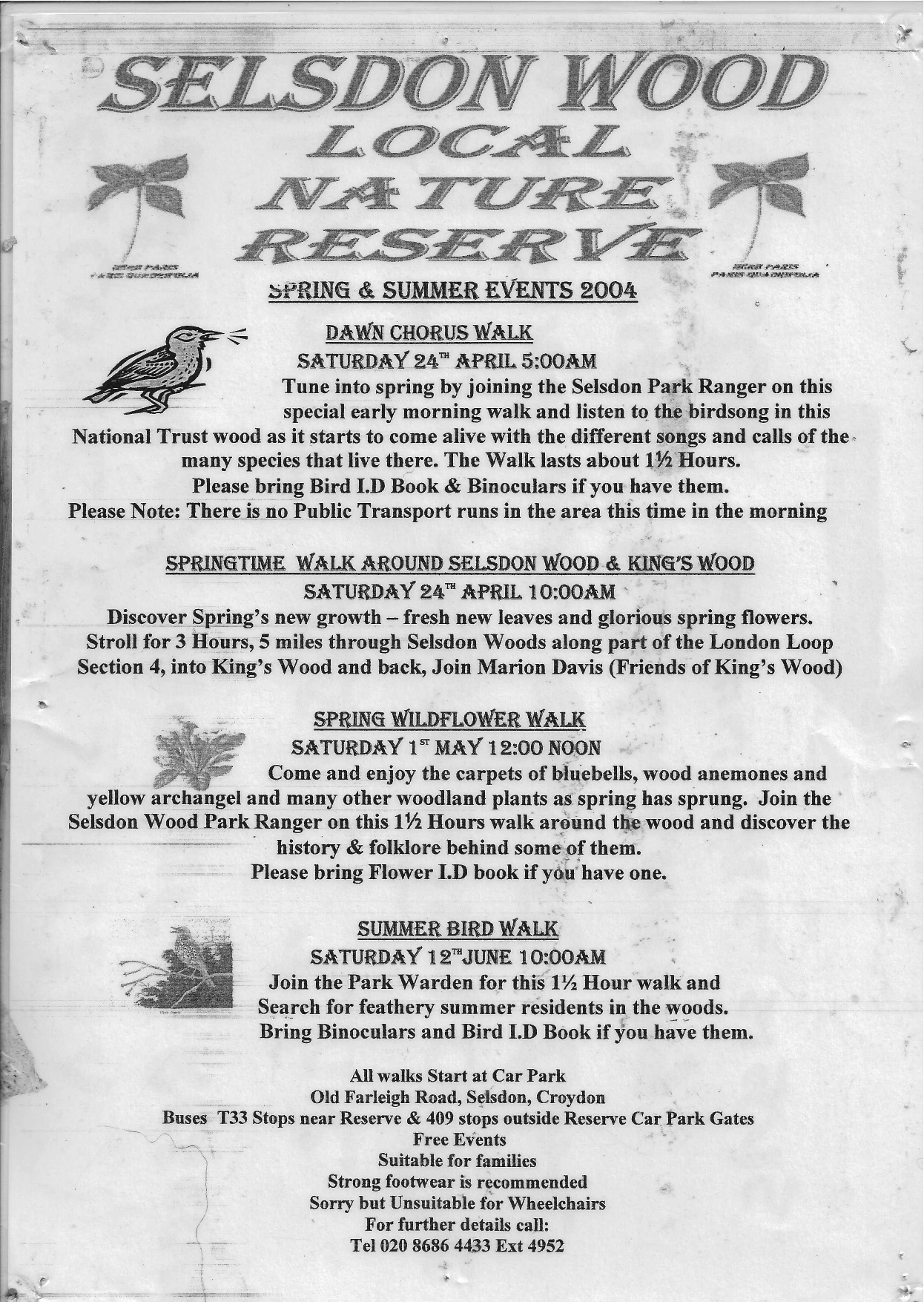
21st August - Bat & Moth Night 8.30 pm - 11.30 pm - limited numbers
3rd August - Male seen by lady dog walker naked doing a sexual act on himself - no description - called Addington Police
19th June -
Workday with SWAG 10.30 am to trim vegetation along walking routes & from
around seating - contact John
12th June - Summer Bird ID walk 10 am - Join the Park. Warden for this 1½ Hour walk and Search for feathery summer residents in, the woods. Bring Binoculars and Bird I.D Book if you have them.
1st May - Wildflower Walk - 12 noon (22 people) - Come and enjoy the carpets of bluebells, wood anemones and yellow archangel and many other woodland plants as spring has sprung. Join the Selsdon Wood Park Ranger on this 1½ Hour walk around the wood and discover the history & folklore behind some of them. Please bring Flower I.D book if you have one.
24th April - Springtime Walk through SW/Loop/Kingswood 10am 3 hour walk 5 miles with Marion Davis - Discover Spring’s new growth - fresh new leaves and glorious spring flowers.Stroll for 3 Hours, 5 miles through Selsdon Woods along part of the London Loop Section 4, into King's Wood and back. Join Marion Davis (Friends of King's Wood)
24th April - Dawn Chorus - 5 am (21 people) - Tune into spring by joining the Selsdon Park Ranger on this special early morning walk and listen to the birdsong in this National Trust wood as it starts to come alive with the different songs and calls of the many species that live there. The Walk lasts about 1½ Hours.Please bring Bird I.D Book & Binoculars if you have them.Please Note: There is no Public Transport runs in the area this time in the morning
21st February - Winter Tree Walk 12 noon (36 people)
24th January - Winter Bird Walk 10 am (30 people)
2002
6th October - From Dwarf to Giants talk about tree ecology 2pm led by Meike (35+ people)
5th October - Fungal Foray 12 noon (35+ people)
24th August - Bat & Moth Night 8.30 for 9.00 pm Graham Collins & Malcolm Jennings (94 adults, 15 children, 4 dogs)
17th - 18th August - Selsdon Forestry Fair 10.30 am - 6 pm
27th July - Wildflowers Walk 12 noon (15 adults & 5 children)
15th June - Scout Group (aged 8-10) from Frylands Scout Camp guided walk around SW meet Courtwood Lane entrance 12 noon
4th May - Wildflower Walk - 12 noon with Andy Williams & Barry Lambton - (33 people)
27th April - Dawn Chorus - 5 am with Andy Williams & Barry Lambton (35 adults)
23rd February - Tree ID Walk - 12 noon (50+ people)
To put you in the mood for your walk why not listen to some of the sounds heard in Selsdon Wood in 2011:
http://soundcloud.com/london-sound-survey/after-the-rain-in-selsdon-wood
Or take a look at this calendar of sunrise and sunset times in Selsdon Wood (you can flick through the year month by month)
http://www.explorebritain.info/woodland-croydon-selsdon-wood-tq3661/suntimes/201204